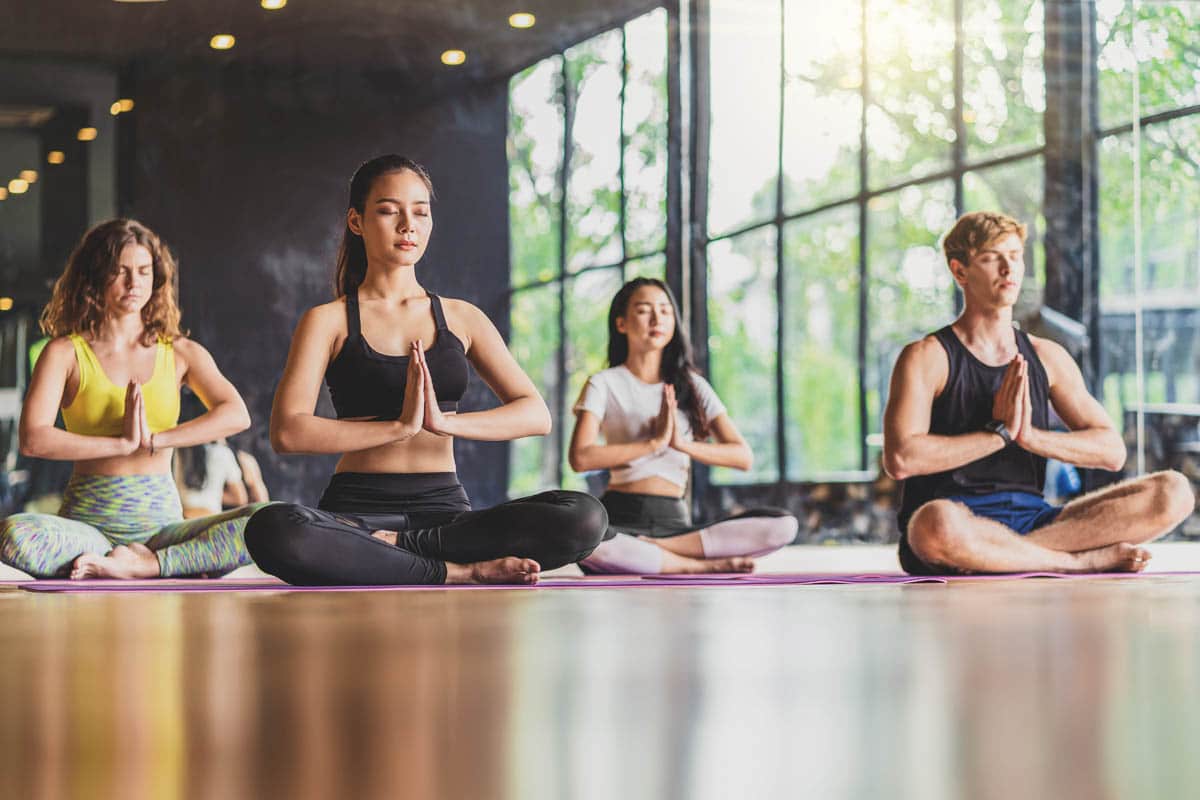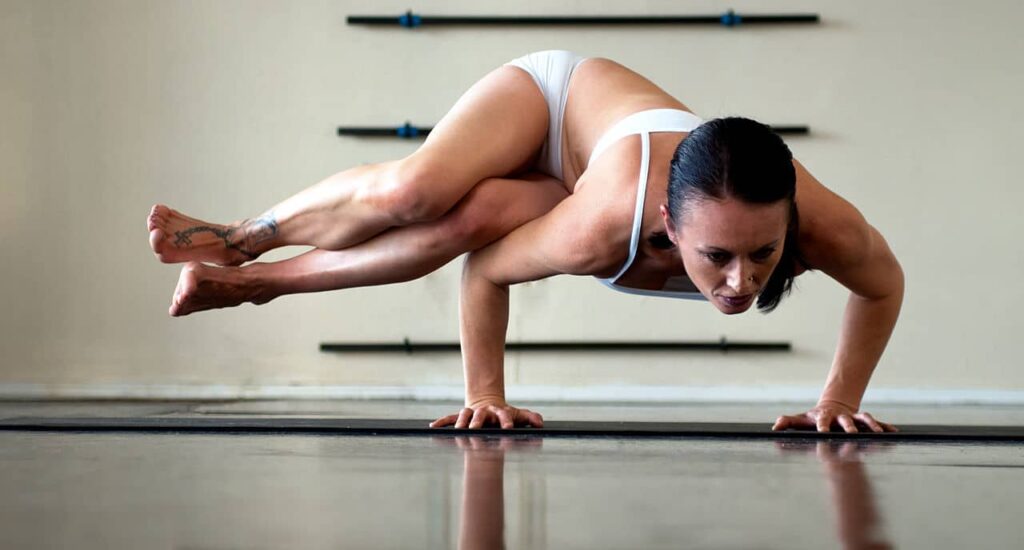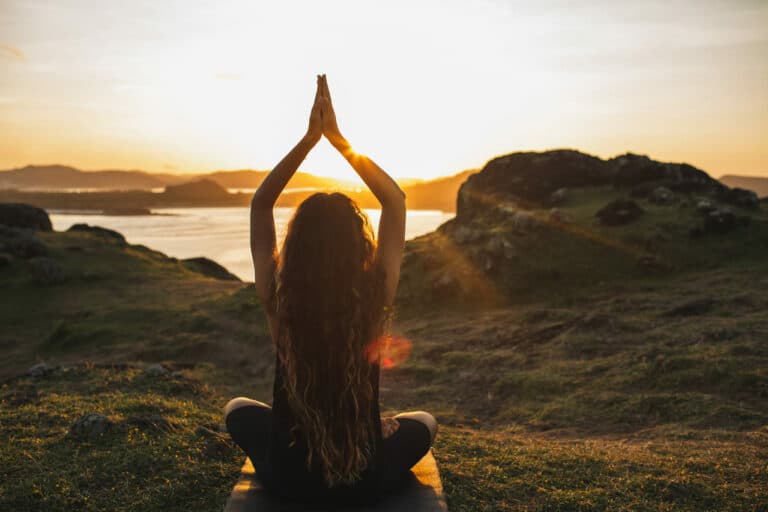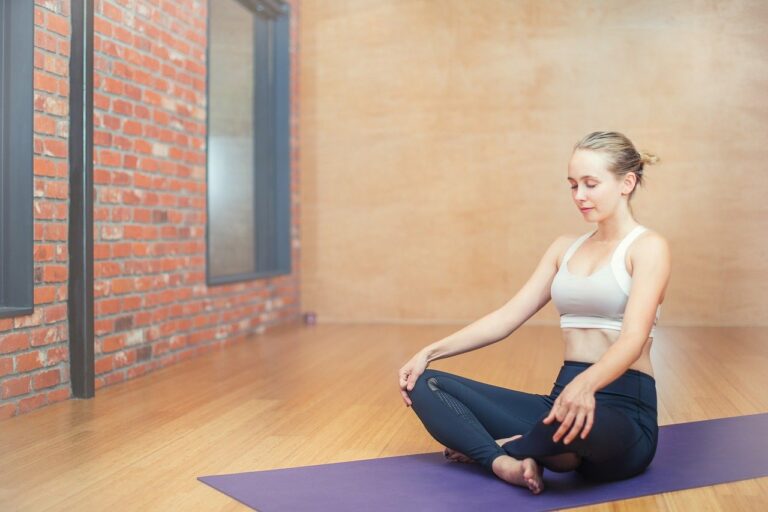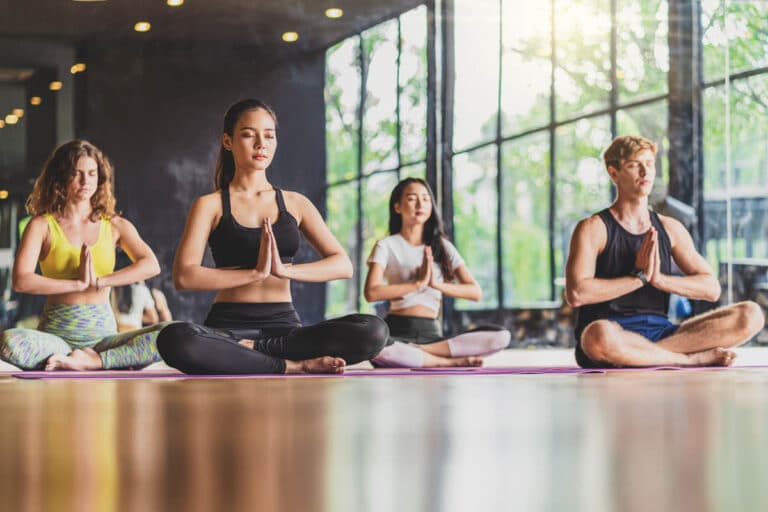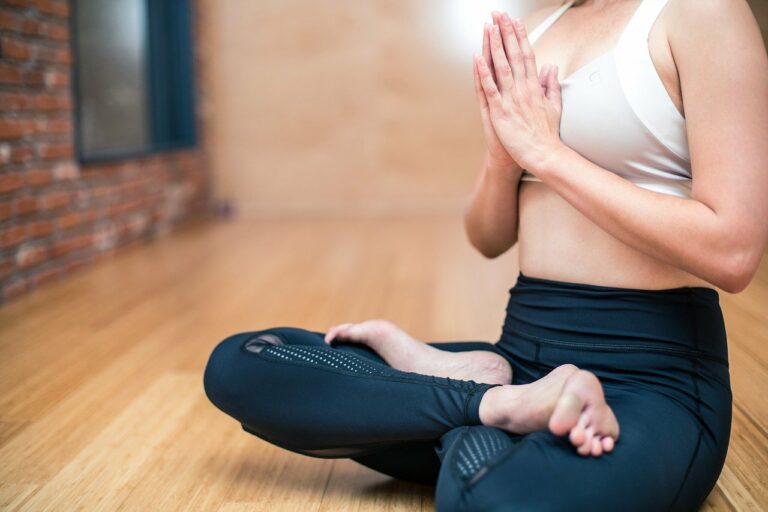Yoga has been practiced for thousands of years and is known for its numerous physical, mental, and spiritual benefits. The practice of yoga poses, also known as asanas, is a fundamental aspect of this ancient discipline.
Asanas are physical postures that focus on building strength, flexibility, balance, and mindfulness. They also have a variety of therapeutic benefits for the body and mind. But how many types of yoga asanas are there? In this blog post, we will share with you the complete list of yoga poses and their benefits. From beginner poses to more advanced ones, we have got you covered!
Key Takeaways:
- An asana is a body posture used in medieval hatha yoga and modern yoga.
- Patanjali Yoga Sutras defines “asana” as “to be seated in a position that is steady and comfortable.”
- The traditional number of asanas is 84, but different texts identify various postures.
- Yoga postures are categorized into standing, seated, supine, prone, and inverted poses.
How many Yoga Asanas are there?
According to ancient texts, such as the Hatha Yoga Pradipika, there are 84 asanas or poses that are considered fundamental. These asanas encompass a wide range of postures, including standing, seated, twisting, balancing, and inverted poses.
However, in contemporary yoga, there are around 200 recognized yoga poses. These include variations and modifications of the traditional asanas, allowing for greater diversity and adaptability in practice.
In yogic philosophy, it is believed that there are 84,000 energy channels in the human body, and each asana stimulates and harmonizes these channels to promote physical and mental well-being. Look at the below table of the complete asanas to get a better understanding.
| Asana | English Name | Type | Effect on Spine |
| Adho Mukha Shvanasana | Downward-Facing Dog | Standing | Forward Bend |
| Adho Mukha Vrikshasana | Downward-Facing Tree, Yoga Handstand | Balancing | – |
| Akarna Dhanurasana | Shooting Bow, Archer, Bow and Arrow | Sitting | – |
| Anantasana | Ananta’s Pose, Vishnu’s Couch Pose | Reclining | – |
| Anjaneyasana | Crescent Moon | Standing | Backbend |
| Ardha Chandrasana | Half Moon | Standing | – |
| Ashtanga Namaskara | Eight-Limbed Salutation, Caterpillar | Reclining | – |
| Astavakrasana | Aṣṭāvakra’s Pose, Eight-Angled | Balancing | – |
| Baddha Konasana | Bound Angle, Cobbler’s Pose | Sitting | – |
| Bakasana | Crane, Crow | Balancing | – |
| Balasana | Child | Sitting | – |
| Bhairavasana, Ankushasana | Formidable | Reclining | – |
| Bharadvajasana | Bharadvaja’s Twist | Sitting | Twist |
| Bhekasana | Frog | Reclining | Backbend |
| Bhujangasana | Cobra | Reclining | Backbend |
| Bhujapidasana | Arm-pressing Posture | Balancing | – |
| Bidalasana, Marjariasana | Cat | Kneeling | Backbend |
| Chaturanga Dandasana | Four-Limbed Staff, Low Plank | Reclining | – |
| Dandasana | Staff | Sitting | – |
| Dhanurasana | Bow | Reclining | Backbend |
| Durvasasana | Durvasa’s Pose | Standing, Balancing | – |
| Garbha Pindasana | Embryo in Womb | Sitting | – |
| Garudasana | Eagle | Standing, Balancing | – |
| Gomukhasana | Cow-faced | Sitting | – |
| Gorakshasana | Cowherd, Gorakhnath’s Pose | Sitting | – |
| Halasana | Plough | Inversion | Forward Bend |
| Hanumanasana | Hanuman’s Pose | Sitting | – |
| Janusirsasana | Head-to-Knee | Sitting | Forward Bend |
| Jathara Parivartanasana | Belly Twist | Reclining | Twist |
| Kapotasana | Pigeon | Kneeling | Backbend |
| Karnapidasana | Ear-pressing | Inversion | Forward Bend |
| Kaundinyasana | Kaundinya’s Pose | Balancing | – |
| Kraunchasana | Heron | Sitting | – |
| Kukkutasana | Cockerel | Balancing | – |
| Kurmasana | Tortoise | Sitting | Forward Bend |
| Lolasana | Pendant | Balancing | – |
| Makarasana | Crocodile | Reclining | – |
| Malasana | Garland | Squatting | Forward Bend |
| Mandukasana | Frog | Sitting | – |
| Marichyasana | Marichi’s Pose | Sitting | Twist |
| Matsyasana | Fish | Reclining | Backbend |
| Matsyendrasana | Lord of the Fishes | Sitting | Twist |
| Mayurasana | Peacock | Balancing | – |
| Muktasana | Liberated | Sitting | – |
| Natarajasana | Lord of the Dance, Dancer | Standing | Backbend |
| Navasana, Naukasana | Boat | Sitting | Forward Bend |
| Padmasana | Lotus | Sitting | – |
| Parighasana | Gate | Standing | – |
| Parshvakonasana | Side Angle | Standing | – |
| Parshvottanasana | Intense Side Stretch | Standing | – |
| Pashasana | Noose | Squatting | Twist |
| Paschimottanasana | Seated Forward Bend | Sitting | Forward Bend |
| Pincha Mayurasana | Feathered Peacock | Balancing | – |
| Prasarita Padottanasana | Wide Stance Forward Bend | Standing | Forward Bend |
| Rajakapotasana | King Pigeon | Sitting | Backbend |
| Shalabhasana | Locust | Reclining | Backbend |
| Sarvangasana | Shoulder Stand | Inversion | – |
| Samakonasana | Side Splits | Sitting | – |
| Shavasana | Corpse | Reclining | – |
| Setu Bandha Sarvangasana | Shoulder Supported Bridge | Inversion | Backbend |
| Siddhasana | Accomplished, The Adept’s Pose | Sitting | – |
| Simhasana | Lion | Sitting | – |
| Shirshasana, Kapalasana | Headstand, Yoga Headstand | Inversion | – |
| Sukhasana | Easy | Sitting | – |
| Supta Padangusthasana | Big Toe Supine | Reclining | – |
| Surya Namaskar | Salute to the Sun, Sun Salutation | Standing | Forward Bend, Backbend Sequence |
| Svastikasana | Auspicious, Lucky Mark | Sitting | – |
| Tadasana | Mountain | Standing | – |
| Tittibhasana | Firefly | Balancing | – |
| Trikonasana, Utthita Trikonasana | Triangle | Standing | – |
| Trivikramasana | Trivikrama’s Pose, Standing Splits | Standing, Balancing | – |
| Tulasana | Balance/Scales | Balancing | – |
| Upavishta Konasana | Open Angle | Sitting | – |
| Urdhva Dhanurasana, Chakrasana | Upwards-facing Bow, Wheel | Inversion | Backbend |
| Urdhva Mukha Shvanasana | Upward-Facing Dog | Reclining | Backbend |
| Ushtrasana | Camel | Kneeling | Backbend |
| Utkatasana | Awkward or Powerful | Standing | – |
| Uttanasana | Standing Forward Bend | Standing | Forward Bend |
| Utthita Hastapadangusthasana | Standing Big Toe Hold | Standing | – |
| Vajrasana | Thunderbolt | Kneeling | – |
| Vasishtasana | Vasishta’s Pose, Side Plank | Balancing | – |
| Viparita Dandasana | Inverted Staff | Inversion | Backbend |
| Viparita Karani | Legs Up the Wall | Inversion | – |
| Viparita Virabhadrasana | Reversed Warrior | Standing | – |
| Virabhadrasana I | Warrior I | Standing | – |
| Virabhadrasana II | Warrior II | Standing | – |
| Virabhadrasana III | Warrior III | Standing | – |
| Virasana, Dhyana Virasana | Hero, Hero’s Meditation | Kneeling | – |
| Vrikshasana | Tree | Standing, Balancing | – |
| Vrischikasana | Scorpion | Inversion | Backbend |
| Yoganidrasana, Pasini Mudra | Yogic Sleep, Noose Mudra | Reclining | Forward Bend |
Complete Types Of Asanas Are There in Yoga
Though there are many different Asanas in yoga and Patanjali describes asanas as “to be seated in a position that is steady and comfortable,” and the physical practice of yoga is commonly understood as the practice of asanas, there are other aspects to consider. Yoga also involves breathing exercises (pranayama), meditation, and ethical practices. Below are some of the most common types of asanas in yoga:
1. Adho Mukha Shvanasana
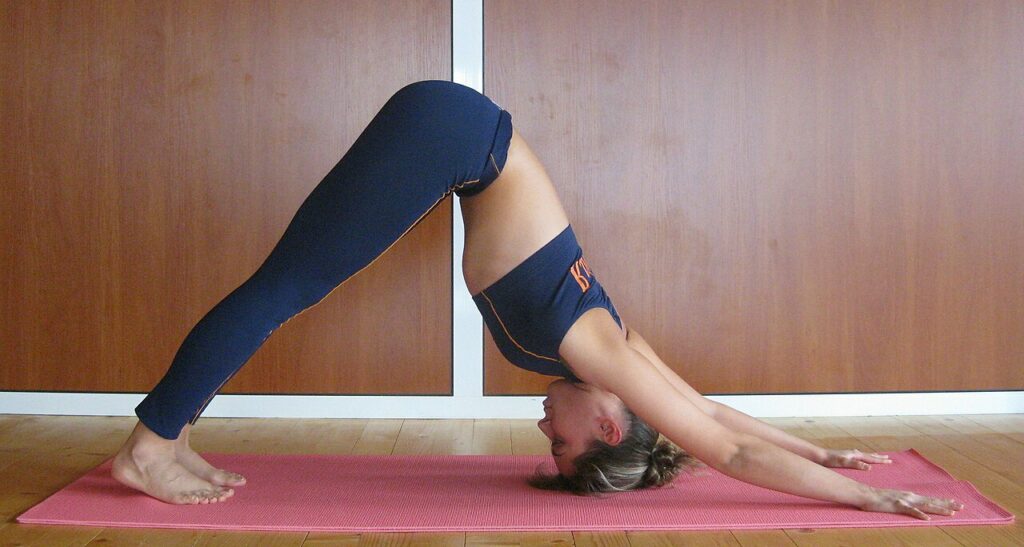
Image Credit: wikimedia
Adho Mukha Svanasana, also called Downward-Facing Dog Pose, is a basic yoga asanas commonly practiced in a sequence of poses. It is also great for building strength in the arms, legs, and core. This is one of the basic asanas in Surya Namaskar (Sun Salutation). In yoga philosophy, the Downward-Facing Dog pose is believed to calm the mind and relieve stress and anxiety.
How do it?
- Assume a tabletop position, positioning yourself on all fours.
- Align your hands and knees, forming the base of the table, while keeping your back straight.
- Exhale as you lift your hips upward, extending your knees and elbows simultaneously.
- Create a V-shape with your body, forming an inverted “V” pose.
- Make sure your upper body is aligned with your lower body, avoiding any hunching or rounding of the back.
- Hold this pose for a few breaths, and then gently release by exhaling as you return to the tabletop position.
Benefits of doing Adho Mukha Shvanasana
- Improves blood flow
- Relieves Tension
- Energizes the body
- Strengthens arms and legs
2. Adho Mukha Vrikshasana
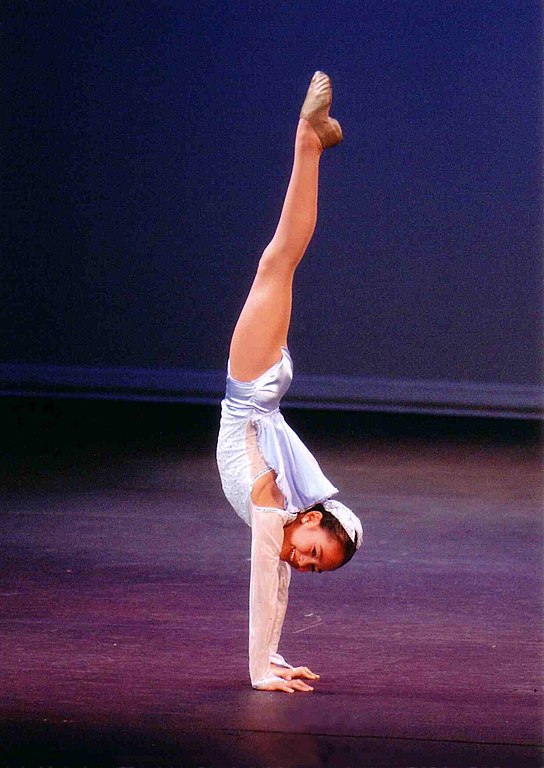
Image Credit: wikimedia
Adho Mukha Vrikshasana, commonly known as the Downward-Facing Tree or Yoga Handstand, is an advanced yoga pose that involves balancing the body on your hands with your feet lifted in the air. This pose requires a lot of strength and stability in the upper body, making it a great exercise for building arm and core strength. This yoga practice can also help improve balance and focus, as well as relieve stress and anxiety.
How do it?
- Begin by standing with your feet hip-width apart.
- Place your hands on the ground slightly wider than shoulder-width apart.
- Gently bend forward, placing the crown of your head on the mat in front of you.
- Slowly lift one leg off the ground and bring it closer to your chest.
- Once you feel stable, use your core strength to lift the other leg off the ground.
- Hold this pose for a few breaths, then gently release by bringing one foot back to the ground at a time.
Benefits of doing
- Improves balance and focus
- Strengthens upper body muscles
- Stimulating the endocrine system
- Relieving minor depression
3. Akarna Dhanurasana
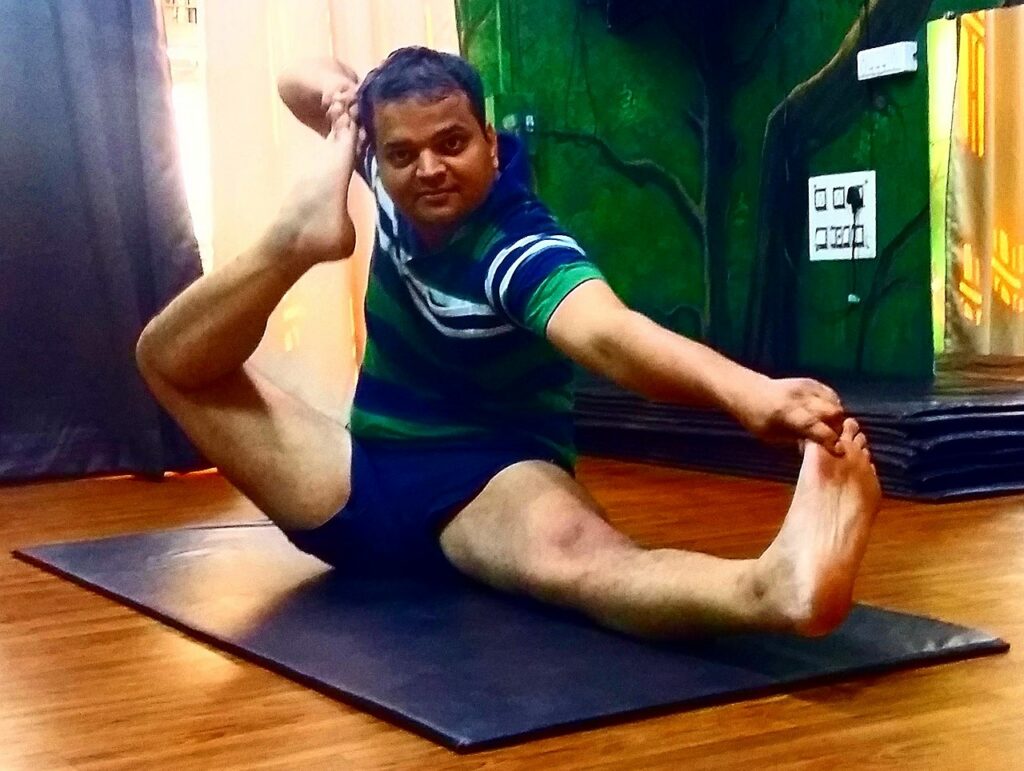
Image Credit: wikimedia
Akarna Dhanurasana, also referred to as the Archer’s pose, Bow and Arrow pose, or Shooting Bow pose, is an intermediate-level seated yoga posture. Its name originates from Sanskrit, where “Karna” signifies “ear,” “Dhanu” signifies “bow,” and “Asana” signifies “posture/pose.” This asana stretches the hips, hamstrings, and quadriceps while improving balance and focus. It is also believed to stimulate the Manipura chakra (solar plexus) and activate digestion.
How do it?
- Begin by sitting on the floor.
- Extend your legs straight in front of you.
- Bend forward and reach your arms to hold onto your toes.
- Maintain an upright torso as much as possible.
- Inhale deeply.
- Lift your left foot towards your left ear while still holding onto the other leg.
- Sustain the pose.
- Repeat the movement on the opposite side.
Benefits of doing Akarna Dhanurasana
- Improved digestion by regulating digestive juices
- Enhanced flexibility in the spine and hips.
- Increased efficiency of the heart.
- Boosted blood circulation to the knees, hips, abdomen, and back.
4. Anantasana
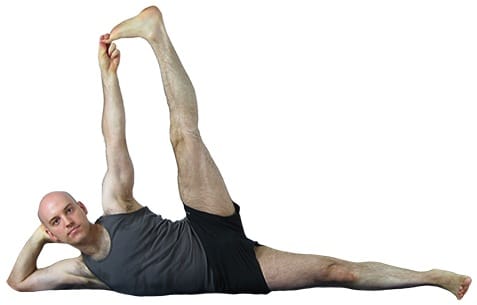
Image Credit: wikimedia
Anantasana, also called the Sleeping Vishnu Pose, is a yoga asanas where you recline on one side of your body. It is a great pose for stretching the whole body, especially the hips and hamstrings. This asana in yoga describes the sleeping posture of Lord Vishnu and symbolizes his quality of relaxation. The pose can help calm the mind and improve flexibility.
How do it?
- Begin by lying on your side.
- Use one forearm to support your head.
- Extend the opposite arm and leg vertically towards the ceiling.
- Securely grip your big toe with your fingers.
Benefits of doing Anantasana
- Stretches hips and hamstrings
- Improves flexibility
- Calms the mind and body
- Helps with insomnia and sleep disorders
5. Anjaneyasana
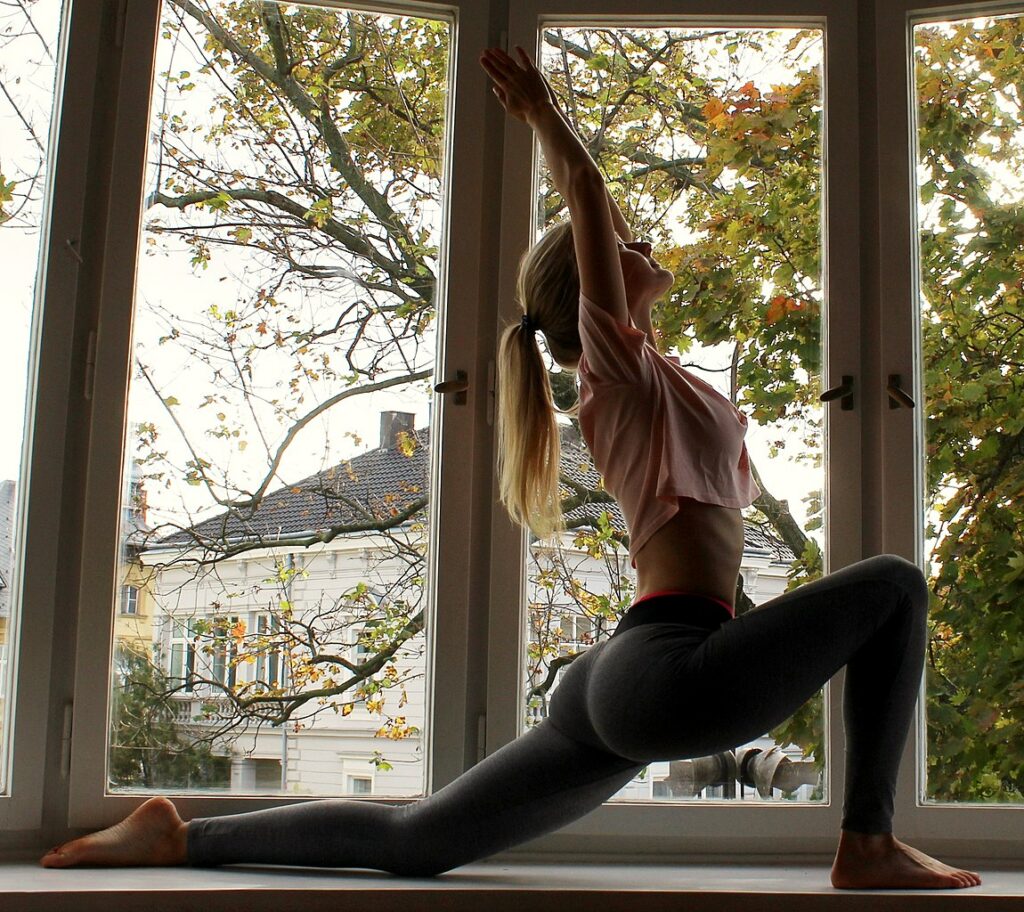
Image Credit: wikimedia
Anjaneyasana, also known as the Low Lunge or Crescent Moon Pose, is a beginner-friendly yoga pose that focuses on stretching and strengthening the lower body. This pose can help improve flexibility in the hips, thighs, and groin area. It can also help relieve tension in the lower back and increase energy levels.
How do it?
- Begin in a tabletop position with your hands and knees aligned.
- Bring one foot forward between your hands, keeping the knee directly above the ankle.
- Lower your back leg to the ground, resting your toes on the mat.
- Slowly lift your torso up, stretching your arms upward towards the ceiling.
- Make sure to keep your front knee at a 90-degree angle and your back leg straight.
Benefits of doing Anjaneyasana
- Stretches lower body muscles
- Improves balance and core strength
- Relieves tension in the lower back
- Increases energy levels
6. Ardha Chandrasana
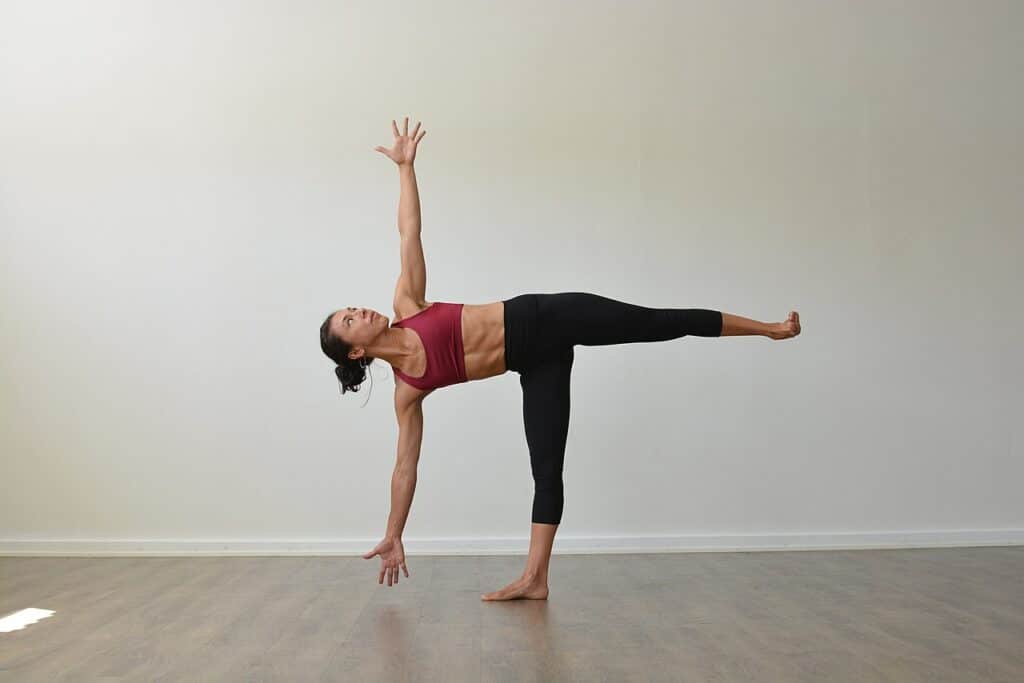
Image Credit: wikimedia
Ardha Chandrasana, also known as the Half Moon Pose, is an intermediate-level yoga asanas that focuses on balance and strengthening the legs. This pose also helps improve focus and concentration while stretching the hamstrings and opening up the chest and shoulders. This is one of the challenging standing poses that targets the physical body.
How do it?
- Begin in a standing position with your feet together.
- Slowly shift your weight onto one leg, lifting the other leg off the ground.
- Reach down to touch the ground while extending your lifted leg behind you.
- Bring your torso parallel to the ground and extend your arms out to the sides.
- Hold this position for a few breaths, then gently release by bringing your lifted leg back to the ground and standing upright.
Benefits of doing Ardha Chandrasana
- Improves balance and focus
- Stretches the hamstrings and calves
- Strengthens legs and core muscles
- Opens up chest and shoulders.
7. Ashtanga Namaskara
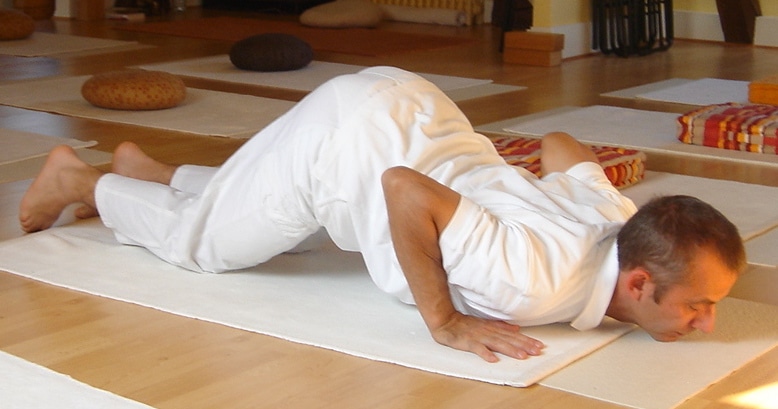
Image Credit: wikimedia
Ashtanga Namaskara, also called the Eight-Limbed Salutation, is a yoga pose in the Sun Salutation series. It’s the sixth pose in the sequence. The physical dimension of Ashtanga Namaskara works on the strength of the arms, shoulders, and abdomen. In yoga philosophy, this pose is believed to represent surrender and gratitude towards all eight limbs of yoga.
How do it?
- Begin by lying flat on your stomach with your feet together and toes pointing outward.
- Place your palms beside your chest, keeping your elbows close to your body.
- Inhale and lift your head, chest, and thighs off the ground.
- Exhale as you lower your forehead to the ground while bending your arms at the elbows and resting on your hands.
- Hold this pose for a few breaths, then gently release by straightening your arms and lowering back down to the ground.
Benefits of doing Ashtanga Namaskara
- Strengthens arms, shoulders, and abdomen
- Reduce stress
- Spinal muscles are strengthened
- Balance is improved
8. Astavakrasana
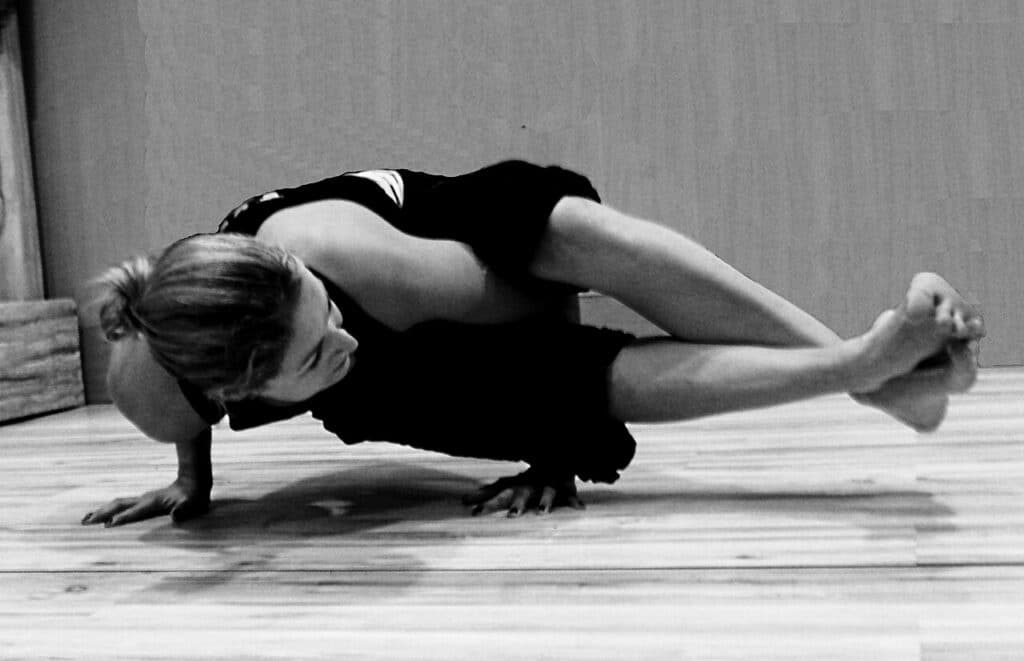
Image Credit: wikimedia
Astavakrasana, also known as Eight-Angle Pose, is a challenging arm-balancing asana that requires strength and flexibility. This classical yoga pose involves sitting with one leg crossed over the other and twisted, creating a foundation for the arms to support the body. The pose is named after Ashtavakra, a sage in Hindu mythology born with eight deformities.
How do it?
- Begin in a seated position with your legs extended.
- Bend your right knee and cross it over your left leg, placing the foot on the floor.
- Thread your right arm through the space between your right thigh and calf.
- Plant both hands on the ground, shoulder-width apart.
- Lean forward, lifting your hips, and hook your left ankle over the right ankle.
- Shift your weight onto your hands, extending the legs parallel to the ground.
- Hold the pose, engaging your core and breathing steadily.
- Repeat on the other side.
Benefits of doing Astavakrasana
- Strengthens arms, wrists, and core muscles.
- Improves blood circulation
- Enhances flexibility in the hips and spine.
- Massages and stimulates the abdominal muscles.
9. Baddha Konasana
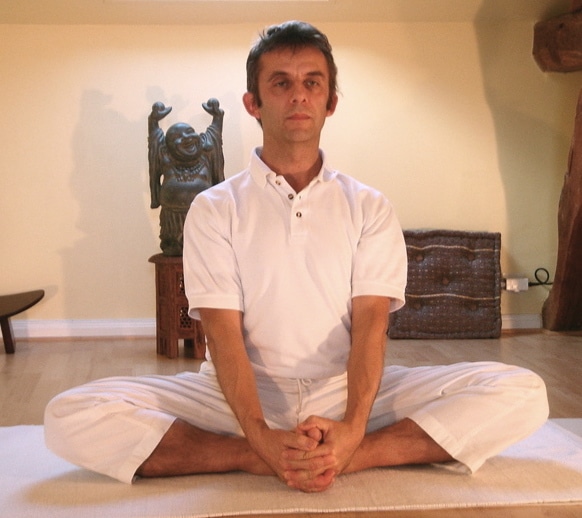
Image Credit: wikimedia
Baddha Konasana or Bhadrasana, also called Bound Angle Pose, Butterfly Pose, or Cobbler’s Pose, is a seated yoga asana. This Sivananda yoga asanas involves bringing the soles of the feet together in front of the body, creating a diamond shape with the legs. For your physical health, this pose is said to help stretch the inner thighs, groin, and knees.
How do it?
- Sit with a straight spine and legs extended.
- Bend your knees, bringing the soles of your feet together.
- Hold your feet with your hands and bring them as close to your pelvis as comfortable.
- Allow your knees to drop towards the floor.
- Maintain an upright posture and gently press your knees toward the ground.
- Hold the pose, proper breathing deeply, and relax into the stretch.
Benefits of doing Baddha Konasana
- Stretches and opens the hips and groin.
- Stimulates abdominal muscles.
- Alleviates sciatica discomfort.
- Relieves stress and anxiety.
10. Bakasana
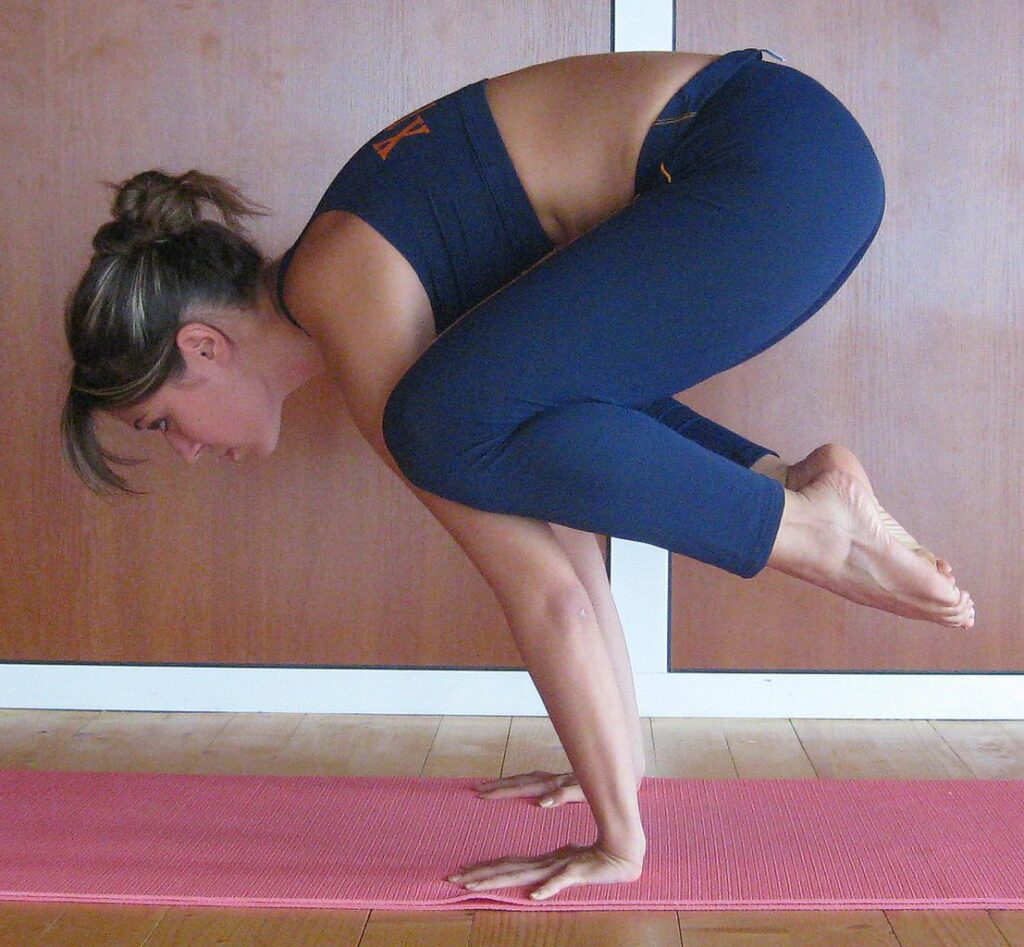
Image Credit: wikimedia
Bakasana or Kakasana, also known as Cane or Crow Pose, is an arm-balancing asana that builds strength and balance. The name comes from Sanskrit: baka means “crane” and asana means “pose”. This physical body-focused pose involves balancing the body on the hands with the knees resting on the back of the arms.
How do it?
- Begin in a squatting position with your feet close together.
- Place your hands on the floor shoulder-width apart, fingers spread.
- Bend your elbows slightly, bringing your knees to the backs of your arms.
- Shift your weight forward, lifting your feet off the ground.
- Engage your core, straighten your arms, and lift your feet higher.
- Focus on a point on the floor to maintain balance.
- Hold the pose, breathing steadily.
Benefits of doing Bakasana
- Strengthens wrists, arms, and core muscles.
- Improves balance and concentration.
- Aids digestion.
- Enhances mental focus and determination.
11. Balasana
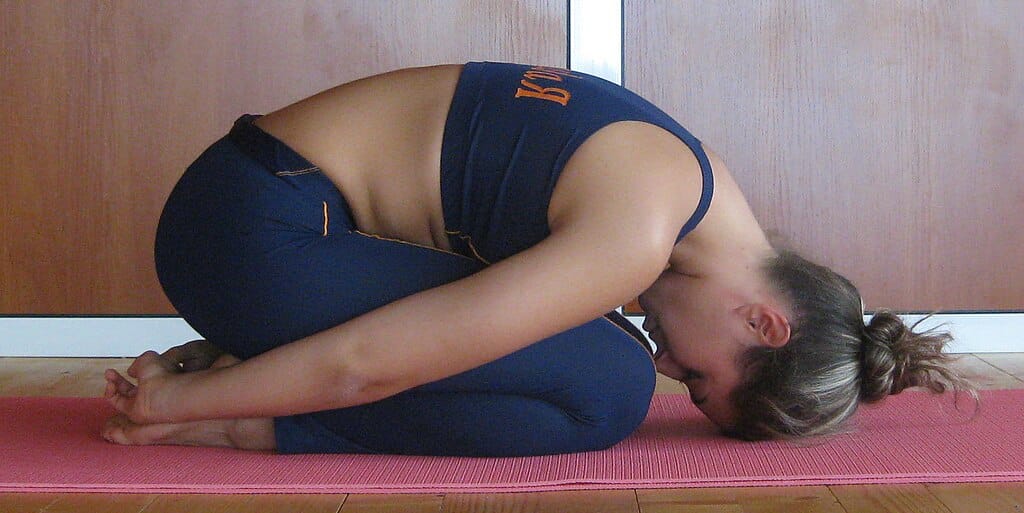
Image Credit: wikimedia
Balasana, also known as Child’s Pose, is a restorative seated asana that provides a gentle stretch to the back and hips. This yoga pose involves kneeling on the mat, sitting back on the heels, and reaching forward with the arms while resting the forehead on the ground.
How do it?
- Begin in a kneeling position on the mat.
- Sit back on your heels, bringing the big toes to the touch.
- Extend your arms forward and lower your chest towards the mat.
- Rest your forehead on the ground, and extend your arms or bring them alongside your body.
- Relax in this pose, breathing deeply and feeling a gentle stretch in the back.
Benefits of doing Balasana
- Relieves back and neck pain.
- Stretches and relaxes the spine.
- Calms the mind.
- Reduces stress.
12. Bhairavasana
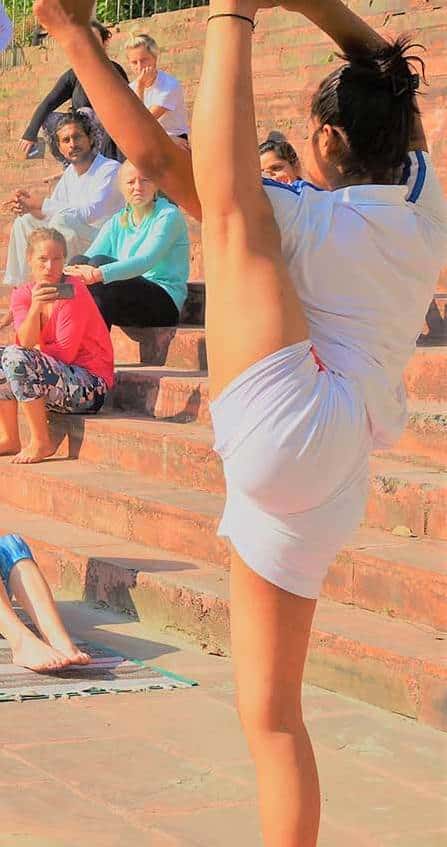
Image Credit: wikimedia
Bhairavasana or Ankushasana, also known as Lord Bhairava’s Pose, is an advanced seated asana that challenges balance and flexibility. This asana involves sitting on one heel while extending the opposite leg straight out to the side, with the arms in a specific mudra. If you’re on an empty stomach, you can do this pose at any time during your yoga practice as a way to rest and reset.
How do it?
- Begin in a seated position with legs extended.
- Bend your right knee, bringing the heel towards the perineum.
- Extend the left leg out to the side, foot flexed.
- Place your left hand on the mat and reach the right arm behind your back.
- Bind the hands or use a strap to connect them.
- Engage the core and balance on the seated heel.
- Repeat on the other side.
Benefits of doing Bhairavasana
- Strengthens the core and lower back.
- Enhances concentration and focus.
- Encourages a sense of balance and stability.
13. Bharadvajasana
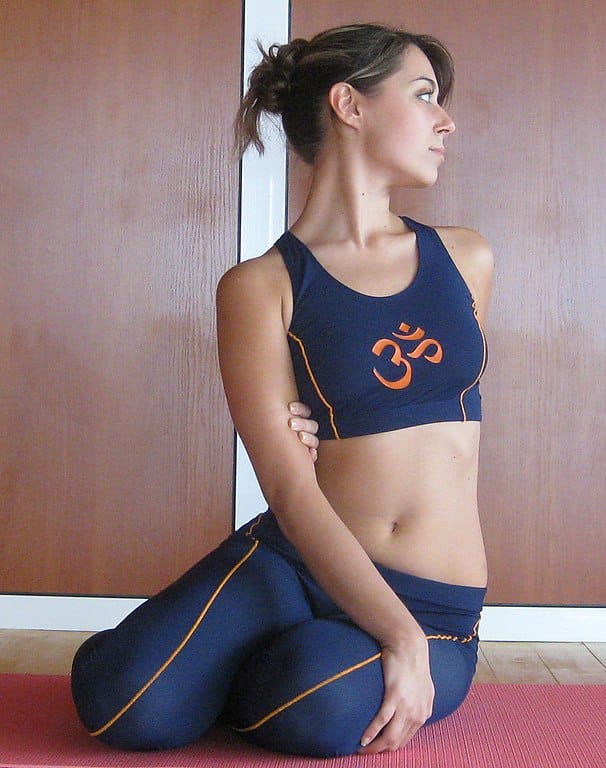
Image Credit: wikimedia
Bharadvajasana, named after the sage Bharadvaja, is a seated twist that promotes spinal flexibility and detoxification. This asana involves sitting with legs extended, twisting the torso to one side while grounding the opposite hand. To make your spinal system youthful, you can practice this pose regularly.
How do it?
- Start in a seated position with legs extended.
- Bend your knees and shift them to one side.
- Place the right hand behind you and hug the left knee with the left arm.
- Twist the torso to the left, looking over the left shoulder.
- Hold the pose, keeping the spine tall.
- Repeat on the other side.
Benefits of doing Bharadvajasana
- Increases spinal flexibility.
- Massages abdominal muscles
- Relieves lower back pain.
- Improves digestion.
14. Bhekasana
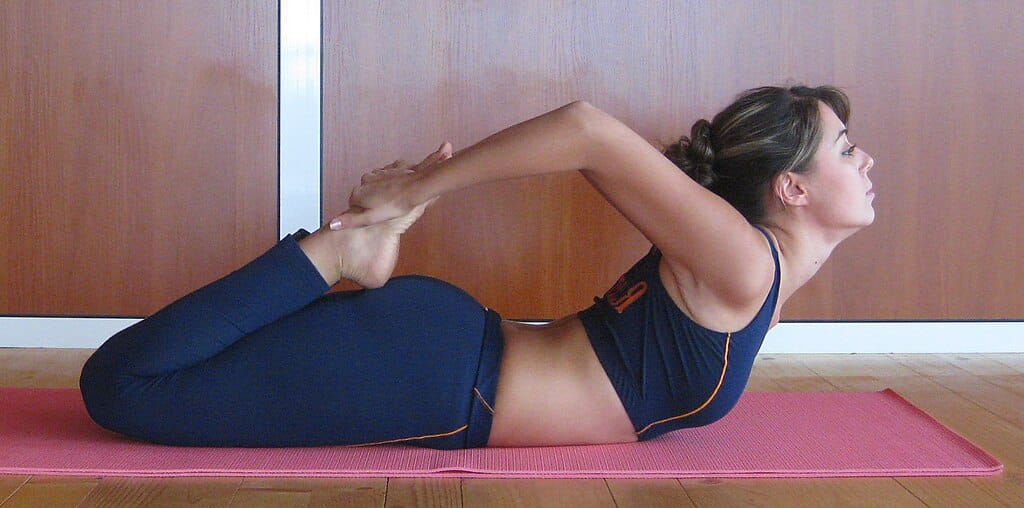
Image Credit: wikimedia
Bhekasana, also known as Frog Pose, is a prone backbend that targets the quadriceps and hip flexors. This asana involves lying on the stomach, bending the knees, and reaching back to hold the ankles while lifting the chest and thighs off the mat. This balancing pose can help improve posture and relieve tension in the hips, lower back, and neck.
How do it?
- Lie on your stomach with your chin on the mat.
- Bend your knees and bring them wider than hip-width apart.
- Reach back and hold onto your ankles.
- Inhale, lifting your chest and thighs off the mat.
- Press the feet towards the ceiling.
- Hold the pose, breathing deeply.
- Release and rest on your stomach.
Benefits of doing Bhekasana
- Strengthening the back muscles
- Improving posture
- Stimulates abdominal organs and aids digestion.
15. Bhujangasana
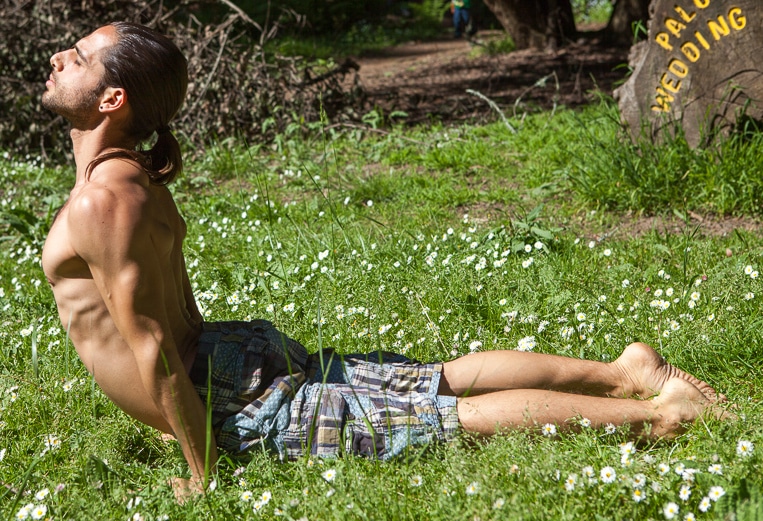
Image Credit: wikimedia
Bhujangasana, also known as Cobra Pose, is a backbend that strengthens the spine and opens the chest. This prone asana involves lying on the stomach, placing the palms near the chest, and lifting the upper body while keeping the lower body grounded. Also, seated asanas such as Bhujangasana stimulate the Manipura (solar plexus) Chakra and can help improve digestion.
How do it?
- Lie on your stomach with your legs extended.
- Place your palms near your chest, elbows bent.
- Inhale, lifting your chest off the mat, keeping the lower body grounded.
- Straighten your arms, arching your back and looking up.
- Lower back down on the exhale.
Benefits of doing Bhujangasana
- Strengthens the spine and back muscles.
- Opens the chest and improves lung capacity.
- Stimulates abdominal organs and aids digestion.
- Alleviates stress and fatigue.
16. Bhujapidasana
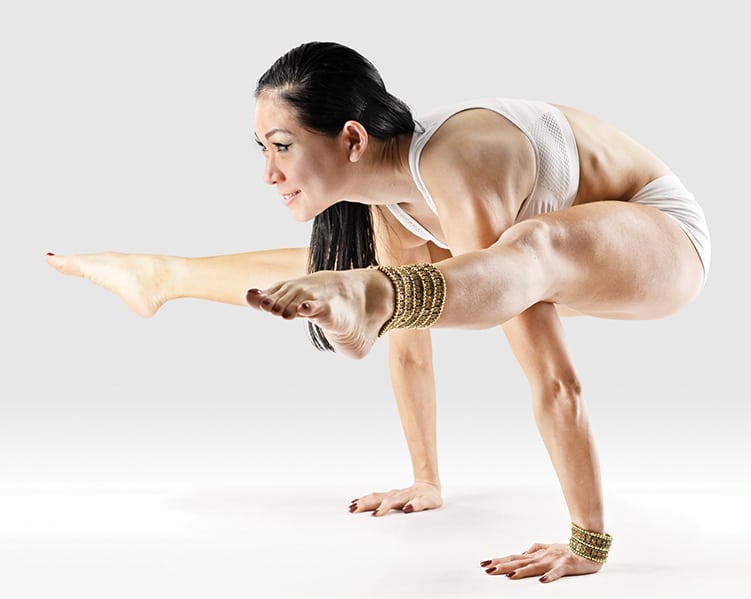
Image Credit: wikimedia
Bhujapidasana, also known as Shoulder-Pressing Pose, is an arm-balancing asana that challenges strength and balance. This is an intermediate-to-advanced yoga asanas. This pose involves squatting, placing the hands on the mat between the legs, and lifting the feet off the ground while balancing on the hands.
How do it?
- Begin in a squatting position with your feet close together.
- Place your hands on the mat between your legs, fingers spread.
- Lift your heels off the ground and balance on the balls of your feet.
- Shift your weight forward, bringing your knees to the backs of your arms.
- Lean forward, lifting your feet off the ground.
Benefits of doing Bhujapidasana
- Strengthens wrists, arms, and core muscles.
- Improves balance and concentration.
- Tones abdominal organs and aids digestion.
- Enhances mental focus and determination.
17. Bidalasana
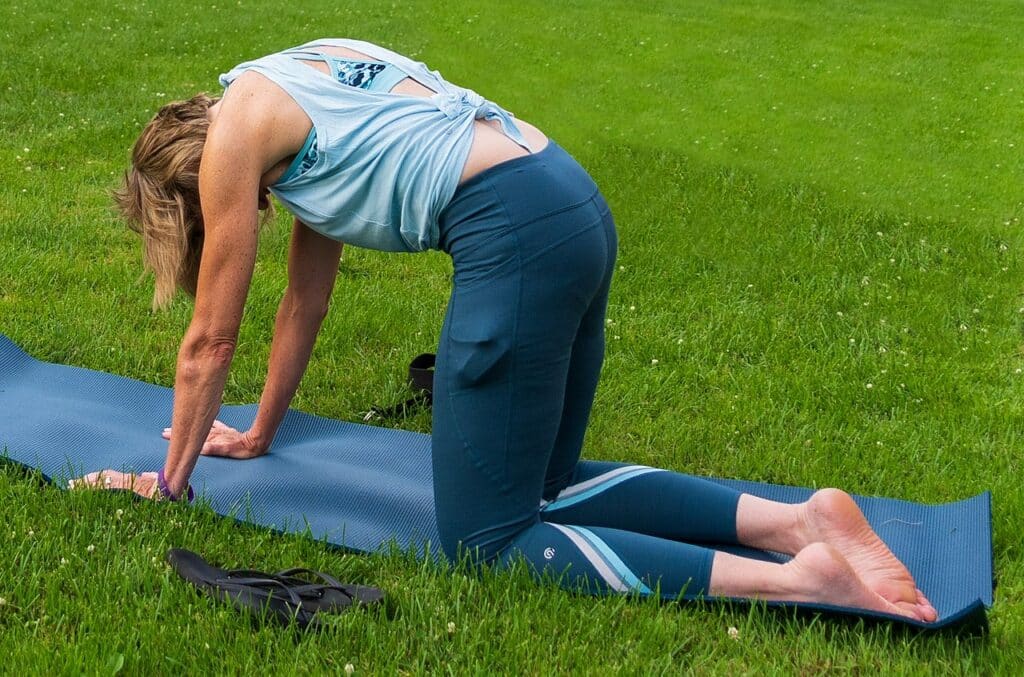
Image Credit: wikimedia
Bidalasana or Marjariasana, also known as Cat Pose, is a dynamic yoga flow that involves moving between a rounded back (Cat Pose) and an arched back (Cow Pose). This asana is often used in yoga warm-up sequences to increase spinal flexibility and relieve tension in the neck and shoulders.
How do it?
- Start on your hands and knees in a tabletop position.
- Inhale, arch your back, and lift your head and tailbone (Cow Pose).
- Exhale, round your back, tuck your chin to your chest (Cat Pose).
- Repeat this flowing motion, synchronizing breath with movement.
Benefits of doing Bidalasana
- Increases spinal flexibility and mobility.
- Strengthens and tones the core muscles.
- Improves posture and balance.
- Promotes relaxation and reduces stress.
18. Chaturanga Dandasana
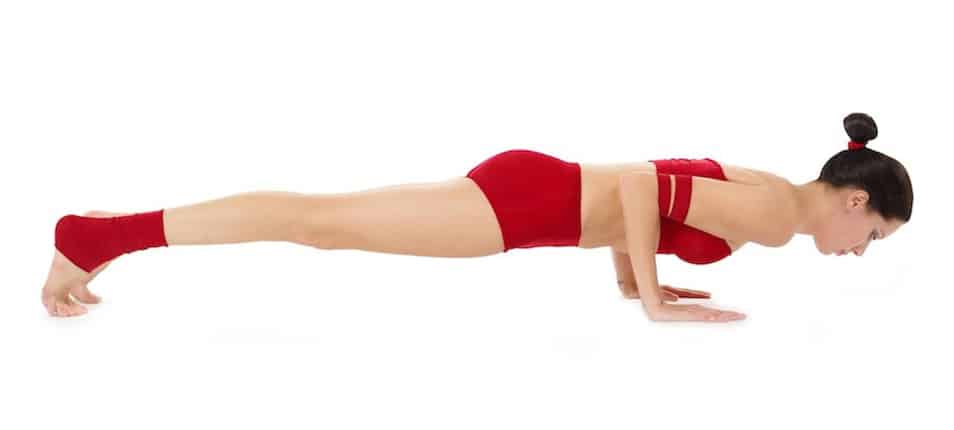
Image Credit: wikimedia
Chaturanga Dandasana, also known as Four-Limbed Staff Pose or Low Plank, is a challenging and powerful yoga asanas that requires strength, balance, and control. It is often incorporated into flow sequences or used as a transition pose in between other poses. This pose engages the entire body, strengthening the arms, shoulders, chest, core, and legs.
How do it?
- Begin in a plank pose with your arms extended, hands shoulder-width apart.
- Slowly lower your body down, keeping your elbows close to your sides and bending them at 90 degrees.
- Keep your body parallel to the ground, engaging your core muscles.
- Hold this pose for a few breaths, then gently lower your body to the ground to release.
Benefits of doing Chaturanga Dandasana
- Builds upper body strength
- Engages the core muscles
- Increases stability and control
- Helps improve posture
19. Dandasana
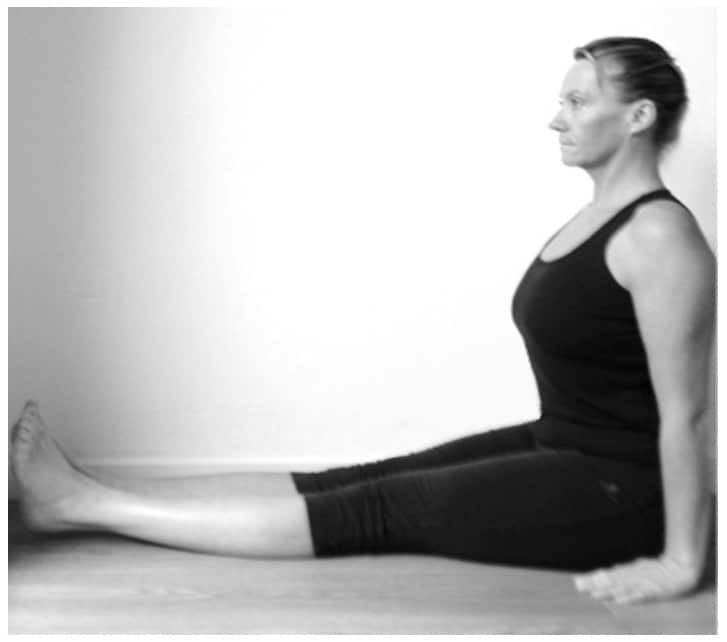
Image Credit: wikimedia
Dandasana, or Staff Pose, is a foundational seated asana that promotes posture and spinal alignment. This yoga squat pose involves sitting with legs extended, feet flexed, and the spine tall. This pose can be challenging for those with tight hamstrings, but it offers numerous health benefits, including improving posture and strengthening the deep back muscles.
How do it?
- Sit on the mat with your legs extended in front of you.
- Press your palms into the mat beside your hips.
- Flex your feet, engaging the leg muscles.
- Lengthen the spine, keeping the chest open.
- Hold the pose, breathing deeply, and maintaining an upright posture.
Benefits of doing Dandasana
- Strengthens the muscles of the back and legs.
- Improves posture and alignment.
- Stretches and tones the muscles of the abdomen.
- Enhances concentration and focus.
20. Dhanurasana
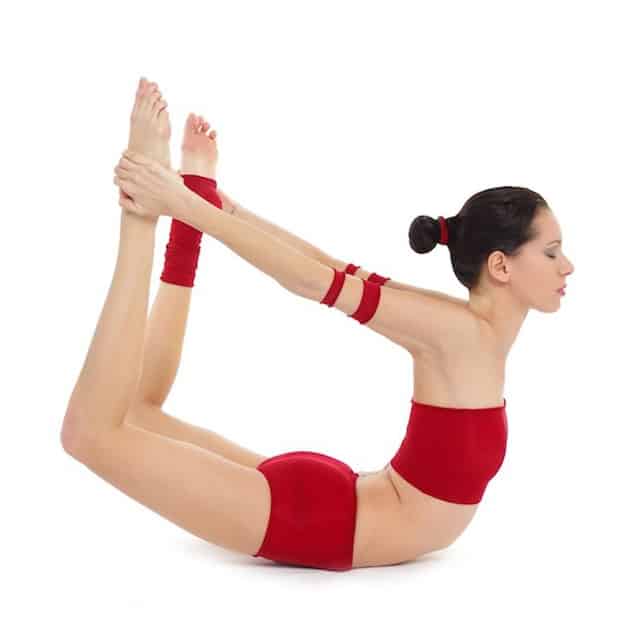
Image Credit: wikimedia
Dhanurasana, or Bow Pose, is a dynamic backbend that opens the chest and strengthens the back. The name originates from Sanskrit, combining “dhanur” meaning bow and “asana” meaning posture. This asana involves lying on the stomach, bending the knees, and reaching back to hold the ankles, resembling a bow.
How do it?
- Lie on your stomach with your legs extended.
- Bend your knees, bringing them towards your buttocks.
- Reach back and hold onto your ankles.
- Inhale, lifting your chest and thighs off the mat.
- Extend the legs upward, creating a bow shape.
- Hold the pose, breathing deeply.
- Release and rest on your stomach.
Benefits of doing Dhanurasana
- Stretches and opens the chest and shoulders.
- Strengthens the back muscles and spine.
- Stimulates the digestive organs.
- Improves posture and alleviates fatigue.
21. Durvasasana
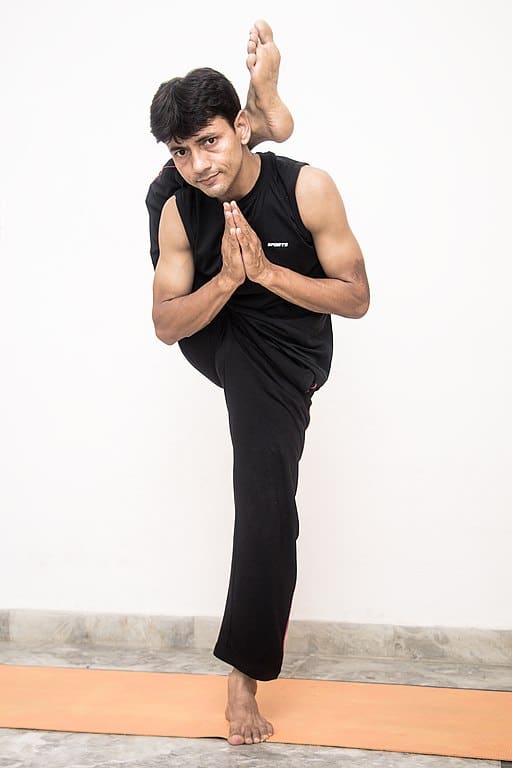
Image Credit: wikimedia
Durvasasana, named after the sage Durvasa, is an advanced balancing asana that challenges stability and focus. This pose involves standing on one leg, while the other leg is extended forward with the foot flexed. The arms are also extended forward, parallel to the ground.
How do it?
- Begin in a standing position with feet hip-width apart.
- Shift your weight onto one leg and lift the other leg forward.
- Hold the lifted leg with both hands, keeping it straight.
- Engage your core and find a focal point for balance.
- Hold the pose, breathing steadily.
- Repeat on the other leg.
Benefits of doing Durvasasana
- Improves balance and concentration.
- Strengthens the legs and core muscles.
- Enhances mental focus and stability.
- Tones and stretches the hip flexors.
22. Garbha Pindasana
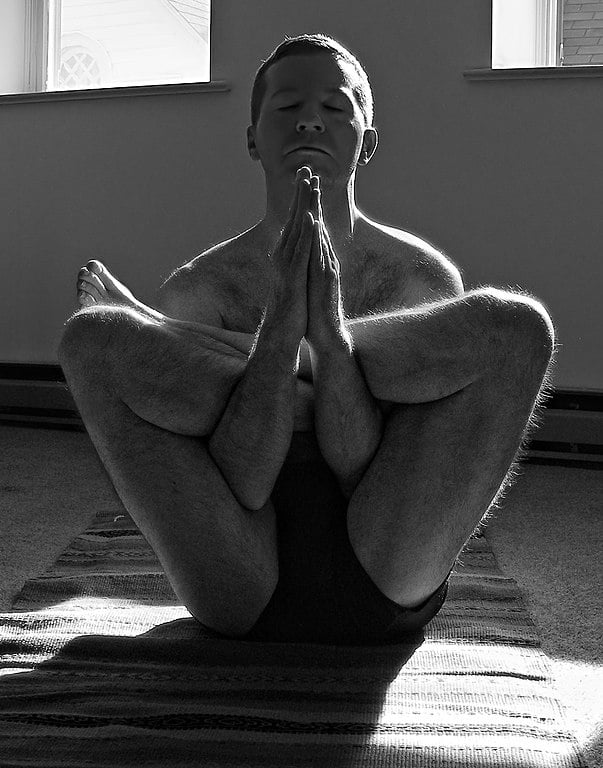
Image Credit: wikimedia
Garbha Pindasana, or Embryo in the Womb Pose, is an advanced yoga asana that combines balancing and twisting. This pose involves sitting in a lotus position and wrapping the arms around the legs, creating a compact and rounded shape resembling an embryo. You can take the help of yoga teacher training to learn this asana.
How do it?
- Sit in Padmasana (Lotus Pose) with both legs crossed.
- Wrap your arms around your back and clasp your hands.
- Lift your feet off the ground, balancing on your sitting bones.
- Bring your forehead towards your knees.
- Hold the pose, breathing deeply.
- Release and extend the legs to rest.
Benefits of doing Garbha Pindasana
- Strengthens the core and abdominal muscles.
- Improves balance and stability.
- Stretches and tones the hips and groin.
- Massages and stimulates abdominal organs.
23. Garudasana
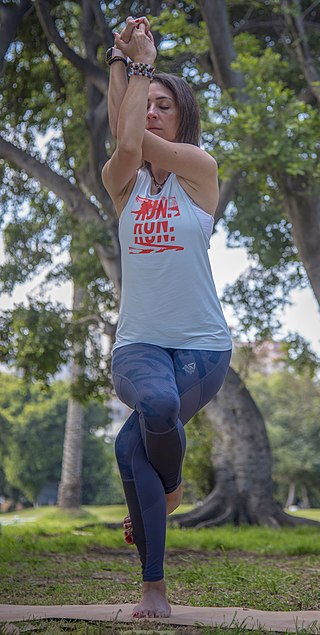
Image Credit: wikimedia
Garudasana, or Eagle Pose, is a standing balance pose that combines strength and flexibility. The name originates from Sanskrit: Garuda, meaning “eagle,” and Asana, meaning “posture”. This asana involves wrapping one leg around the other and crossing the arms at the elbows.
How do it?
- Stand with your feet hip-width apart.
- Lift your right leg and cross it over the left thigh.
- Wrap the right foot behind the left calf.
- Cross your left arm over the right, bringing the palms together.
- Bend your knees slightly and sink into the pose.
- Hold the position, breathing deeply.
- Repeat on the other side.
Benefits of doing Garudasana
- Improves balance and concentration.
- Stretches and strengthens the ankles and calves.
- Opens the shoulders and upper back.
- Enhances flexibility in the hips and thighs.
24. Gomukhasana
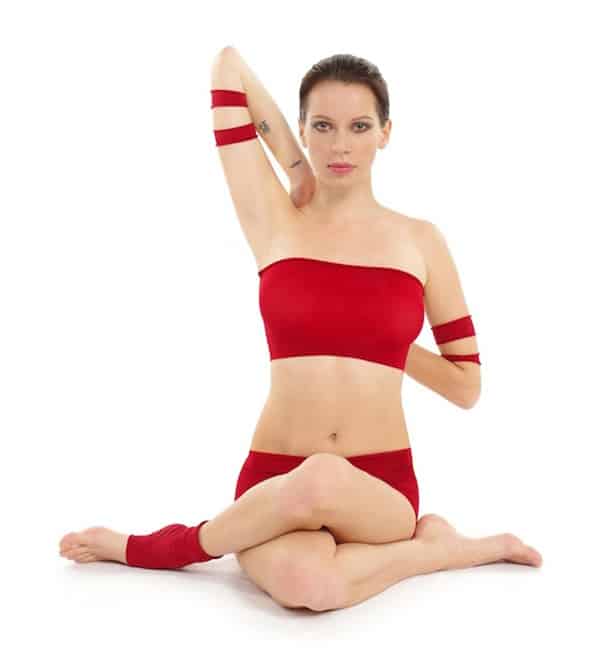
Image Credit: wikimedia
How do it?
- Sit with your legs extended and spine tall.
- Bend your knees and bring your left foot under your right hip.
- Stack your right knee over the left knee.
- Extend your right arm overhead, bending the elbow.
- Reach your left arm behind your back, bending the elbow.
- Clasp your fingers or use a strap to connect the hands.
Benefits of doing Gomukhasana
- Stretches and opens the shoulders and chest.
- Improves flexibility in the hips and thighs.
- Alleviates tension in the upper back and neck.
- Enhances posture and alignment.
25. Gorakshasana
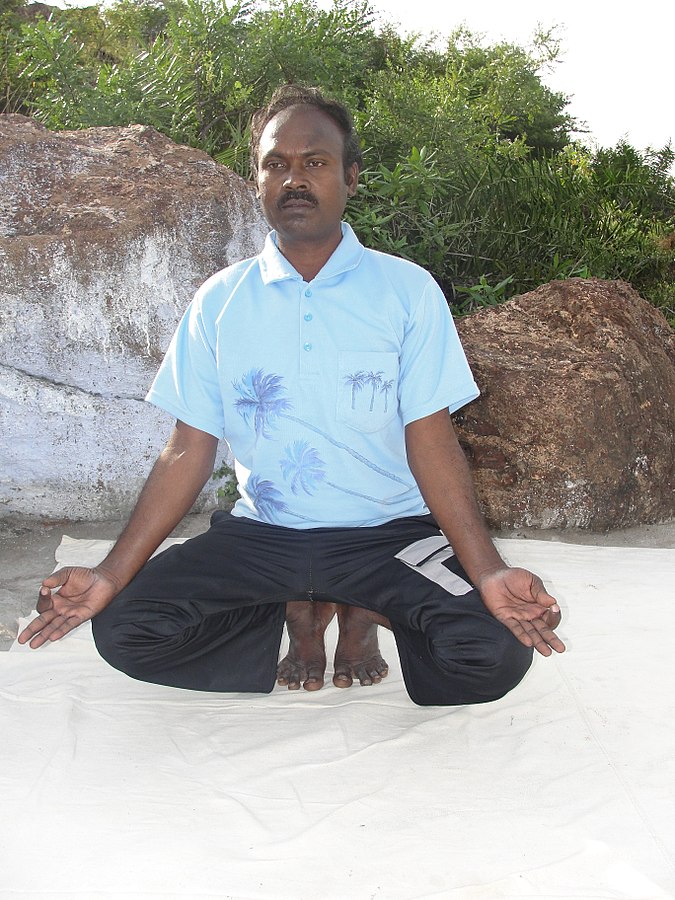
Image Credit: wikimedia
Gorakshasana, an intermediate level pose, holds a captivating history. Legend has it that Yogi Goraknath, the 10th century founder of Nath Sampradaya, practiced this pose for meditation. Translating to “pose for the one who protects the cows” or “pose for the protector of the earth,” it represents a deeper connection to our roots and the world.
How do it?
- Begin in Padmasana (Lotus Pose).
- Place your hands on the mat beside your hips.
- Shift your weight forward onto your hands.
- Lift your hips off the ground, straightening the arms.
- Balance on the hands, keeping the legs crossed.
- Hold the pose, breathing steadily.
Benefits of doing Gorakshasana
- Improves balance and concentration.
- Enhances flexibility in the hips and knees.
- Stimulates the abdominal organs and aids digestion.
26. Halasana
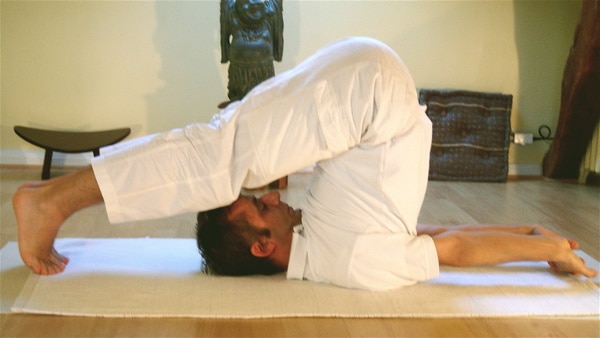
Image Credit: wikimedia
In Hatha ratnavali, a classic hatha yoga text, Halasana or Plow Pose is described as the destroyer of disease. It is an intermediate to advanced level pose that provides numerous benefits for the body and mind. This inverted pose can help improve digestion, reduce stress and anxiety, and stimulate the thyroid gland.
How do it?
- Lie on your back with your legs extended and arms beside your body.
- Inhale deeply and lift your legs off the ground, raising them towards the ceiling.
- Use your hands to support your hips and lower back as you gently lift your legs over your head.
- Allow your toes to touch the ground behind your head, keeping your legs straight.
- Keep your neck relaxed and breathe deeply.
- To release, slowly lower your legs back down to the ground, one vertebra at a time.
Benefits of doing Halasana
- Stimulates the thyroid gland
- Improves digestion and metabolism
- Reduces stress and anxiety
- Increases flexibility in the spine and hamstrings
27. Hanumanasana
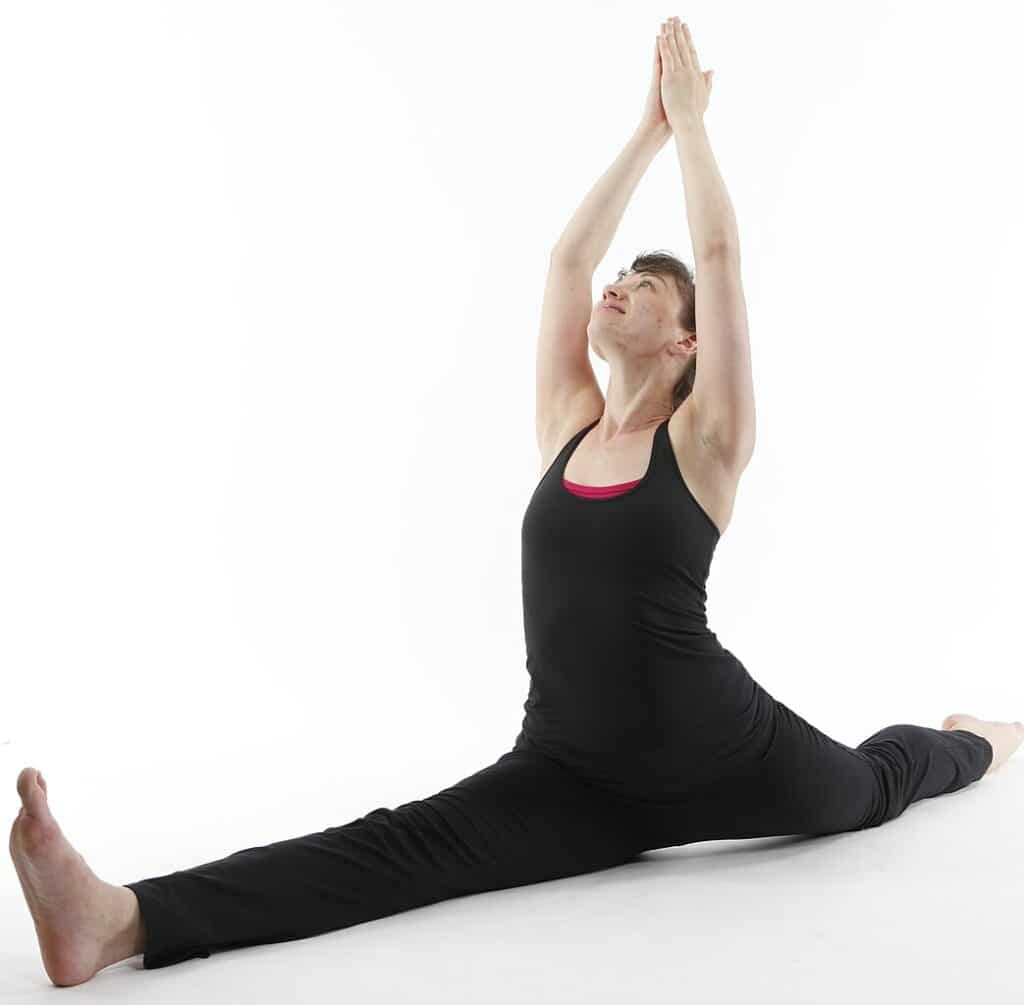
Image Credit: wikimedia
Hanumanasana, also known as the Monkey Pose or Split Pose, is an advanced yoga asanas that requires a great deal of flexibility in the hips and legs. It is also believed to open up energy channels in the body, promoting better circulation and overall well-being. It’s named after Lord Hanuman’s giant leap in the Ramayana.
How do it?
- Begin in a standing position with your feet hip-width apart.
- Slowly extend one leg forward, keeping the other leg extended backward.
- Exhale and lower your hips to the ground, sliding your front leg forward and your back leg backward.
- Keep both legs straight and engage your core muscles for stability.
- Repeat on the other side, switching the position of your legs.
Benefits of doing Hanumanasana
- Increases flexibility in the hips and legs
- Opens up energy channels in the body
- Promotes better circulation
- Relieves stress and tension in the lower body.
28. Janusirsasana
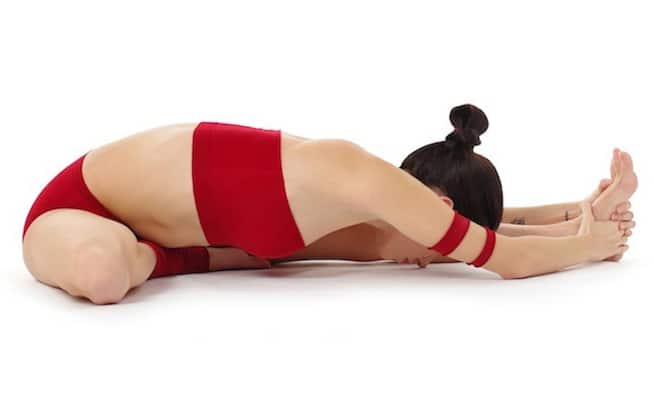
Image Credit: wikimedia
Janusirsasana, or Head-to-Knee Forward Bend, is a seated yoga asanas that involves stretching and working the entire body. This pose can help strengthen the back muscles, improve digestion, and increase flexibility in the hips and hamstrings. It’s a type of Ashtanga yoga asana.
How do it?
- Sit on the mat with your legs stretched out in front of you.
- Bend your right knee and place the sole of your right foot against your left inner thigh.
- Inhale and lengthen your spine.
- Exhale and slowly fold forward from the hips, reaching your hands towards your left foot.
- Keep your left leg engaged and flex your left foot.
- Relax your neck and shoulders, and breathe deeply.
Benefits of doing Janusirsasana
- Stretches the entire body
- Improves digestion
- Increases flexibility in hips and hamstrings
- Strengthens back muscles
29. Jathara Parivartanasana
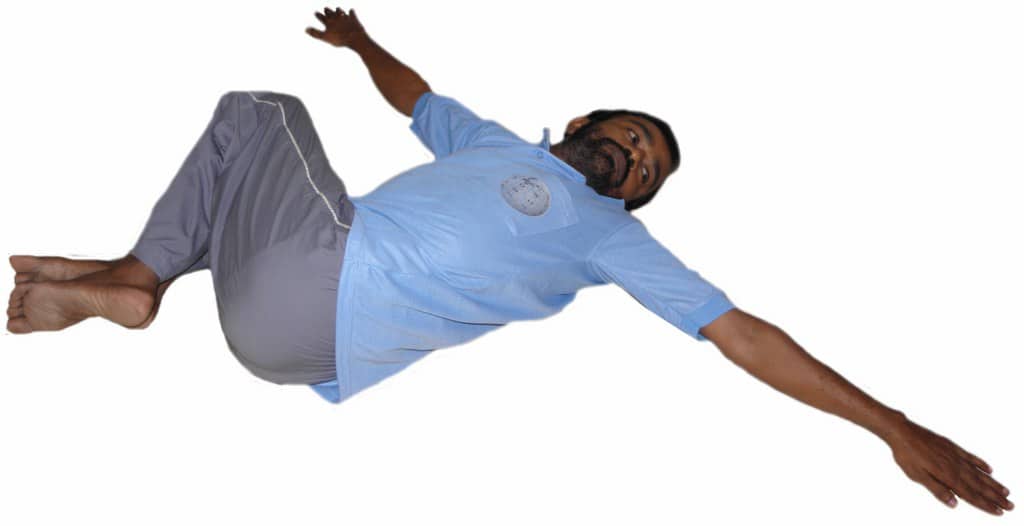
Image Credit: wikimedia
Jathara Parivartanasana, also known as the Reclining Spinal Twist or Belly Revolved Pose, is a beginner-friendly yoga asanas that focuses on stretching the back and spine. This pose can help improve flexibility in the spine and relieve tension in the lower back. If you want to practice yoga for health, this is one of the best yoga poses.
How do it?
- Begin by lying on your back with your arms spread out to the sides.
- Bend your right knee and bring it towards your chest, keeping your left leg extended along the ground.
- Use your left hand to guide your right knee across your body, twisting gently towards the left side.
- Keep your shoulders and hips grounded on the mat.
- Inhale and bring your knees back to the center.
- Repeat the twist on the other side, lowering your knees to the left.
Benefits of doing Jathara Parivartanasana
- Stretches back and spine
- Relieves tension in lower back
- Can improve digestion
- Calms the mind and reduces stress
30. Kapotasana
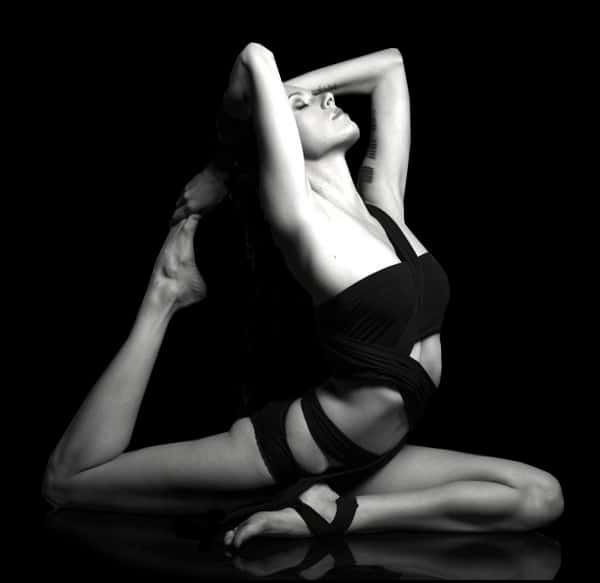
Image Credit: wikimedia
Kapotasana, also known as the Pigeon Pose, is a deep hip-opening pose that can provide many physical and mental benefits. This asana targets the hips, glutes, and lower back, making it helpful in relieving tension and tightness in these areas. It is often included in yoga sequences for its calming and grounding effects on the mind.
How do it?
- Begin in a tabletop position with your hands and knees aligned.
- Bring one leg forward, bending the knee and placing the foot close to your opposite hand.
- Extend your back leg behind you, keeping it straight.
- Slowly lower your upper body towards the ground, resting on your forearms or forehead.
- Hold this pose for a few breaths, then switch sides.
Benefits of doing Kapotasana
- Opens up the hips and glutes
- Relieves tension in the lower back
- Calms the mind and reduces stress
- Increases flexibility in the hip region
31. Karnapidasana
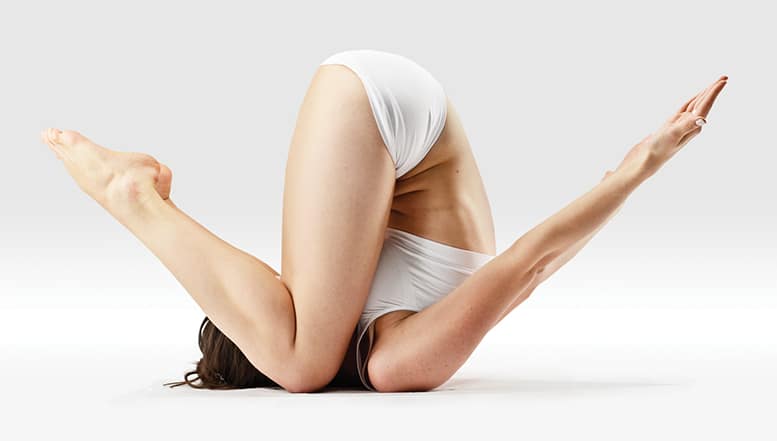
Image Credit: wikimedia
Karnapidasana, also known as the Ear Pressure Pose, is a seated yoga asanas that involves folding the legs over the head to put pressure on the ears. This is a yoga asanas that involves folding the legs over the head while lying on the back, creating a compact, compressed position resembling a plow.
How do it?
- Begin by lying on your back with your arms beside you.
- Inhale, lift your legs over your head, and bring them towards the floor behind you.
- Place your toes on the ground, keeping your knees bent.
- Bring your hands to clasp your lower back, extending your spine.
- Hold the pose for several breaths before gently releasing.
Benefits of doing Karnapidasana
- Stretches and strengthens the spine.
- Massages and stimulates the abdominal organs.
- Alleviates stress and fatigue.
- Improves digestion and helps with mild backaches.
32. Kaundinyasana
Image Credit: wikimedia
Kaundinyasana, also known as Sage Kaundinya’s pose – a captivating hand-balancing yoga posture that will leave you feeling energized and focused. This is an advanced arm balance that challenges strength, balance, and flexibility. Named after the sage Kaundinya, this pose requires core engagement and precision.
How do it?
- Begin in a low lunge position with your hands on the floor.
- Shift your weight forward onto your hands, bringing your knee to the outside of your triceps.
- Lift your back leg off the ground, straightening it.
- Engage your core, leaning forward while extending your bent leg back.
- Hold the position, then return to the starting position.
Benefits of doing Kaundinyasana
- Strengthens arms, wrists, and core.
- Improves balance and focus.
- Tones abdominal muscles.
- Enhances overall body awareness.
33. Kraunchasana
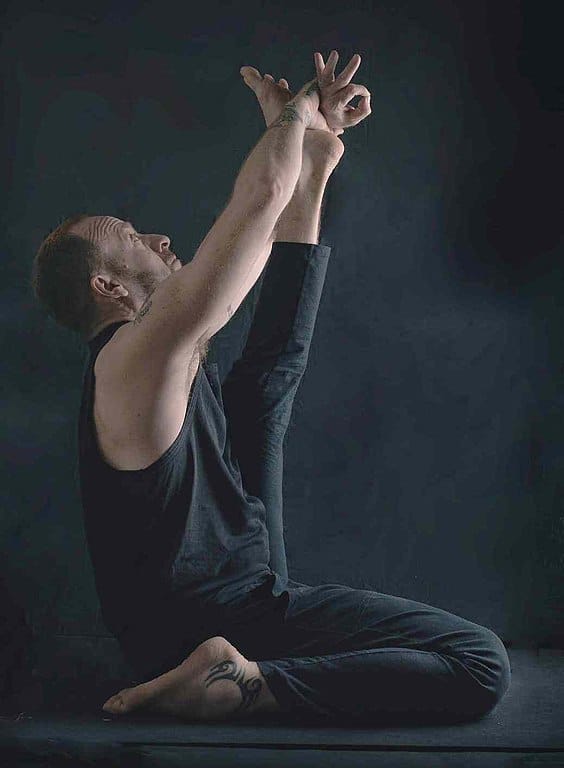
Image Credit: wikimedia
Kraunchasana, also known as the Heron Pose, is a seated yoga asanas that involves balancing on one leg while extending the other leg in front of you. This pose requires core strength and balance, making it a great exercise for improving posture and stability.
How do it?
- Sit with your legs extended in front of you.
- Bend one knee and bring the heel towards the same-side buttock.
- Hold the ankle with the hand on the same side.
- Extend the other leg straight, keeping it active.
- Inhale, lift the extended leg, balancing on the sitting bone.
- Hold, then release and switch sides.
Benefits of doing Kraunchasana
- Stretches and strengthens leg muscles.
- Improves digestion and stimulates abdominal organs.
- Enhances balance and concentration.
- Alleviates sciatica and lower back pain.
34. Kukkutasana
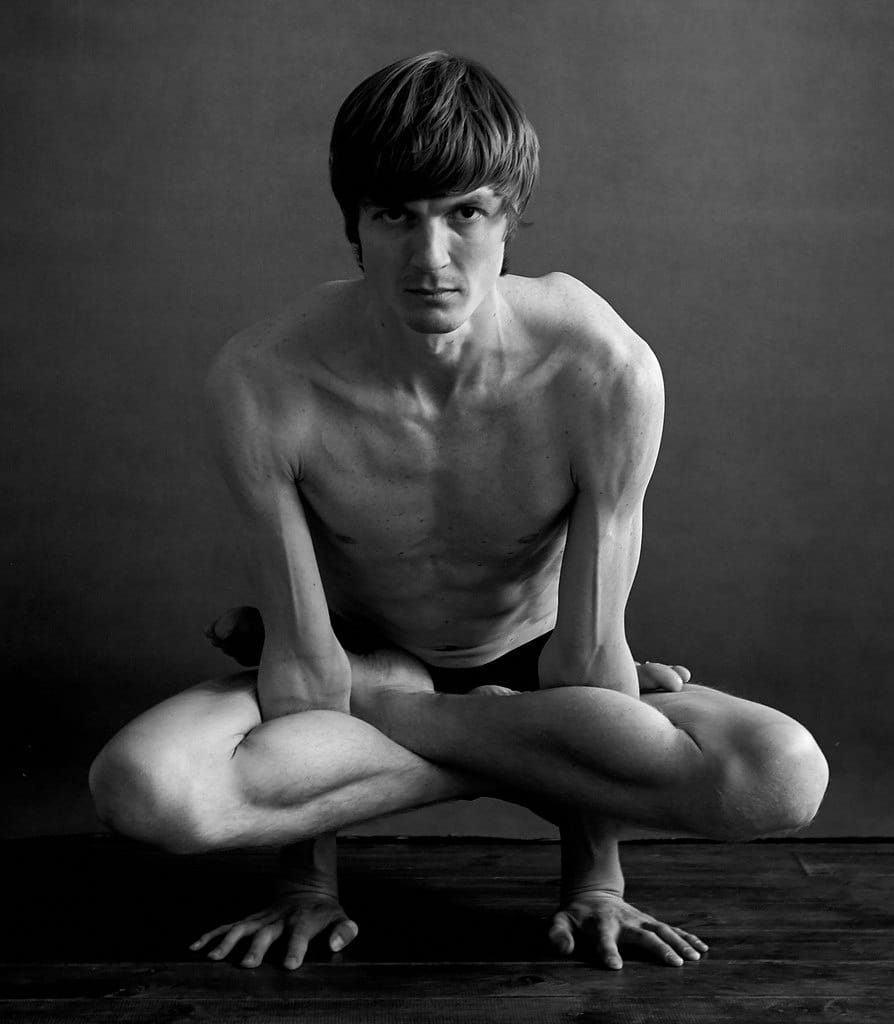
Image Credit: wikimedia
Kukkutasana, also known as the Rooster Pose, is an advanced arm balance yoga pose. This pose requires a lot of arm strength and core stability to keep the body lifted off the ground. It is believed that practicing this pose can help activate energy and improve focus and mental clarity.
How do it?
- Sit in a comfortable cross-legged position.
- Thread your arms through the space between your thighs and calves.
- Plant your hands firmly on the ground, fingers pointing forward.
- Lift your hips off the ground, bringing your legs up into a crossed position.
- Balance on your hands while engaging your core.
Benefits of doing Kukkutasana
- Strengthens arms, wrists, and core.
- Improves balance and coordination.
- Stimulates abdominal organs.
- Builds mental focus and determination.
35. Kurmasana
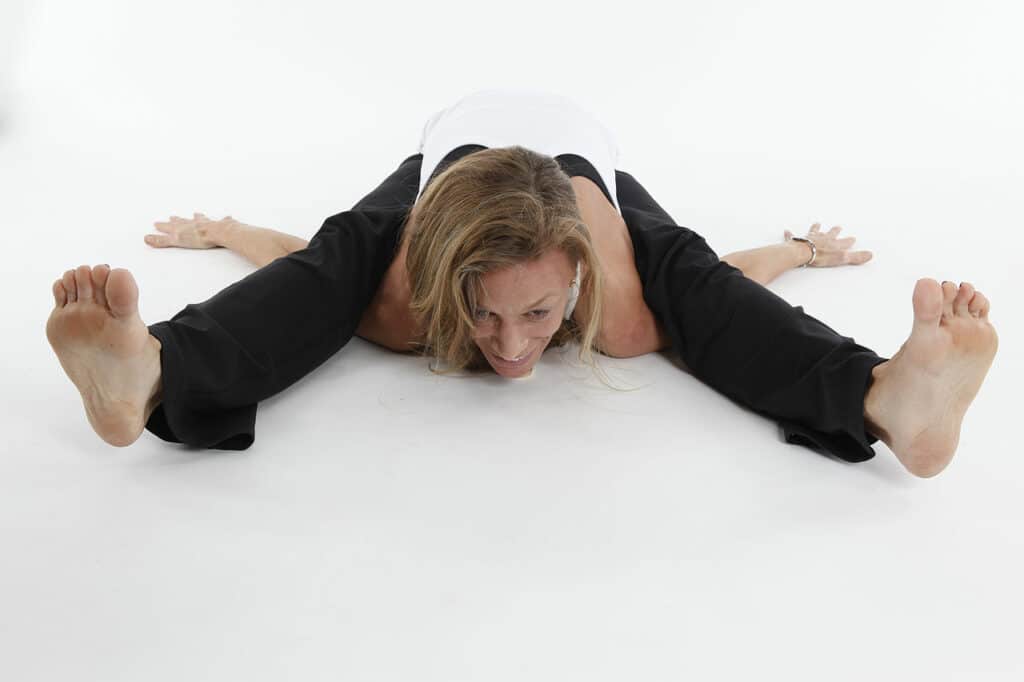
Image Credit: wikimedia
Kurmasana, also known as the Tortoise Pose, is an advanced yoga asanas that requires a considerable amount of flexibility and strength. It involves sitting on the ground with the legs stretched out in front and then folding forward to bring your head between your knees.
How do it?
- Sit with legs extended and feet together.
- Bend your knees and slide your arms under your legs.
- Bring your arms out to the sides, crossing them behind your back.
- Lower your torso, reaching forward with your head toward the ground.
- Hold the pose for several breaths before releasing.
Benefits of doing Kurmasana
- Stretches and opens the hips and lower back.
- Calms the mind and reduces stress.
- Stimulates abdominal organs and improves digestion.
- Enhances flexibility in the spine and shoulders.
36. Lolasana
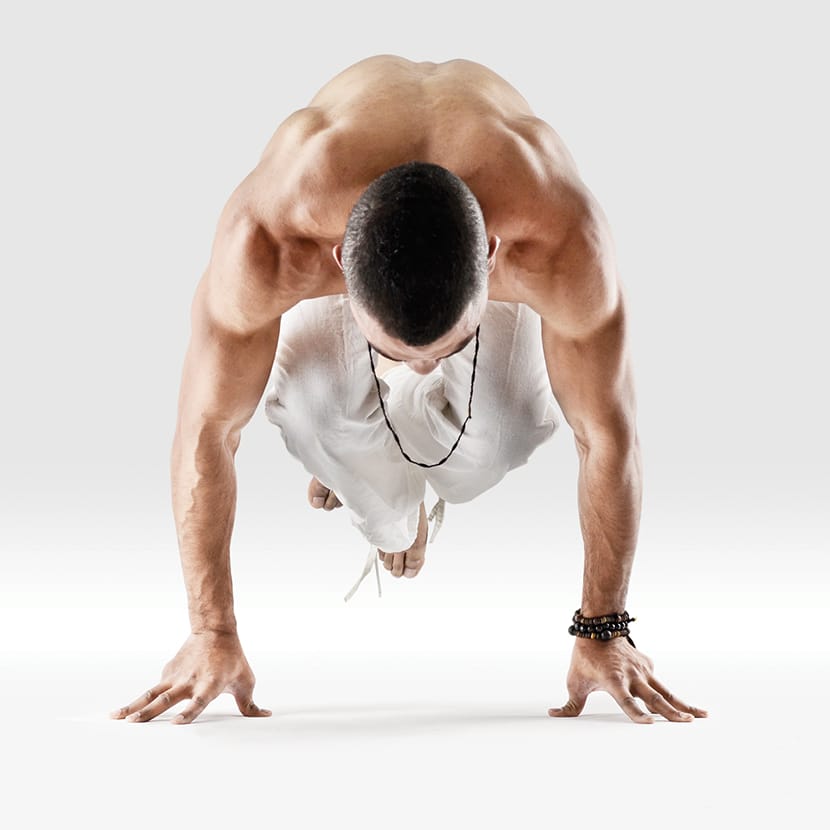
Image Credit: wikimedia
Lolasana, also known as Pendant Pose or Swing Pose, is an advanced arm balance that requires a significant amount of upper body and core strength. This pose is great for building arm and shoulder muscles and improving overall body control and coordination.
How do it?
- Sit on the floor with your legs extended.
- Place your hands on the ground beside your hips.
- Lift your legs off the ground, bringing them parallel to the floor.
- Balance on your hands, keeping your core engaged.
- Hold the pose for a few breaths before lowering down.
Benefits of doing Lolasana
- Strengthens wrists, arms, and shoulders.
- Tones the abdominal muscles.
- Improves balance and concentration.
- Enhances overall upper body strength.
37. Makarasana
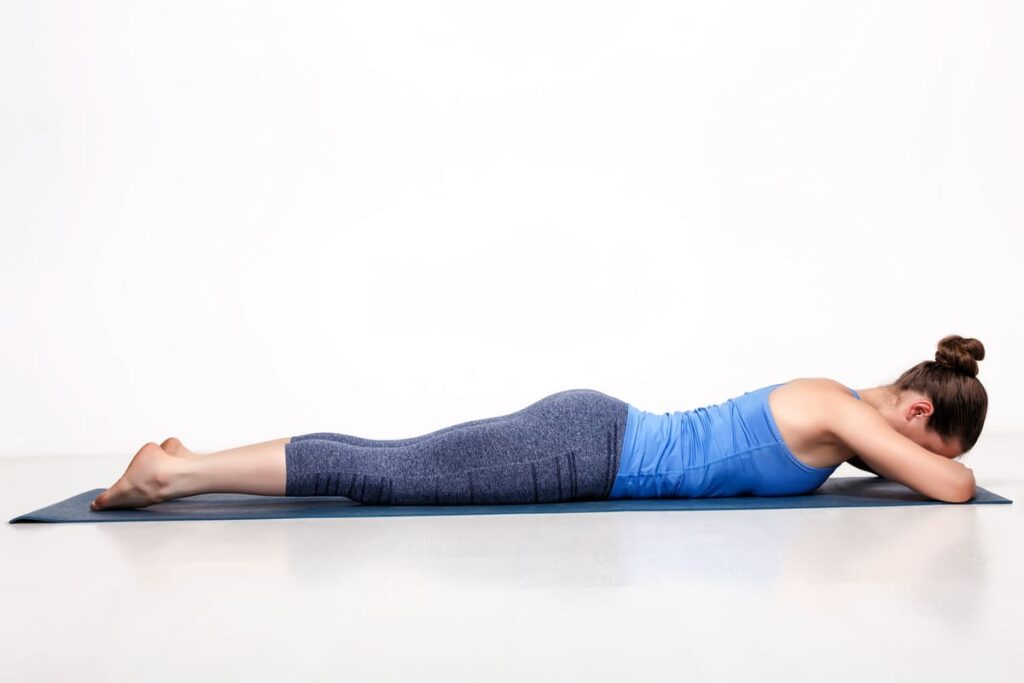
Makarasana, also known as the Crocodile Pose, is a restorative pose that involves lying on your stomach with your arms and legs stretched out. This yoga asanas can help release tension in the lower back and hips while promoting relaxation and rejuvenation. It is often practiced at the end of a yoga session to wind down and prepare for meditation.
How do it?
- Lie on your stomach with your legs extended.
- Place your arms in a pillow position, with one hand over the other.
- Rest your forehead on your hands.
- Close your eyes and focus on slow, deep breaths.
- Hold the pose for a few minutes.
Benefits of doing Makarasana
- Relieves back pain and tension.
- Promotes relaxation and stress relief.
- Stretches and opens the chest and shoulders.
- Calms the nervous system and aids in better sleep.
38. Malasana
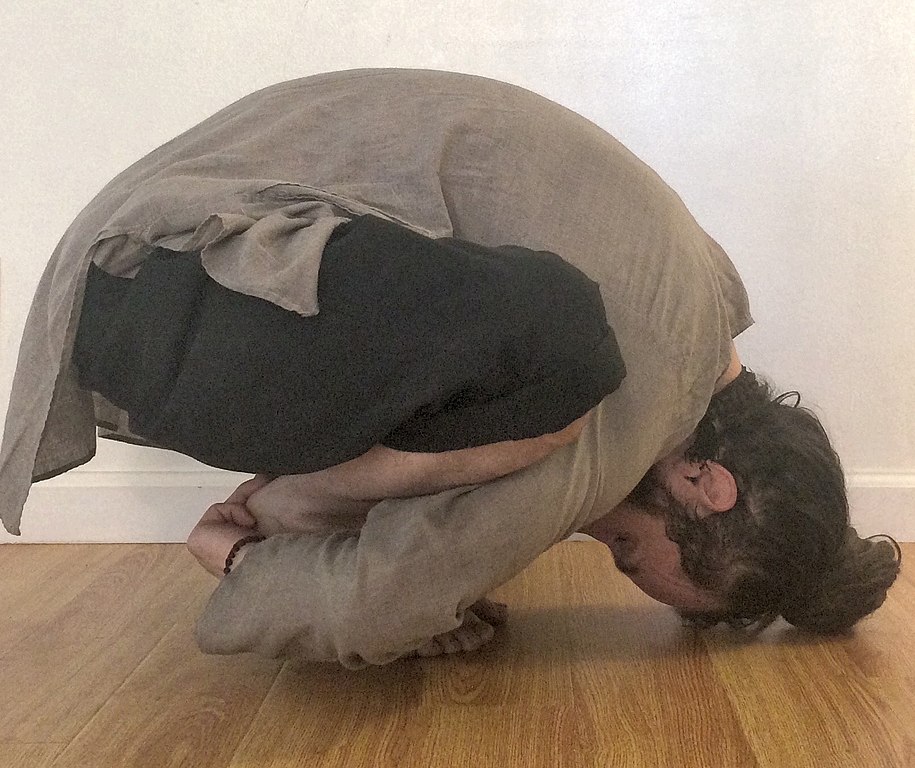
Image Credit: wikimedia
Malasana, also known as the Garland Pose or Yoga Squat, is a deep squat pose that stretches and strengthens the hips, thighs, and groin area. This pose helps improve flexibility in the lower body and can also stimulate digestion. It is commonly practiced in prenatal yoga classes to prepare for childbirth.
How do it?
- Begin in a standing position with feet wider than hip-width apart.
- Lower your body into a squat position.
- Bring your palms together in a prayer position at the chest.
- Press your elbows against the inner knees to open the hips.
- Hold the pose, feeling the stretch in the hips and groin.
Benefits of doing Malasana
- Stretches and strengthens the hips, thighs, and groin.
- Improves flexibility in the ankles and knees.
- Aids in digestion and elimination.
- Tones the abdominal muscles.
39. Mandukasana
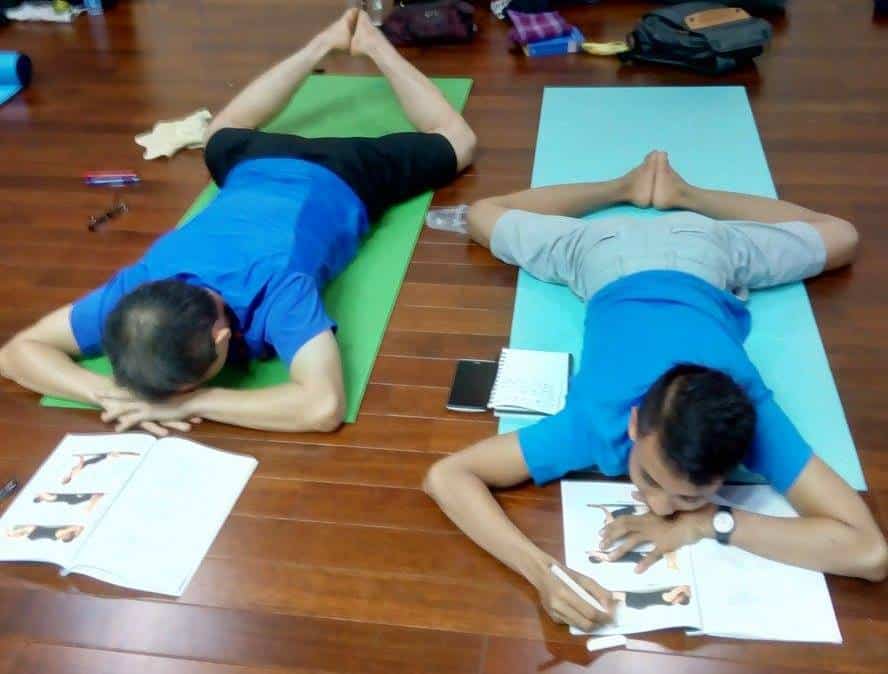
Image Credit: wikimedia
Mandukasana, also known as the Frog Pose, is a seated yoga asanas that involves stretching the hips and thighs. This pose can help improve flexibility in these areas and also aid digestion by massaging the abdominal organs. It is also believed to have therapeutic effects for those with diabetes and high blood pressure.
How do it?
- Begin in a tabletop position.
- Bring your knees wide apart, toes pointing outward.
- Lower your hips towards the ground, feeling a stretch in the inner thighs.
- Place your forearms on the floor and keep the chest lifted.
- Hold the pose for several breaths before releasing.
Benefits of doing Mandukasana
- Stretches and tones the inner thighs.
- Strengthens the pelvic muscles.
- Improves digestion and stimulates abdominal organs.
- Alleviates sciatica and lower back pain.
40. Marichyasana
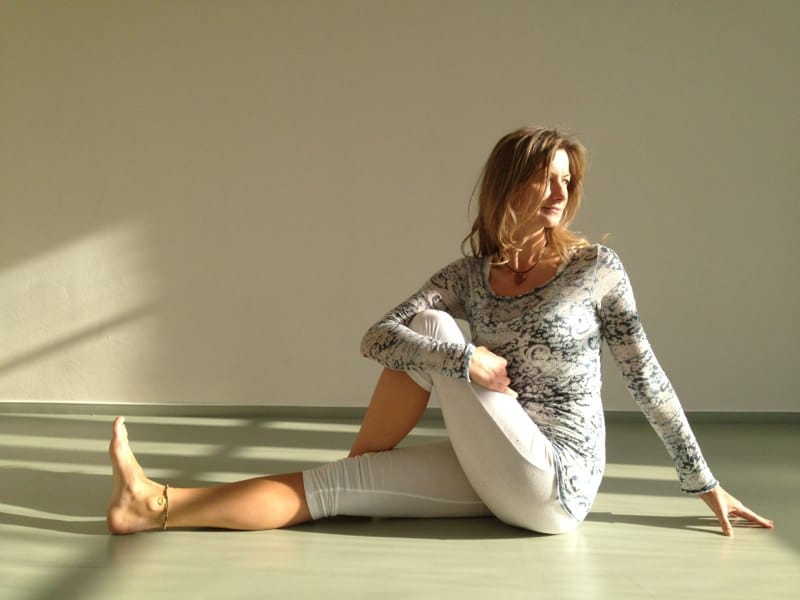
Image Credit: wikimedia
Marichyasana, also known as the Seated Twist or Sage Pose, is a seated yoga asanas that involves twisting the spine and stretching the arms. This pose can help improve digestion and relieve tension in the lower back. It is also believed to stimulate the internal organs and detoxify the body.
How do it?
- Sit with your legs extended and feet flexed.
- Bend one knee and bring the foot close to the sitting bone.
- Inhale, lengthen the spine and twist towards the bent knee.
- Hold the foot with the opposite hand and reach the other arm behind.
- Hold the pose, feel the twist, then switch sides.
Benefits of doing Marichyasana
- Improves spinal flexibility and mobility.
- Stimulates the digestive organs.
- Strengthens the shoulders and arms.
- Relieves tension in the neck and upper back.
41. Matsyasana
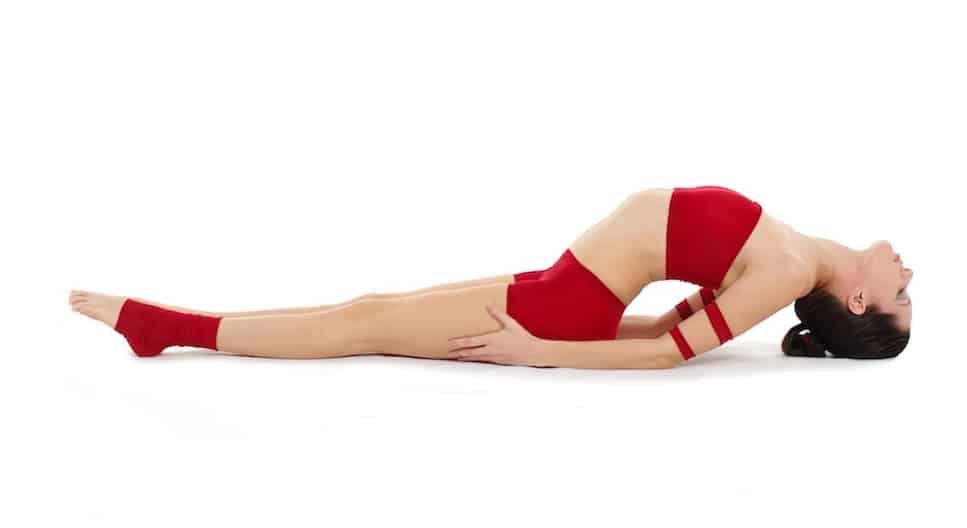
Image Credit: wikimedia
Matsyasana, also known as the Fish Pose, is a reclining back-bending yoga asanas. In Sanskrit, Matsya means fish and asana means posture or seat. This is one of the famous supine poses, often done at the end of a yoga practice to stretch and open up the chest, neck, and throat area. It can also help improve posture and counteract the effects of sitting for long periods.
How do it?
- Lie on your back with your legs extended.
- Place your hands under your hips, palms facing down.
- Press into your forearms and lift your chest towards the sky.
- Allow the head to tilt backward, creating a backbend gently.
- Hold the pose, feeling the stretch in the chest and throat.
Benefits of doing Matsyasana
- Stretches and opens the chest, neck, and throat area.
- Improves posture
- Relieves tension and fatigue in the upper body.
- Stimulates the abdominal organs.
42. Matsyendrasana
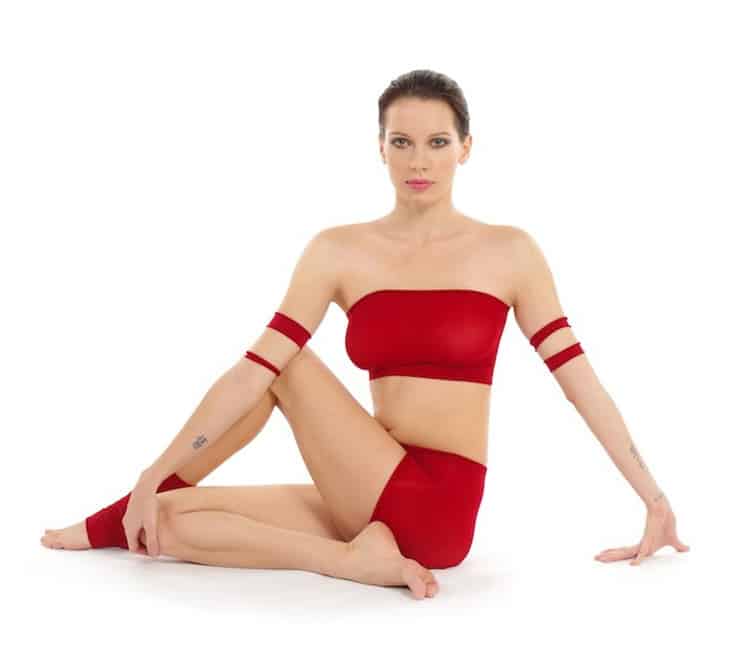
Image Credit: wikimedia
Matsyendrasana, also known as the Lord of the Fishes Pose, is a seated spinal twist that helps to improve flexibility and mobility in the spine. This pose also stimulates digestion and can help relieve tension in the back, shoulders, and neck. The pose has two forms: Paripurna Matsyendrasana, which is more challenging, and Ardha Matsyendrasana, a common and easier variant.
How do it?
- Sit with your legs extended in front of you.
- Bend one knee and place the foot on the outside of the opposite thigh.
- Bring the opposite foot close to the hip.
- Inhale, lengthen the spine, and exhale to twist towards the bent knee.
- Hold the foot with the opposite hand and extend the other arm behind.
- Repeat on the other side.
Benefits of doing Matsyendrasana
- Increases spinal flexibility.
- Stimulates digestive organs.
- Relieves backache and stiffness.
- Massages and detoxifies abdominal organs.
43. Mayurasana
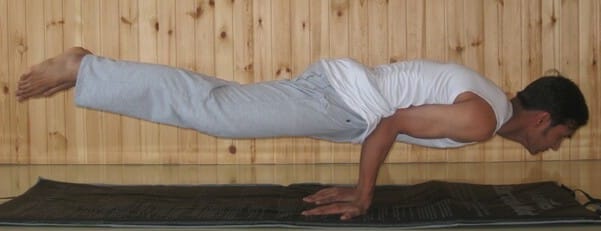
Image Credit: wikimedia
Mayurasana, also known as the Peacock Pose, is an advanced yoga asanas that requires a lot of strength and balance. This pose involves balancing on your hands while keeping the body parallel to the ground. This pose can help improve core and arm strength, as well as aid in digestion and detoxification of the body.
How do it?
- Kneel on the mat and bring your hands shoulder-width apart.
- Lean forward, placing your palms on the mat with fingers pointing towards your toes.
- Lift your legs off the ground, extending them straight behind you.
- Engage your core and balance on your hands.
- Hold the pose for a few breaths before lowering down.
Benefits of doing Mayurasana
- Strengthens the arms, wrists, and shoulders.
- Tones and energizes the abdominal muscles.
- Improves digestion and stimulates the organs.
- Enhances overall body balance and concentration.
44. Muktasana
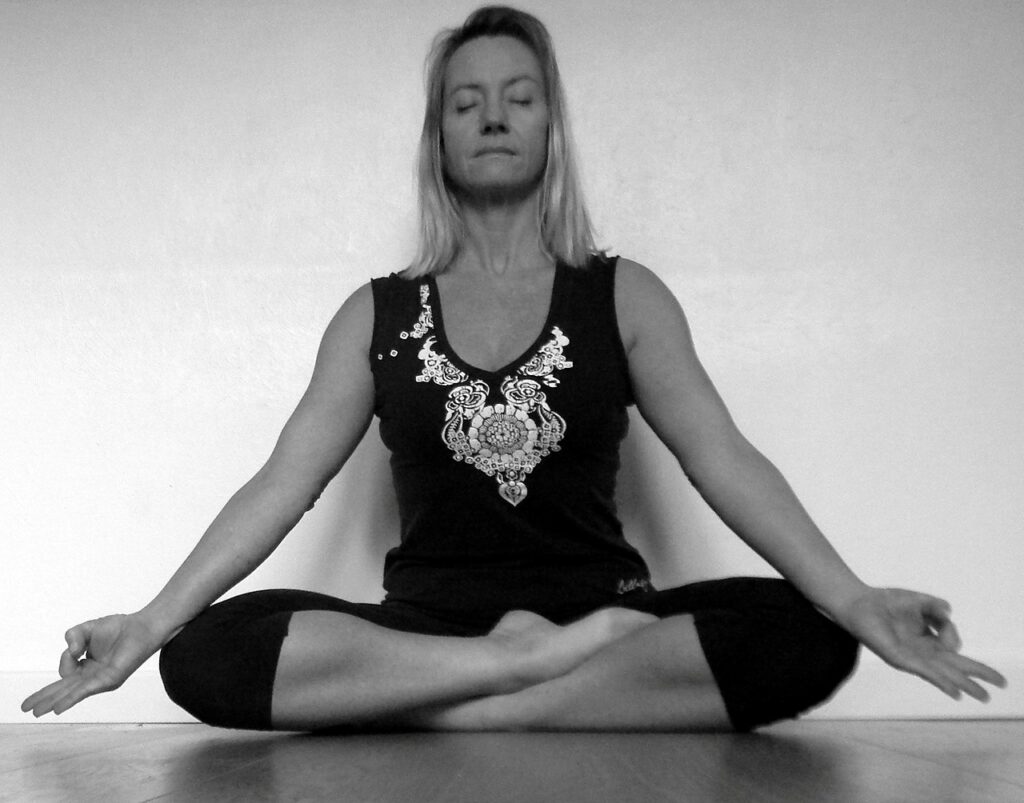
Image Credit: wikimedia
Muktasana, also known as the Liberated Pose, is a simple seated posture that involves binding the legs and bending forward to stretch the spine. This pose can help increase flexibility in the hips, thighs, and lower back while also calming the mind. It’s a great pose to incorporate into your daily yoga routine for relaxation and releasing tension.
How do it?
- Sit with your legs extended in front of you.
- Bend your knees and bring the soles of your feet together.
- Allow your knees to drop to the sides.
- Rest your hands on your knees or thighs.
- Close your eyes and focus on your breath.
Benefits of doing Muktasana
- Promotes relaxation and stress relief.
- Stretches and opens the hips and groin.
- Calms the mind and improves concentration.
- Facilitates deep breathing and enhances lung capacity.
45. Natarajasana
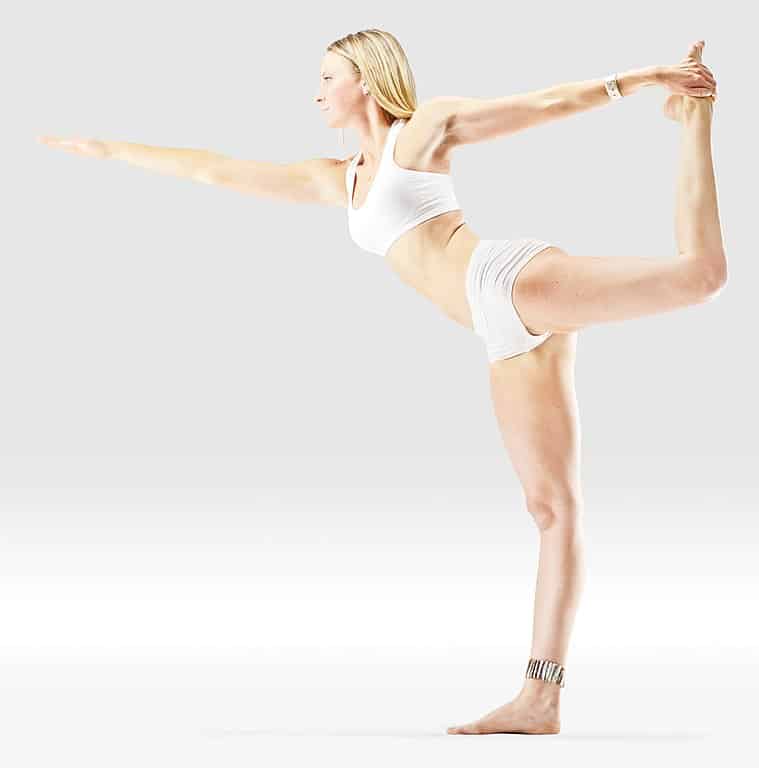
Image Credit: wikimedia
Natarajasana, also known as the Lord of the Dance Pose, is a standing balance pose that strengthens and stretches the legs and improves overall balance. This pose requires focus, core strength, and flexibility in the lower body. In Hindu mythology, this pose represents the cosmic dance of Lord Shiva.
How do it?
- Stand on one leg and lift the opposite heel towards the buttock.
- Reach back with the hand of the lifted leg and hold the ankle.
- Extend the opposite arm forward.
- Kick the lifted foot into the hand, arching the back.
- Hold the pose, balancing on one leg.
Benefits of doing Natarajasana
- Improves balance and coordination.
- Stretches the thighs, groin, and shoulders.
- Strengthens the legs and ankles.
- Opens the chest and promotes a sense of grace and poise.
46. Navasana or Naukasana
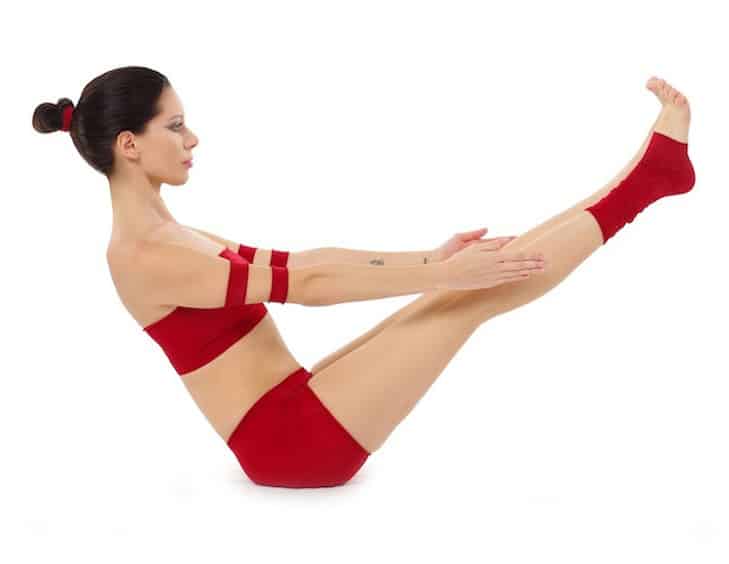
Image Credit: wikimedia
Naukasana, also known as the Boat Pose, is a seated yoga asanas that involves holding the body in a V shape while balancing on the sit bones. This pose works on strengthening the core and improving balance and stability. It also helps to improve digestion and stimulate abdominal organs.
How do it?
- Sit on the mat with your legs extended in front of you.
- Lean back slightly, lifting your legs off the ground.
- Balance on your sitting bones, forming a V shape with your body.
- Keep your chest lifted and arms parallel to the ground.
- Hold the pose, engaging the core muscles.
Benefits of doing Navasana or Naukasana
- Strengthens the abdominal muscles.
- Tones the leg muscles.
- Improves balance and posture.
- Stimulates and massages the digestive organs.
47. Padmasana
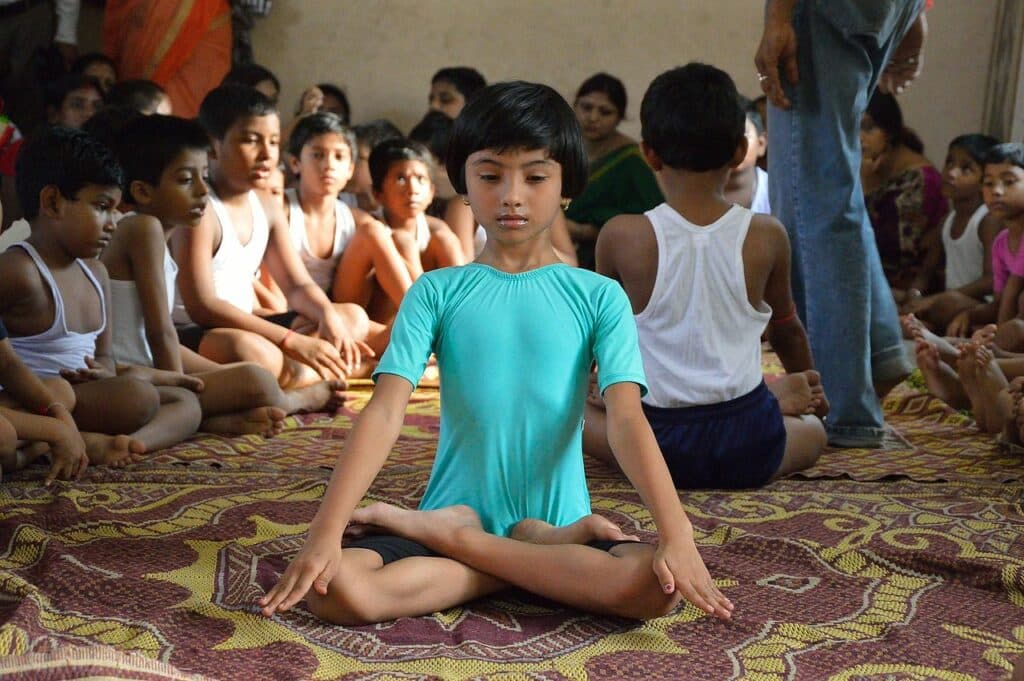
Image Credit: wikimedia
Padmasana, also known as the Lotus Pose, is a seated yoga asanas that involves crossing your legs and resting your feet on opposite thighs. This pose is often used for meditation as it promotes inner calm and helps to ground the body and mind. Padmasana is also known to increase blood circulation and improve posture.
How do it?
- Sit on the mat with your legs extended.
- Cross one leg over the other, placing the foot on the opposite thigh.
- Bring the other foot over the opposite thigh in the same manner.
- Rest your hands on your knees or in a mudra.
- Keep your spine straight and breathe deeply.
Benefits of doing Padmasana
- Facilitates deep meditation.
- Opens the hips and stretches the knees.
- Promotes good posture and spine alignment.
- Calms the mind and reduces anxiety.
48. Parighasana
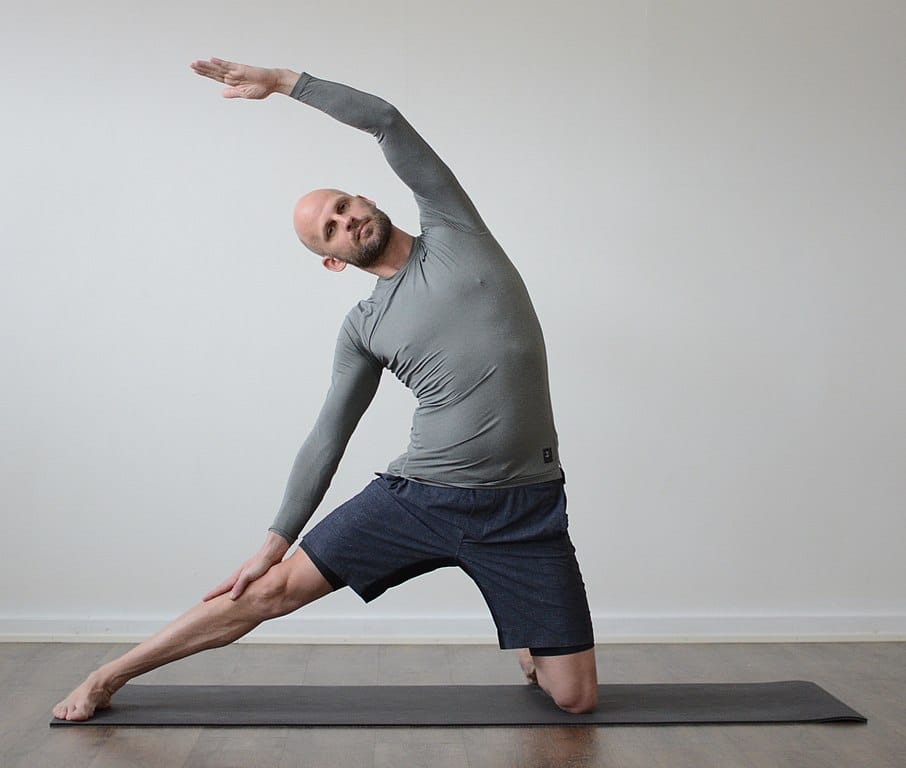
Image Credit: wikimedia
Parighasana, also known as the Gate Pose, is a standing side bend pose that helps to stretch and elongate the spine. It can also help improve balance and focus, as well as stimulate digestion. The name “Parighasana” is derived from the Sanskrit words “parigha” meaning “gates” and “asana” meaning “posture”. This pose is often used in yoga sequences to transition between different asanas.
How do it?
- Kneel on the mat with your legs hip-width apart.
- Extend one leg to the side, toes pointing outward.
- Inhale, raise your arms overhead, and exhale to stretch towards the extended leg.
- Keep the opposite arm alongside the ear.
- Hold the pose, feeling the stretch along the side body.
Benefits of doing Parighasana
- Stretches the spine, shoulders, and sides of the torso.
- Strengthens the legs and core muscles.
- Improves digestion and massages abdominal organs.
- Enhances flexibility in the hips and waist.
49. Parshvakonasana
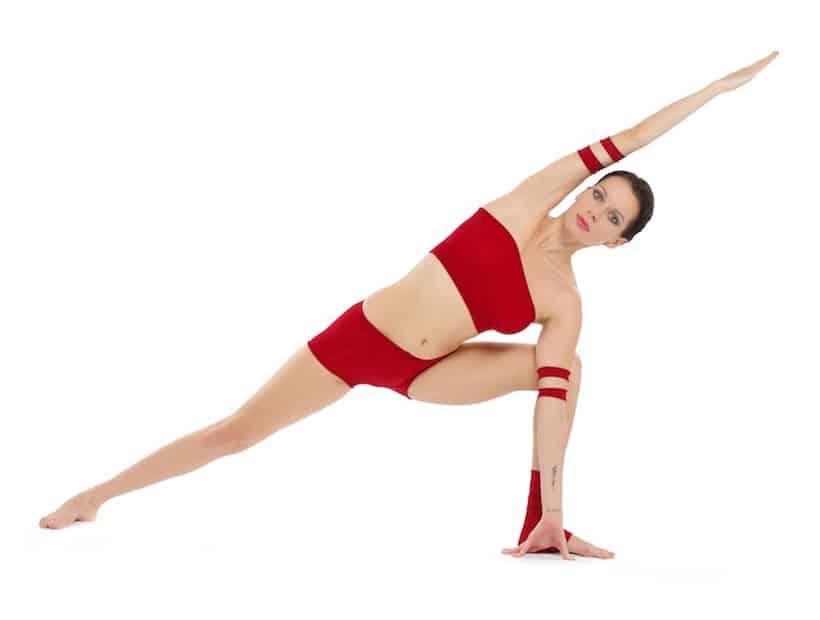
Image Credit: wikimedia
Parshvakonasana, also known as the Extended Side Angle Pose, is a standing yoga asanas that focuses on stretching and strengthening the entire body. This pose can help improve balance and stability, increase flexibility in the hips and legs, and energize the body. It also helps to open up the chest area, improving overall posture.
How do it?
- Begin in a wide-legged stance with feet parallel to each other.
- Turn one foot outward and bend the knee, aligning it with the ankle.
- Extend the opposite arm down, placing the hand on the ground or a block.
- Reach the other arm overhead, forming a straight line from the fingertips to the extended foot.
- Hold the pose, engaging the core and legs.
Benefits of doing Parshvakonasana
- Strengthens the legs and improves stability.
- Stretches the groin, hips, and side body.
- Enhances lung capacity and deepens breathing.
- Promotes a sense of balance and concentration.
50. Parshvottanasana
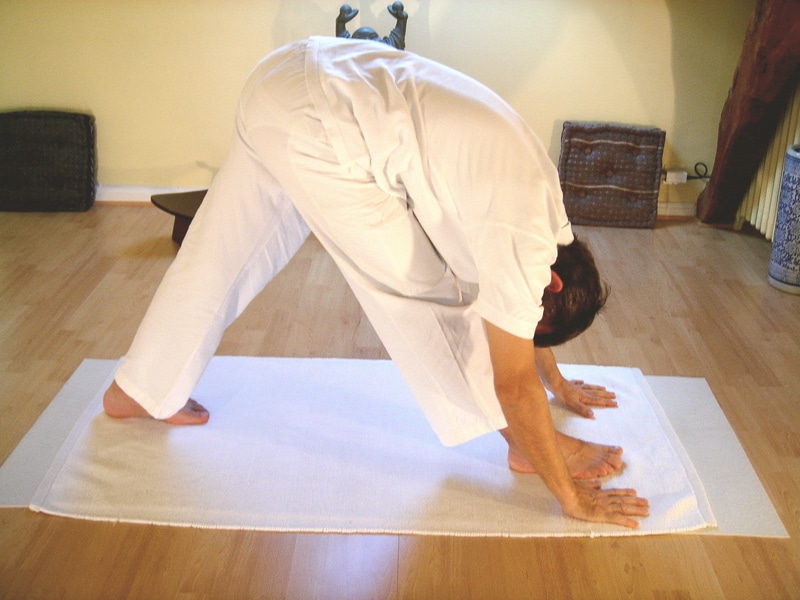
Image Credit: wikimedia
Parshvottanasana, also known as the Intense Side Stretch Pose or Pyramid Pose, is a standing forward-bending pose that stretches the hamstrings and calves. This pose helps develop balance and stability while improving overall flexibility in the legs and hips. It also stretches the glutes and upper back, improving blood circulation to the brain.
How do it?
- Start in a standing position with your feet hip-width apart.
- Step one foot back, keeping the toes pointing forward.
- Inhale, lengthen the spine, and exhale to hinge at the hips, reaching towards the extended foot.
- Keep the back straight and chest lifted.
- Hold the pose, feeling the stretch in the back of the front leg.
Benefits of doing Parshvottanasana
- Stretches and strengthens the hamstrings.
- Improves flexibility in the hips and lower back.
- Tones the abdominal muscles.
- Enhances balance and focus while calming the mind.
51. Pashasana
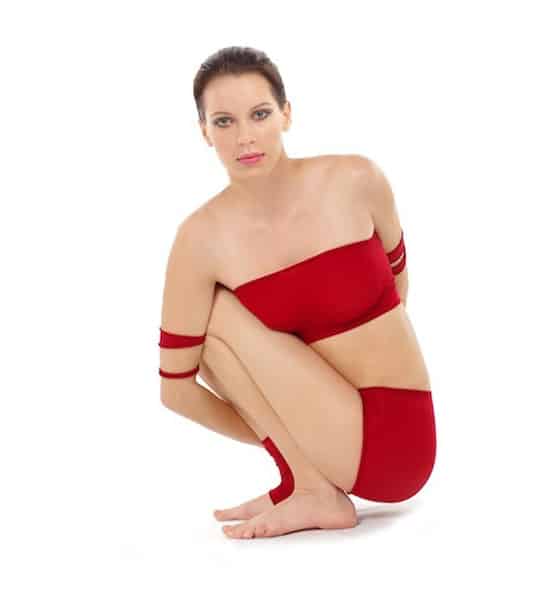
Image Credit: wikimedia
Pashasana, also known as the Noose pose, is an intermediate-level yoga asanas that stretches the hips and thighs while strengthening the arms and shoulders. This pose also helps improve balance and focus, making it a great practice for both the mind and body. The pose enables practitioners to explore themes of bondage, freedom, commitment, and devotion.
How do it?
- Begin by sitting on your mat with your legs extended in front of you.
- Bend your right knee and bring it close to your chest, placing the foot on the mat outside your left thigh.
- Keep your left leg extended, with the foot flexed.
- Exhale while twisting your torso to the right, bringing your left arm around your right knee.
- Hold this pose for a few breaths before gently releasing and switching sides.
Benefits of doing Pashasana
- Stretches the hips and thighs
- Strengthens the arms and shoulders
- Improves balance and focus
- Releases tension in the lower back
52. Paschimottanasana
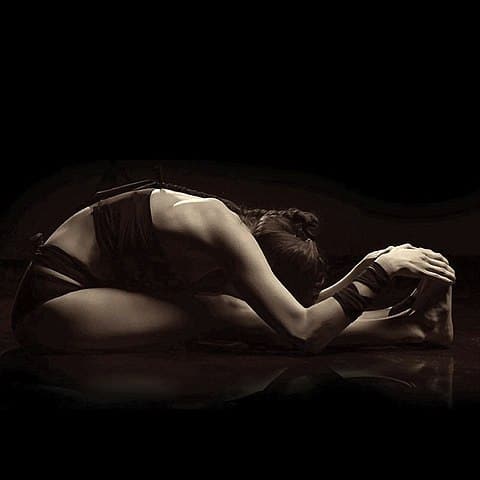
Image Credit: wikimedia
Paschimottanasana, also known as the Seated Forward Bend or Intense Dorsal Stretch Pose, is a seated yoga asanas that focuses on stretching and strengthening the spine. The name comes from three Sanskrit words: Paschima meaning west or back of the body, uttana meaning intense stretch, and asana meaning pose.
How do it?
- Sit on the floor with your legs extended in front of you.
- Inhale, lengthen the spine and exhale to hinge at the hips.
- Reach forward toward your toes, keeping the back straight.
- Hold onto your feet or shins, depending on your flexibility.
- Relax your neck and hold the pose for several breaths.
Benefits of doing Paschimottanasana
- Stretches and lengthens the spine.
- Increases flexibility in the hamstrings and calves.
- Calms the mind and reduces stress.
- Stimulates abdominal organs and improves digestion.
53. Pincha Mayurasana
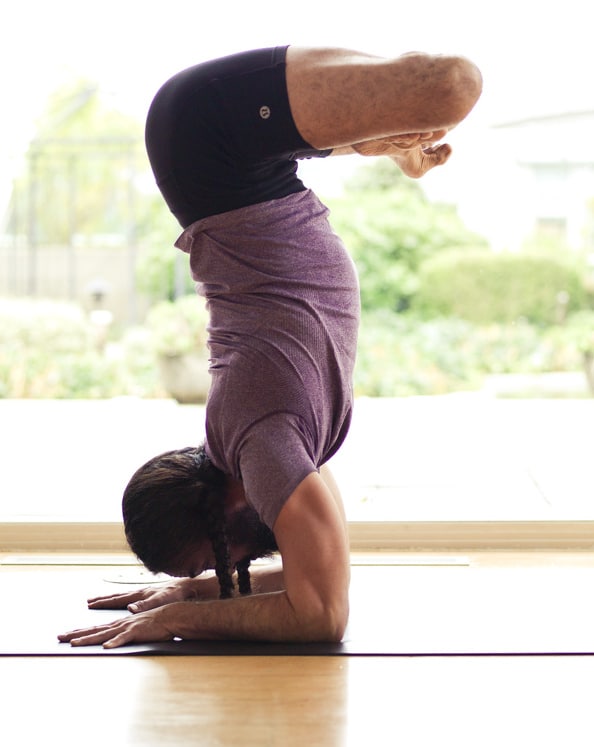
Image Credit: wikimedia
Pincha Mayurasana, also known as the Feathered Peacock Pose or Forearm Stand, is an advanced yoga asanas that involves balancing your forearms with your legs in the air. This pose requires a lot of strength and control, making it a great exercise for building upper body strength and improving balance.
How do it?
- Start in a dolphin pose with forearms on the mat.
- Lift your hips toward the ceiling, walking your feet closer to your face.
- Shift your weight onto your forearms and lift one leg off the ground.
- Use the strength of your core to lift the other leg, coming into a balanced forearm stand.
- Hold the pose, engaging the core and breathing deeply.
Benefits of doing Pincha Mayurasana
- Strengthens the shoulders, arms, and core.
- Improves balance and coordination.
- Stimulates the nervous system.
- Enhances focus and concentration.
54. Prasarita Padottanasana
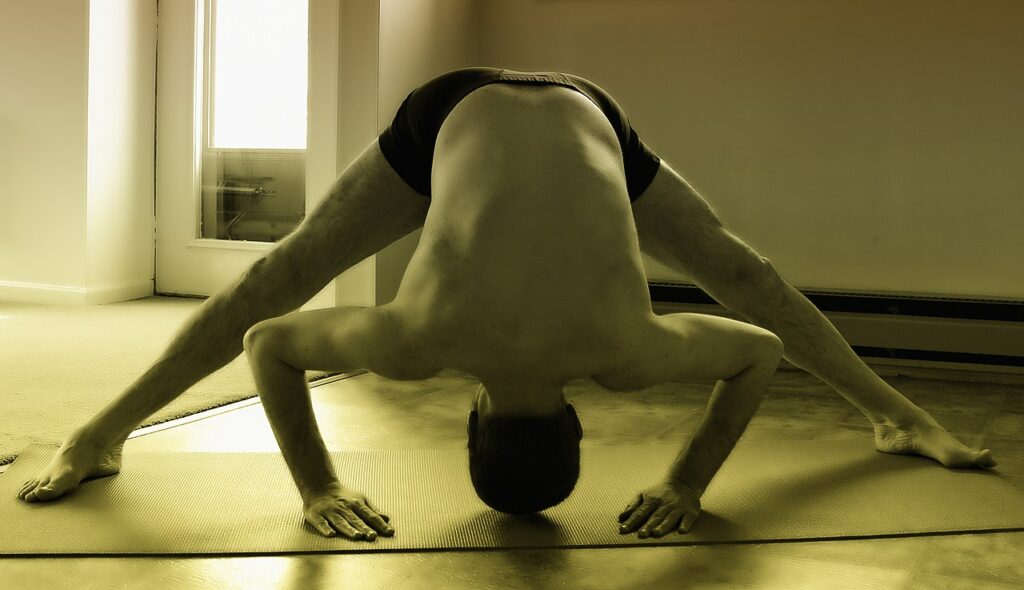
Image Credit: wikimedia
Prasarita Padottanasana, also known as Wide-Legged Forward Fold or Standing Straddle Split, is a calming pose that helps to stretch the back and legs. It’s a positional change that positions the head below the heart. This pose is perfect for relieving headaches and mild anxiety.
How do it?
- Stand with your feet wide apart.
- Inhale, lengthen the spine, and exhale to hinge at the hips.
- Bring your hands to the floor between your feet.
- Keep your back straight and extend the spine forward.
- Hold the pose, feeling the stretch in the legs and lower back.
Benefits of doing Prasarita Padottanasana
- Stretches the hamstrings and inner thighs.
- Calms the mind and relieves stress.
- Strengthens the legs and improves posture.
- Stimulates abdominal organs and aids digestion.
55. Rajakapotasana
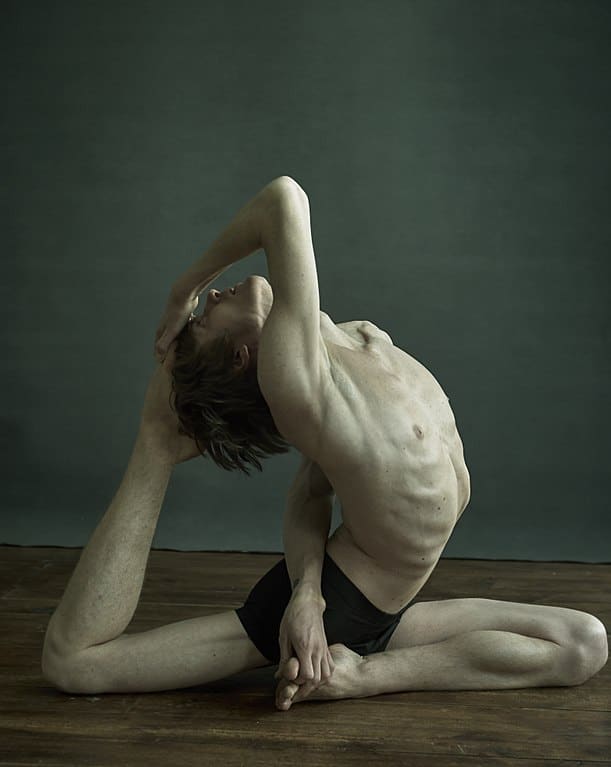
Image Credit: wikimedia
Rajakapotasana, also known as the King Pigeon Pose, is a deep backbend that requires flexibility in the hips and spine. This pose can help improve posture and relieve tension in the chest, shoulders, and upper back. It is also believed to have emotional benefits such as releasing stored emotions and increasing feelings of compassion.
How do it?
- Start in a tabletop position.
- Bring one knee forward, placing it behind the wrist.
- Extend the opposite leg straight behind you.
- Inhale, lift your chest, and arch your back.
- Reach back with your hands to hold the lifted foot.
- Hold the pose, feeling the stretch in the chest and hips.
Benefits of doing Rajakapotasana
- Opens the chest and shoulders.
- Stretches and strengthens the hip flexors.
- Improves flexibility in the spine.
- Relieves tension in the lower back.
56. Shalabhasana
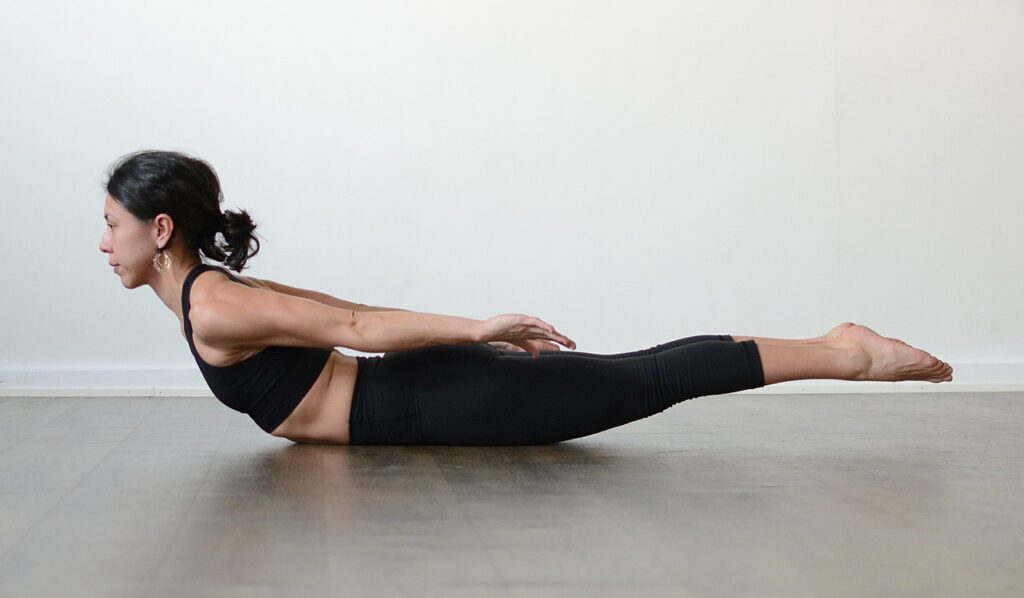
Image Credit: wikimedia
Shalabhasana, also known as the Locust Pose, is a back-bending pose that focuses on strengthening and stretching the spine, shoulders, abdomen, and legs. This pose can help improve posture and relieve tension in the back muscles.
How do it?
- Lie on your stomach with your arms alongside your body.
- Inhale, lift your chest, arms, and legs off the ground.
- Keep your gaze down to maintain a neutral neck position.
- Engage your glutes and lower back muscles.
- Hold the pose for several breaths before lowering down.
Benefits of doing Shalabhasana
- Strengthens the muscles of the lower back.
- Tones the glutes, hamstrings, and calves.
- Improves posture and spinal alignment.
- Stimulates the abdominal organs.
57. Sarvangasana
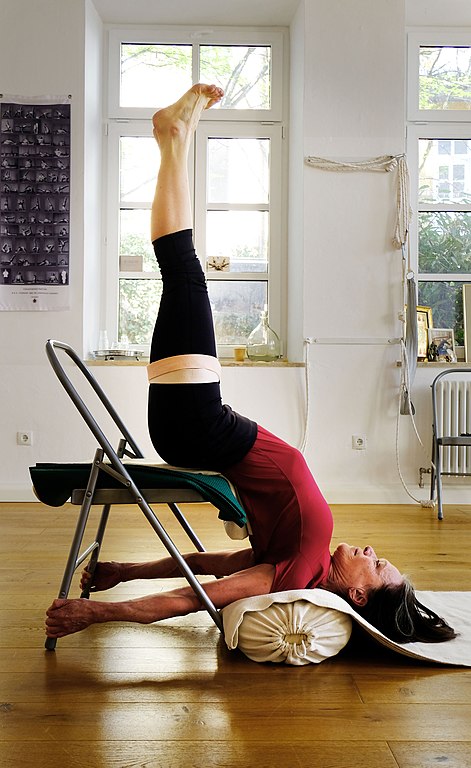
Image Credit: wikimedia
Sarvangasana, also known as the Shoulderstand Pose, is a popular yoga asanas that involves balancing the body on the shoulders while lifting the legs straight up towards the ceiling. This pose is considered a “Queen of Asanas,” as it offers numerous physical and mental benefits.
How do it?
- Lie on your back and lift your legs overhead.
- Support your lower back with your hands.
- Straighten your legs, bringing them over your head.
- Lift your hips toward the ceiling, coming into a shoulder stand.
- Keep your elbows close together and support your back with your hands.
- Hold the pose, breathing deeply and engaging your core.
Benefits of doing Sarvangasana
- Improves blood circulation and lymphatic drainage.
- Strengthens the shoulders and upper arms.
- Stimulates the thyroid and parathyroid glands.
- Calms the nervous system and reduces stress.
58. Samakonasana
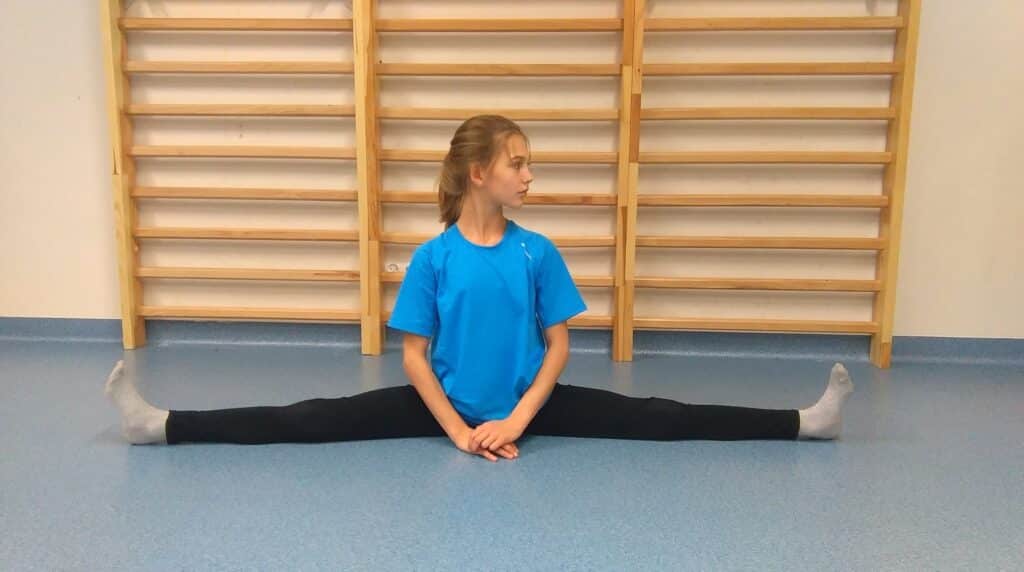
Image Credit: wikimedia
Samakonasana, also known as the Straddle or Split Pose, is an advanced yoga asanas that requires a lot of flexibility in the hamstrings and hips. It can help improve flexibility and strength in the legs and can also be beneficial for opening up the chest and shoulders. In yoga philosophy, this pose is believed to promote emotional balance and inner peace.
How do it?
- Sit on the floor with your legs spread wide.
- Inhale, lengthen the spine and exhale to hinge at the hips.
- Bring your hands to the floor between your legs.
- Keep your toes pointed upward and flex your feet.
- Hold the pose, feeling the stretch in the inner thighs.
Benefits of doing Samakonasana
- Stretches and strengthens the inner thighs.
- Improves flexibility in the hips and groin.
- Tones the abdominal muscles.
- Enhances overall leg strength and balance.
59. Shavasana
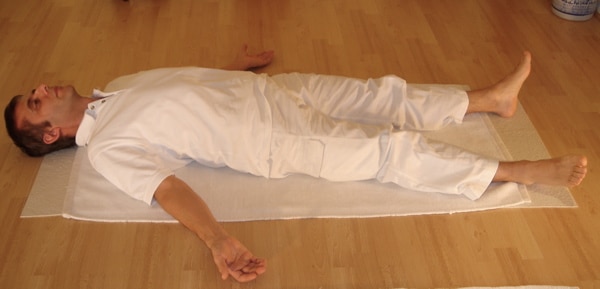
Image Credit: wikimedia
Shavasana, also known as the Corpse Pose, is a relaxation pose typically done at the end of a yoga practice. It involves lying flat on your back with your arms and legs extended and relaxed. This Sanskrit word translates to “corpse,” symbolizing the act of letting go and surrendering during this pose.
How do it?
- Lie on your back with your legs extended and arms by your sides.
- Close your eyes and focus on your breath.
- Allow your body to relax completely, releasing tension from head to toe.
- Stay in the pose for at least 5-10 minutes or as long as desired.
Benefits of doing Shavasana
- Promotes deep relaxation
- Calms the entire nervous system and reduces anxiety.
- Enhances self-awareness and mindfulness.
- Restores energy and improves overall well-being.
60. Setu Bandha Sarvangasana
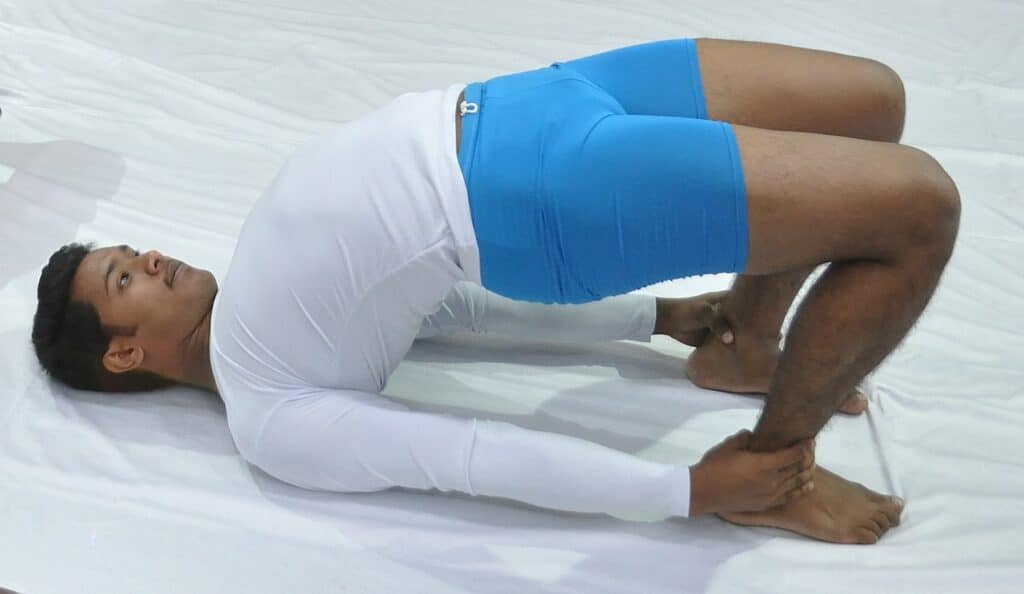
Image Credit: wikimedia
Setu Bandha Sarvangasana, also known as the Bridge Pose, is an invigorating backbend that can help open up the chest and shoulders while strengthening the legs and core. It is believed to promote better circulation, reduce stress and fatigue, and improve digestion. This pose can also be helpful in relieving mild back pain.
How do it?
- Lie on your back with your knees bent and feet hip-width apart.
- Press into your feet, lifting your hips toward the ceiling.
- Clasp your hands under your back and roll your shoulders under.
- Keep your neck relaxed and gaze toward your chest.
- Hold the pose, engaging your core and breathing deeply.
Benefits of doing Setu Bandha Sarvangasana
- Strengthens the legs, glutes, and lower back.
- Stretches the chest and shoulders.
- Improves spinal flexibility and posture.
- Stimulates the abdominal organs and thyroid gland.
61. Siddhasana
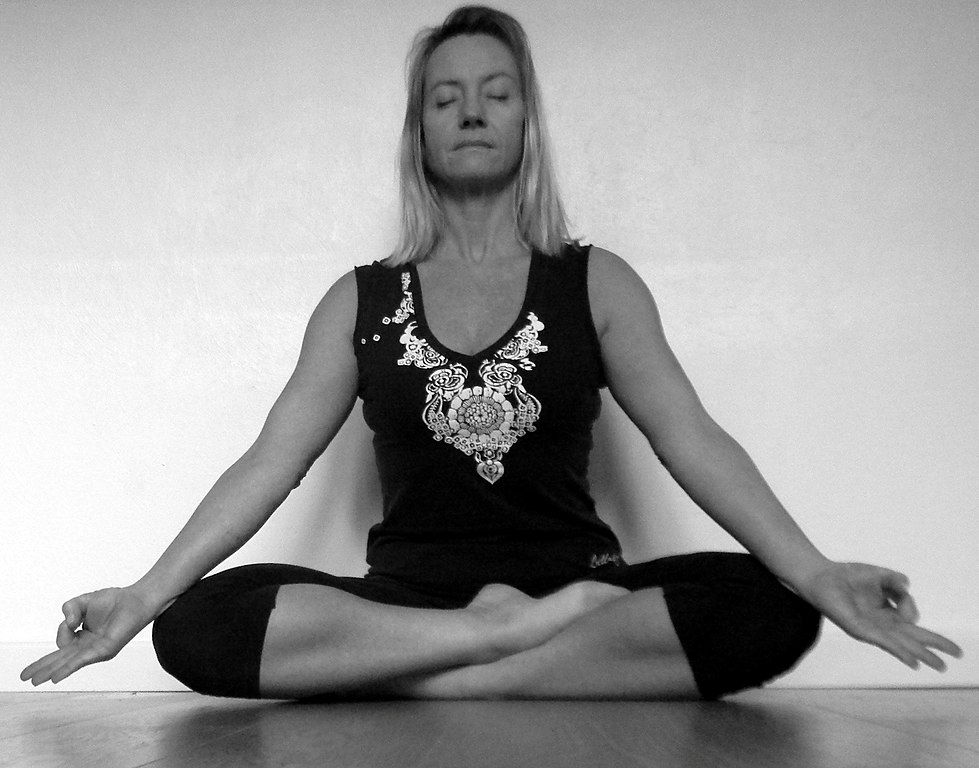
Image Credit: wikimedia
Siddhasana, also known as the Accomplished Pose, is a seated yoga asanas often used for meditation. It is a beginner-level pose involving deep flexion of the knees, ankles, glutes, and internal hip rotation. This pose is believed to balance energy flow and improve focus and concentration.
How do it?
- Begin by sitting on the ground with your legs extended in front of you.
- Cross your legs at the shins, bringing your feet towards your hips.
- Tuck one foot under the opposite leg, placing the heel near the groin area.
- Bring the other foot over the top of your first foot, placing the heel near the opposite hip.
- Keep your spine erect and rest your hands on your knees or in a mudra position.
Benefits of doing Siddhasana
- Promotes balance and focus
- Improves posture and alignment
- Opens up the hips and groin area
- Calms the mind and reduces stress
62. Simhasana
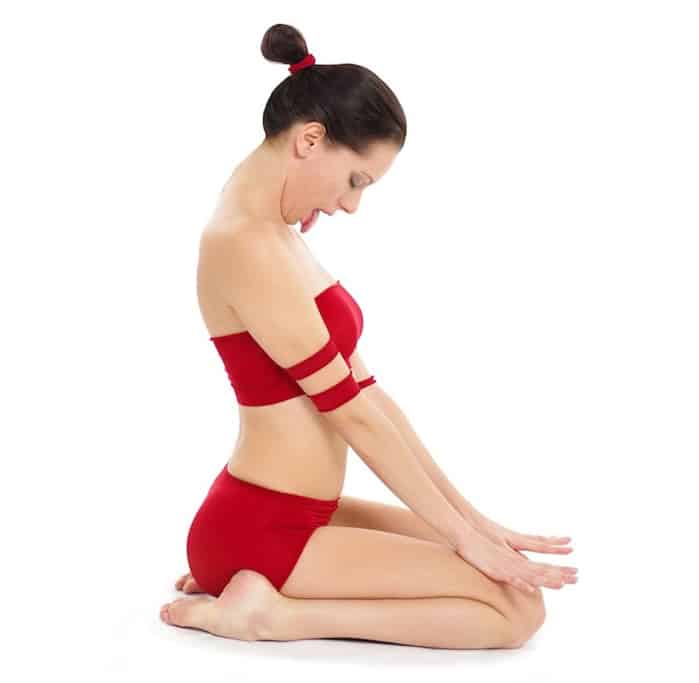
Image Credit: wikimedia
Simhasana, also known as the Lion’s Pose, is a seated yoga asanas that involves stretching and strengthening the face and throat muscles. This pose is believed to help alleviate stress and tension in these areas and promote relaxation. It is also said to stimulate the thyroid gland and boost metabolism.
How do it?
- Start in a comfortable cross-legged position.
- Place your hands on your knees.
- Inhale deeply through your nose.
- Exhale forcefully, opening your mouth wide and sticking out your tongue.
- Roar like a lion, creating a “ha” sound.
Benefits of doing Simhasana
- Relieves tension in the face and throat.
- Strengthens facial muscles.
- Improves vocal and respiratory health.
- Releases stress.
63. Shirshasana or Kapalasana
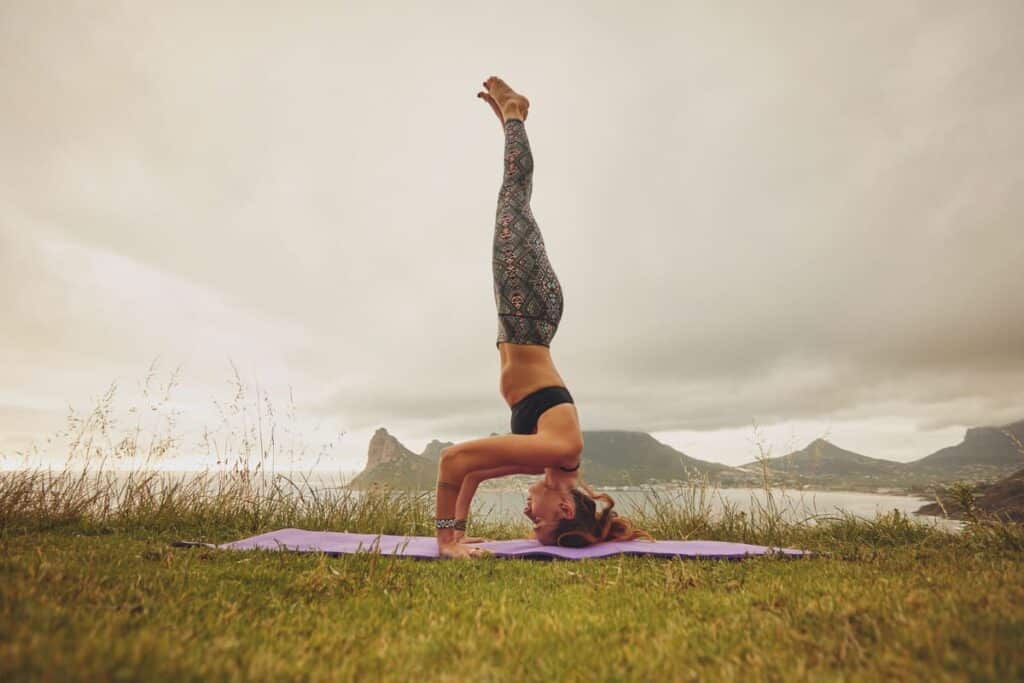
Shirshasana, also known as the Headstand or King of Asanas, is a challenging yoga asanas that requires immense strength and balance. The yoga Headstand pose derives from the words KAPAL, meaning “skull” or “cranium,” and ASANA, meaning “position.” This upside-down pose is often referred to as the “king” of all asanas due to its numerous physical and mental benefits.
How do it?
- Start in a kneeling position with interlocked fingers on the mat.
- Place the crown of your head on the mat, creating a tripod with hands.
- Lift your hips, straightening your legs.
- Slowly walk your feet closer to your head, forming a straight line.
- Engage core muscles for balance.
Benefits of doing Shirshasana or Kapalasana
- Increases blood flow to the brain.
- Strengthens shoulders, arms, and core.
- Stimulates the endocrine system.
- Enhances overall balance and stability.
64. Sukhasana
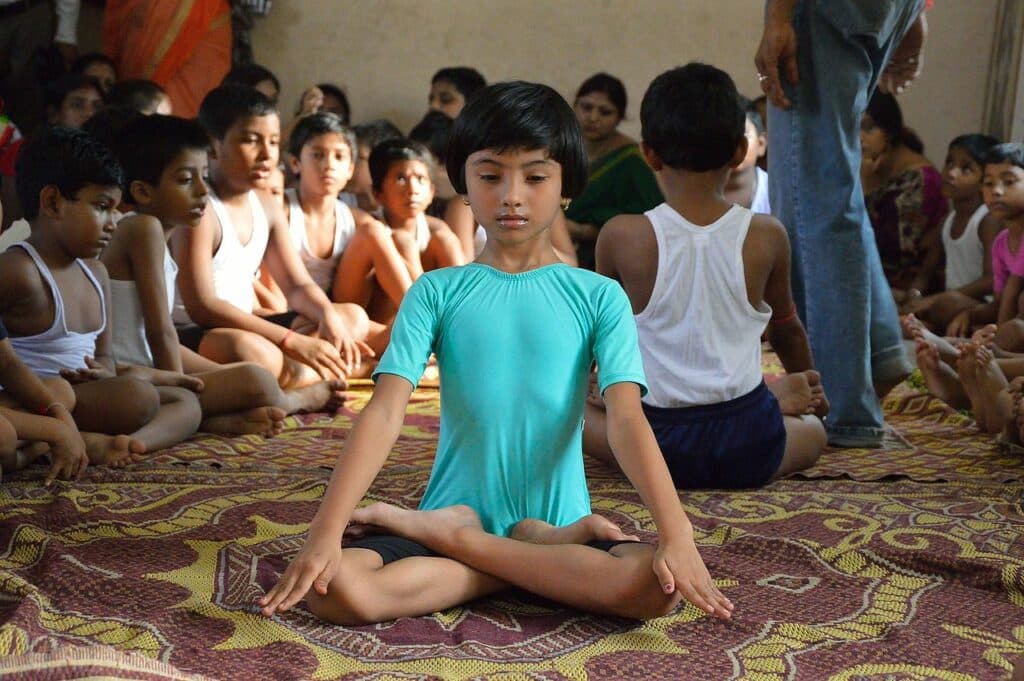
Image Credit: wikimedia
Sukhasana, also known as the Easy Pose or Comfortable Seat, is a simple cross-legged sitting pose that is often used for meditation and pranayama practices. This pose helps to calm the mind and improve focus and concentration. It can also help relieve tension in the hips, knees, and ankles.
How do it?
- Sit on the floor with legs crossed.
- Place hands on knees, palms facing up or down.
- Keep the spine straight and shoulders relaxed.
- Focus on your breath, finding comfort in stillness.
Benefits of doing Sukhasana
- Promotes a relaxed and grounded state of mind.
- Opens hips and lengthens the spine.
- Aids in maintaining good posture.
- Alleviates physical and mental fatigue.
65. Surya Namaskar
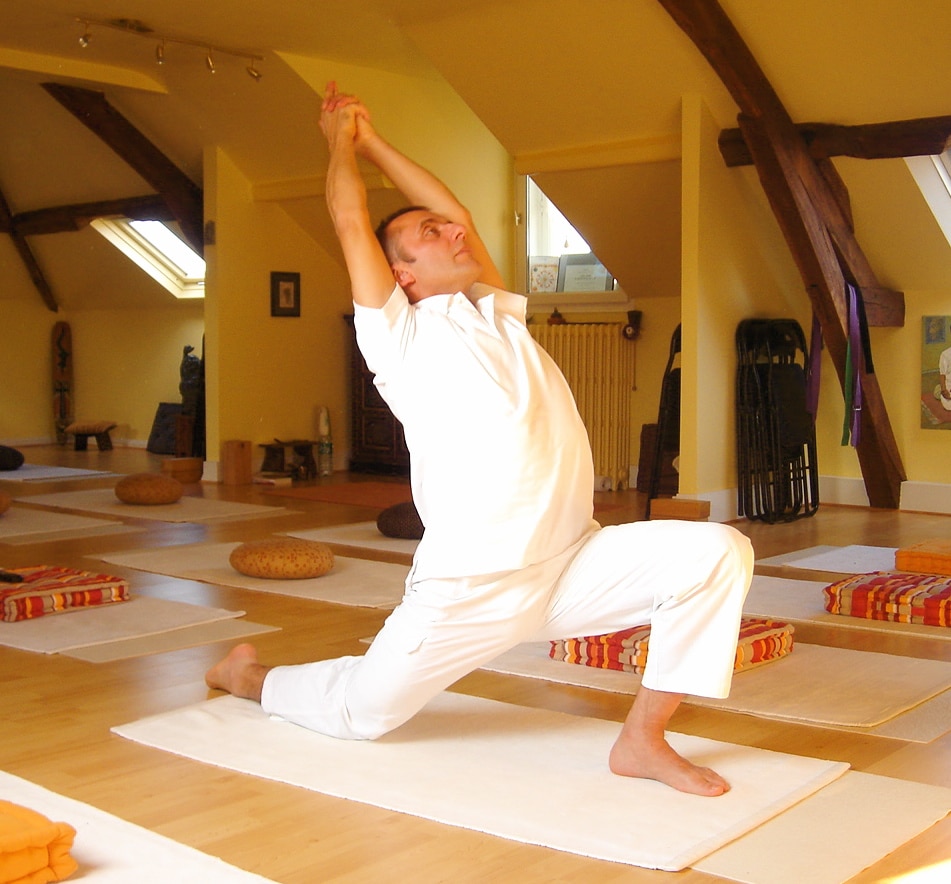
Image Credit: wikimedia
Surya Namaskar, also known as Sun Salutation, is a sequence of 12 yoga poses that are performed in a specific order. This practice is meant to be done in the morning as a way to greet and energize the sun. Each pose in this sequence has its own unique benefits and can help warm up the body for a more intense yoga practice.
How do it?
- Begin in Tadasana (Mountain Pose).
- Flow through a series of poses, including forward bends, lunges, and downward dog.
- Each movement is synchronized with the breath.
- Repeat the sequence, alternating sides.
Benefits of doing Surya Namaskar
- Improves flexibility and strength.
- Enhances cardiovascular health.
- Boosts metabolism and aids in weight management.
- Promotes mental clarity and focus.
66. Svastikasana

Image Credit: wikimedia
Svastikasana, also known as the Auspicious Pose or Easy Cross-Legged Pose, is a simple seated pose that can be practiced by people of all ages and levels. It is often used for meditation and pranayama practices, as it helps promote relaxation and calmness.
How do it?
- Sit with legs stretched out.
- Cross legs at the shins, bringing feet under opposite knees.
- Keep spine straight and hands on knees.
- Focus on steady breath and inner calm.
Benefits of doing Svastikasana
- Promotes a sense of grounding and stability.
- Stretches and strengthens the back.
- Improves concentration and focus.
- Alleviates discomfort in the lower back.
67. Tadasana
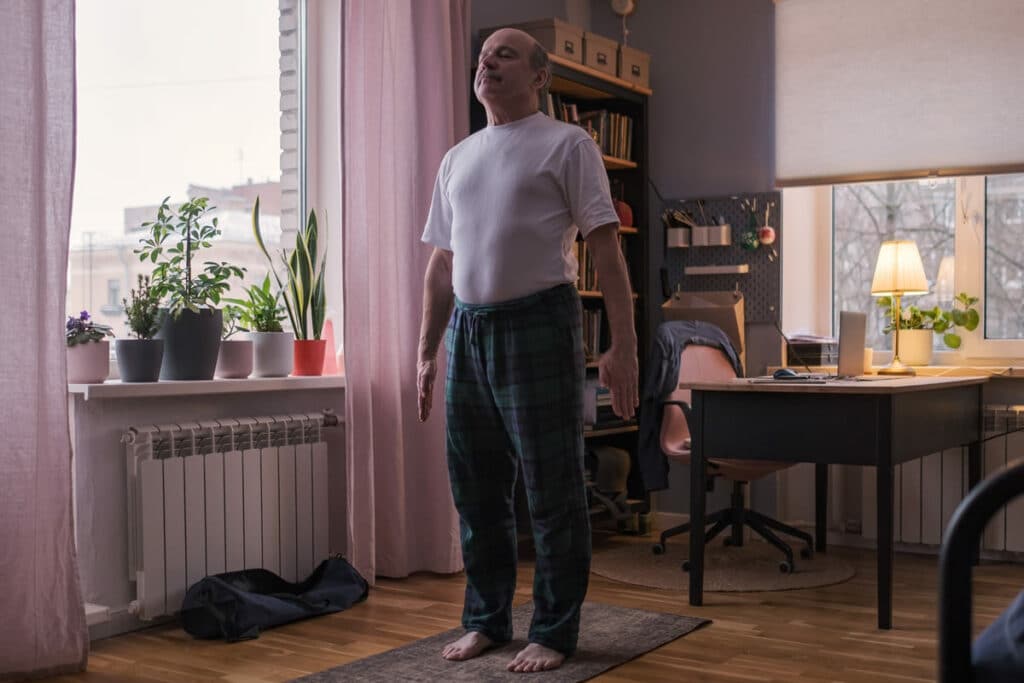
Tadasana, also known as Mountain Pose, is a foundational yoga asanas that focuses on proper alignment and grounding. Tadasana is derived from Sanskrit words, “tada” means mountain, and “asana” means pose. It may seem like a simple pose, but it requires a lot of focus and mindfulness to perform correctly.
How do it?
- Stand with your feet together, arms by your sides.
- Distribute weight evenly on both feet.
- Engage your thighs and lift your chest.
- Extend your arms overhead, palms facing each other.
- Lengthen your spine, reaching towards the sky.
- Hold the pose, grounding through your feet and breathing deeply.
Benefits of doing Tadasana
- Improves posture and body awareness.
- Strengthens the legs, ankles, and thighs.
- Increases lung capacity and deepens breathing.
- Promotes a sense of grounding and stability.
68. Tittibhasana
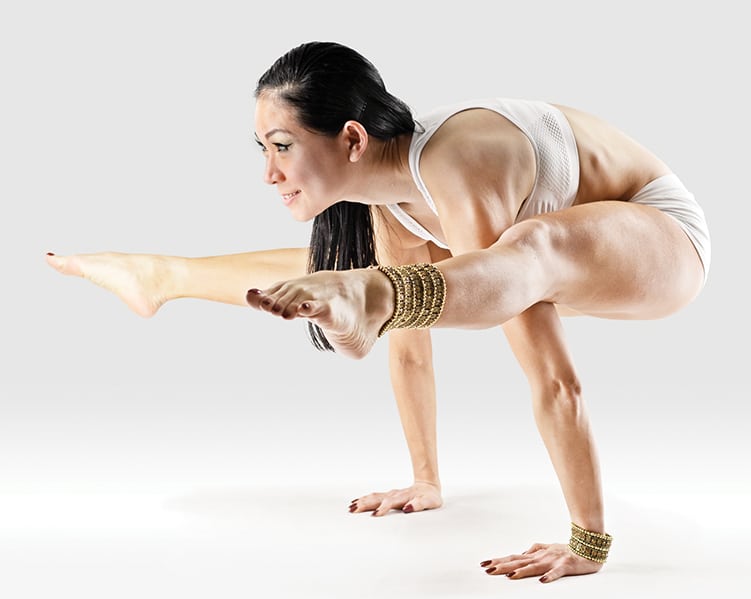
Image Credit: wikimedia
Tittibhasana, also known as the Firefly Pose, is an advanced arm-balancing yoga asanas that requires a great deal of core strength and endurance. This pose can help improve focus and concentration while also strengthening the arms, wrists, and core muscles. It can also help release tension in the shoulders and upper back.
How do it?
- Begin in a squat position with feet hip-width apart.
- Place your hands on the floor between your legs.
- Shift your weight forward, lifting your hips and straightening your legs.
- Hook your knees onto the backs of your upper arms.
- Extend your legs forward, parallel to the ground.
- Hold the pose, engaging the core and breathing deeply.
Benefits of doing Tittibhasana
- Strengthens the arms, wrists, and core.
- Stretches and opens the hips and groin.
- Improves balance and coordination.
- Builds mental focus and determination.
69. Trikonasana or Utthita Trikonasana
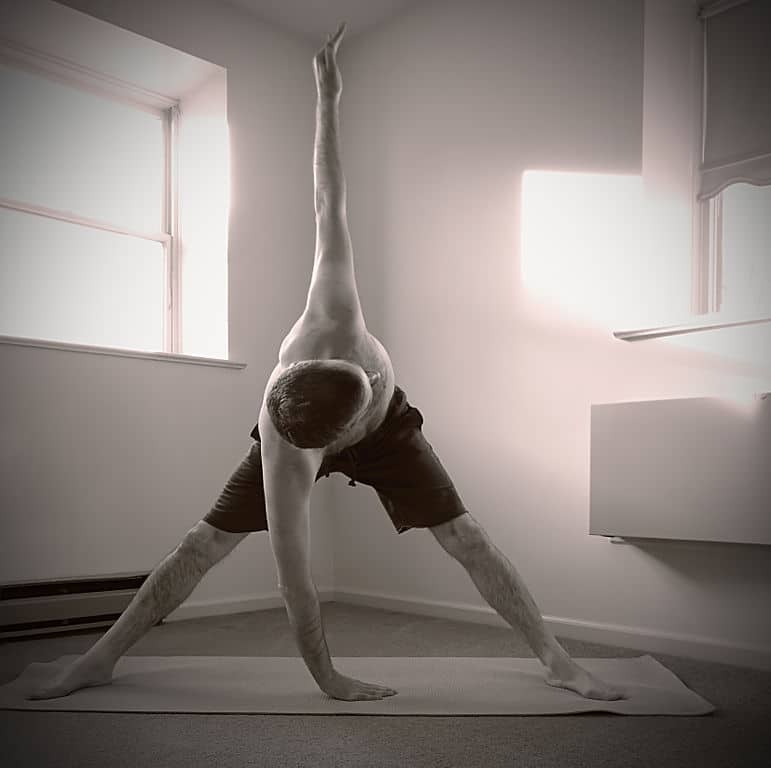
Image Credit: wikimedia
Trikonasana, also known as the Triangle Pose, is a standing pose that involves balancing and stretching the entire body. In Sanskrit, “tri” and “Kona” mean “three corners” or “three angles” and Utthita means “stretched.” This pose can help improve flexibility in the spine and legs, as well as strengthen the core muscles.
How do it?
- Start in a wide-legged stance with feet parallel.
- Turn one foot outward and extend the arms parallel to the ground.
- Inhale, reach toward the extended foot, keeping the spine long.
- Exhale, bringing the hand to the shin, foot, or the floor.
- Open the chest and gaze upward.
- Hold the pose, feeling the stretch in the side body.
Benefits of doing Trikonasana or Utthita Trikonasana
- Stretches and strengthens the legs and hips.
- Opens the chest and shoulders.
- Improves balance and coordination.
- Stimulates abdominal organs, aiding digestion.
70. Trivikramasana

Image Credit: wikimedia
Trivikramasana, also known as the Standing Splits or One-Legged Forward Fold, is an intermediate yoga pose that involves balancing on one leg while lifting the other leg straight up in the air. This pose requires a lot of flexibility and balance, making it a great challenge for experienced yogis.
How do it?
- Begin in a standing position with feet together.
- Shift your weight onto one leg and lift the other leg forward.
- Hold the lifted foot with both hands.
- Extend the lifted leg forward while keeping the spine straight.
- Hold the pose, engaging the core and breathing deeply.
- Release and switch to the other leg.
Benefits of doing Trivikramasana
- Strengthens the legs and ankles.
- Improves balance and focus.
- Stretches and opens the hip flexors.
- Enhances overall lower body flexibility.
71. Tulasana
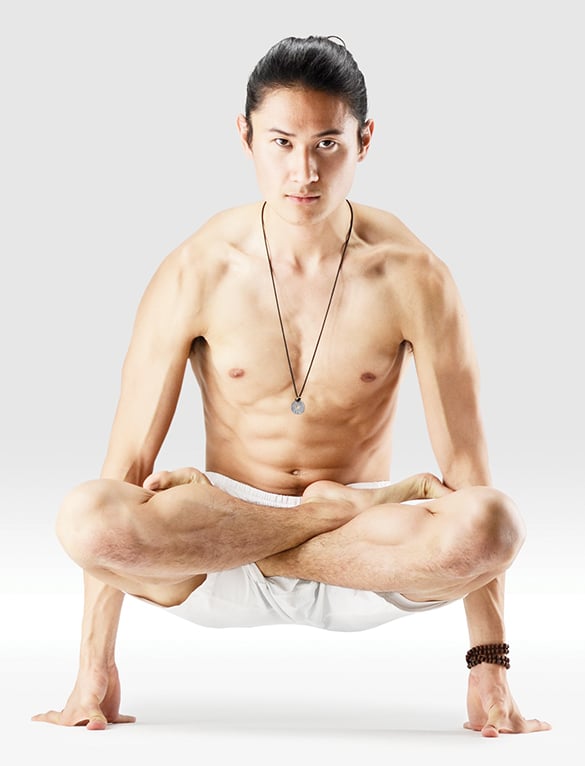
Image Credit: wikimedia
Tulasana, also known as the Scale Pose or Upward Lotus Pose, is an intermediate yoga asanas that involves balancing the entire body on the palms of your hands. This pose requires a lot of core strength and stability in the arms and shoulders.
How do it?
- Sit with your knees bent and feet on the floor.
- Place your hands on the floor beside your hips.
- Shift your weight onto your hands, lifting your feet off the ground.
- Straighten your legs, keeping them parallel to the ground.
- Engage your core and hold the pose, balancing on your hands.
Benefits of doing Tulasana
- Strengthens the arms, wrists, and core.
- Improves balance and coordination.
- Tones the abdominal muscles.
- Enhances overall upper body strength and control.
72. Upavishta Konasana
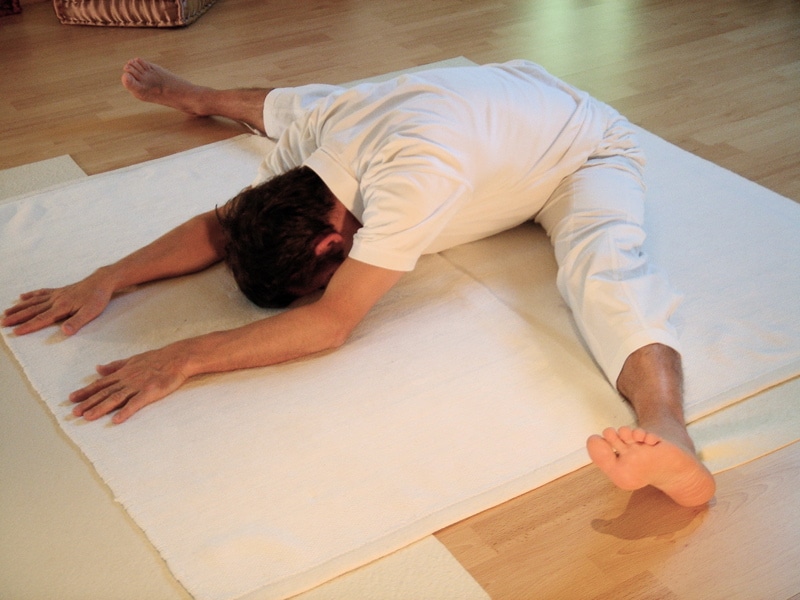
Image Credit: wikimedia
Upavishta Konasana, or Seated Wide-Legged Forward Bend, is a seated yoga asanas that stretches the inner thighs and groins. This asana involves sitting with the legs spread wide and folding forward from the hips.
How do it?
- Sit on the mat with your legs extended wide to the sides.
- Keep your toes pointing slightly inward.
- Inhale, lengthen your spine and engage your core.
- Exhale, hinge at the hips and reach forward with your hands.
- Hold onto your shins, ankles, or feet, depending on your flexibility.
- Keep your spine straight and breathe deeply.
Benefits of doing Upavishta Konasana
- Stretches and opens the hips and inner thighs.
- Improves flexibility in the hamstrings and lower back.
- Strengthens the spine.
- Calms the mind and relieves mild anxiety.
73. Urdhva Dhanurasana or Chakrasana
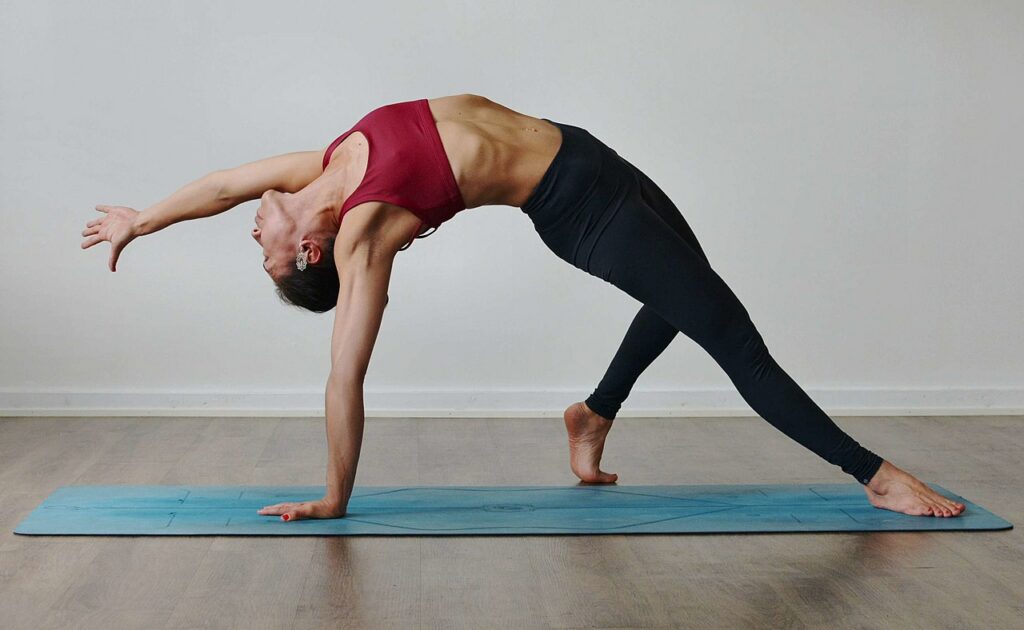
Image Credit: wikimedia
Urdhva Dhanurasana, also known as Upward Bow Pose or Chakrasana, is an energizing backbend that opens the chest and strengthens the arms and legs. This asana involves lying on the back, bending the arms, and lifting the body into a wheel shape.
How do it?
- Lie on your back with your knees bent, and feet hip-width apart.
- Place your hands beside your head, fingers pointing towards your shoulders.
- Inhale, press into your hands and feet, lifting your hips and chest.
- Straighten your arms and legs, creating a wheel shape.
- Hold the pose, engaging your core and breathing deeply.
Benefits of doing Urdhva Dhanurasana or Chakrasana
- Strengthens the arms, wrists, and legs.
- Opens and expands the chest and lungs.
- Stretches the hip flexors and abdomen.
- Energizes the body and improves posture.
74. Urdhva Mukha Shvanasana
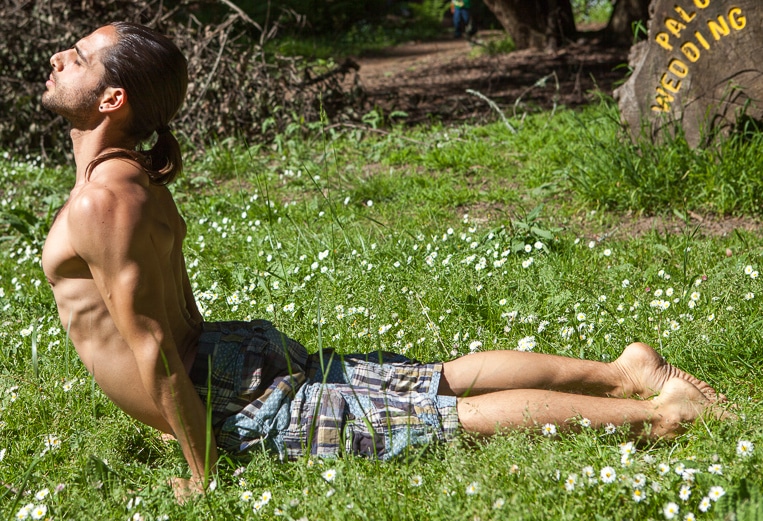
Image Credit: wikimedia
Urdhva Mukha Shvanasana, also known as Upward-Facing Dog Pose, is a backbend pose commonly used in Vinyasa and Ashtanga yoga practices. This pose can help improve spine flexibility and strengthen the arms and wrists. It is also believed to stimulate digestion and relieve stress and fatigue.
How do it?
- Start in a prone position with your palms beside your chest.
- Inhale, press into your hands and lift your chest and thighs off the mat.
- Roll your shoulders back, opening the chest.
- Keep your legs active and your toes pointed.
- Hold the pose, breathing deeply.
Benefits of doing Urdhva Mukha Shvanasana
- Strengthens the arms, wrists, and spine.
- Stretches and opens the chest and lungs.
- Improves posture and alleviates mild back pain.
- Stimulates abdominal organs and aids digestion.
75. Ushtrasana
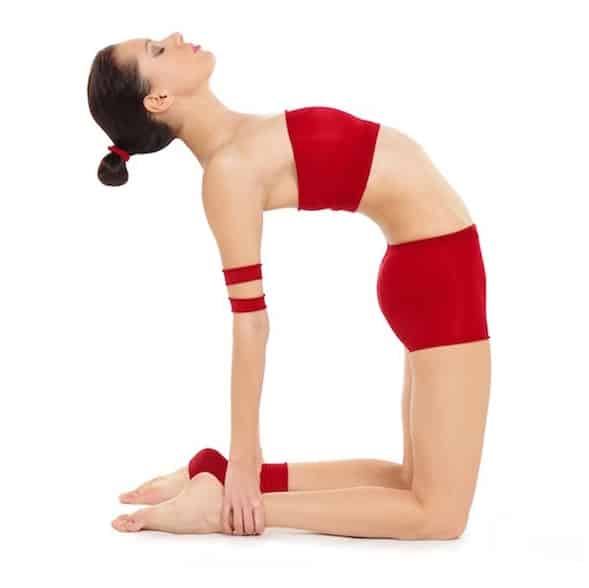
Image Credit: wikimedia
Ushtrasana, also known as the Camel Pose, is an intermediate-level backbend pose that can help improve flexibility in the spine and strengthen the back muscles. This is derived from the Sanskrit word “Ushtra” meaning camel, and “Asana” means pose. The pose is named for its resemblance to a camel’s body.
How do it?
- Kneel on the mat with your knees hip-width apart.
- Place your hands on your lower back, fingers pointing downward.
- Inhale, lift your chest and arch your back.
- Reach back, placing your hands on your heels.
- Keep your neck in a neutral position or drop it gently backward.
- Hold the pose, breathing deeply.
Benefits of doing Ushtrasana
- Stretches and opens the chest and shoulders.
- Strengthens the back muscles and spine.
- Stimulates the organs in the abdomen.
- Improves posture and flexibility.
76. Vajrasana
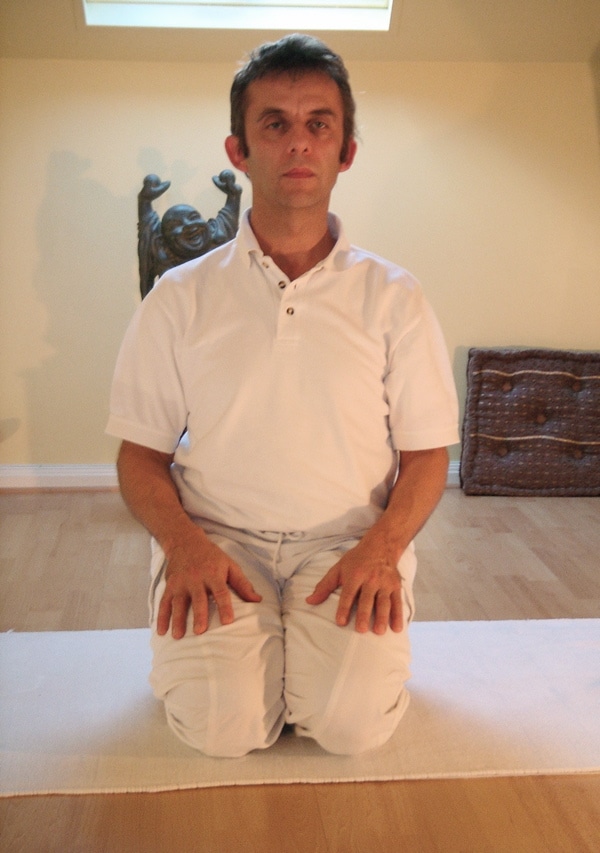
Image Credit: wikimedia
Vajrasana, also known as the Thunderbolt Pose or Diamond Pose, is a seated posture that is commonly practiced after meals to aid in digestion. This pose can also help improve posture and strengthen the muscles in the legs and back.
How do it?
- Kneel on the mat with your knees together.
- Sit back on your heels, keeping your spine straight.
- Place your hands on your thighs or knees.
- Close your eyes and focus on your breath.
- Hold the pose, breathing deeply.
Benefits of doing Vajrasana
- Improves digestion and aids in relieving acidity.
- Strengthens the muscles of the thighs and calves.
- Promotes a meditative and grounded state.
- Alleviates stiffness in the lower back.
77. Vasishtasana
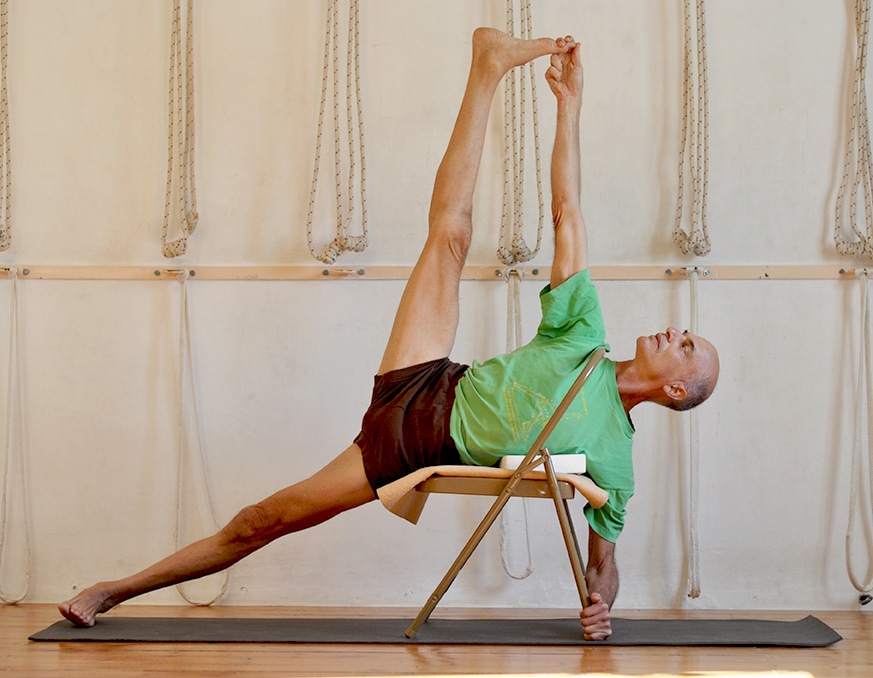
Image Credit: wikimedia
Vasishtasana, or Side Plank Pose, is an intermediate yoga pose that requires a lot of core strength and balance. This pose derived its name from a sage, Vasishta, who is said to have spread the teachings of yoga. Along with building strength in the arms, legs, and core, this pose also helps improve focus and concentration.
How do it?
- Begin in Plank Pose with your wrists directly under your shoulders.
- Shift your weight onto your right hand and the outer edge of your right foot.
- Stack your left foot on top of the right and extend your left arm upward.
- Keep your body in a straight line and engage your core.
- Hold the pose, breathing deeply.
- Repeat on the other side.
Benefits of doing Vasishtasana
- Strengthens the arms, shoulders, and core.
- Improves balance and concentration.
- Stretches the wrists, legs, and side body.
- Tones and stimulates abdominal organs.
78. Viparita Dandasana
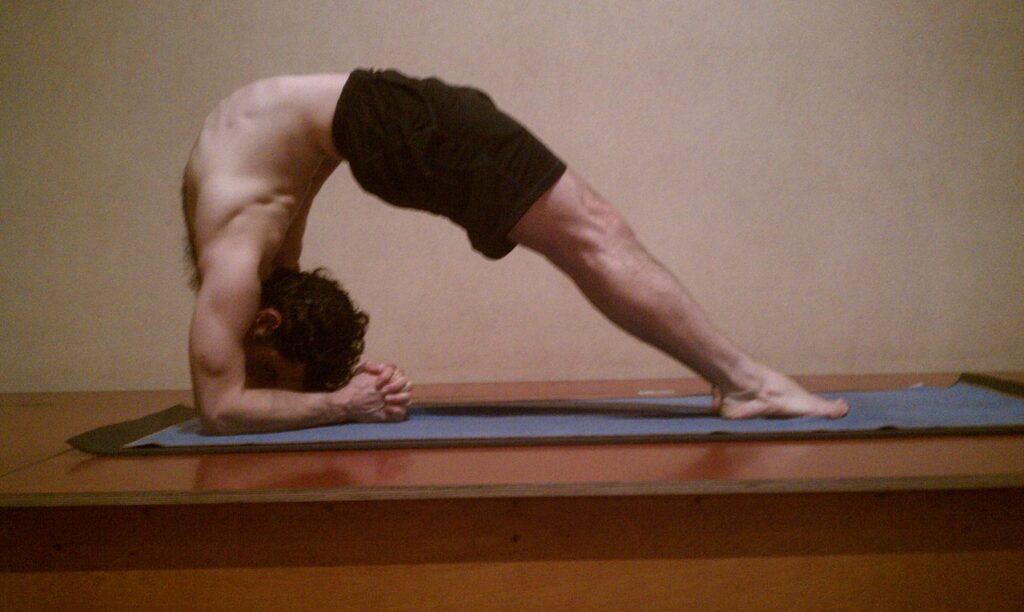
Image Credit: wikimedia
Viparita Dandasana, or Inverted Staff Pose, is an advanced backbend that combines a backbend with an inversion. Viparita means reversed, Dandasana means staff, and Asana means pose. This asana involves lying on the back, lifting the legs over the head, and placing the hands on the mat above the head.
How do it?
- Lie on your back with your legs extended.
- Place your hands on the mat above your head, fingers pointing towards your feet.
- Inhale, lift your legs over your head, and bring your feet towards the floor.
- Arch your back and place the crown of your head on the mat.
- Hold the pose, breathing deeply.
Benefits of doing Viparita Dandasana
- Strengthens the arms, shoulders, and spine.
- Stretches and opens the chest and shoulders.
- Improves posture and flexibility.
- Stimulates the thyroid gland and enhances energy flow.
79. Viparita Virabhadrasana
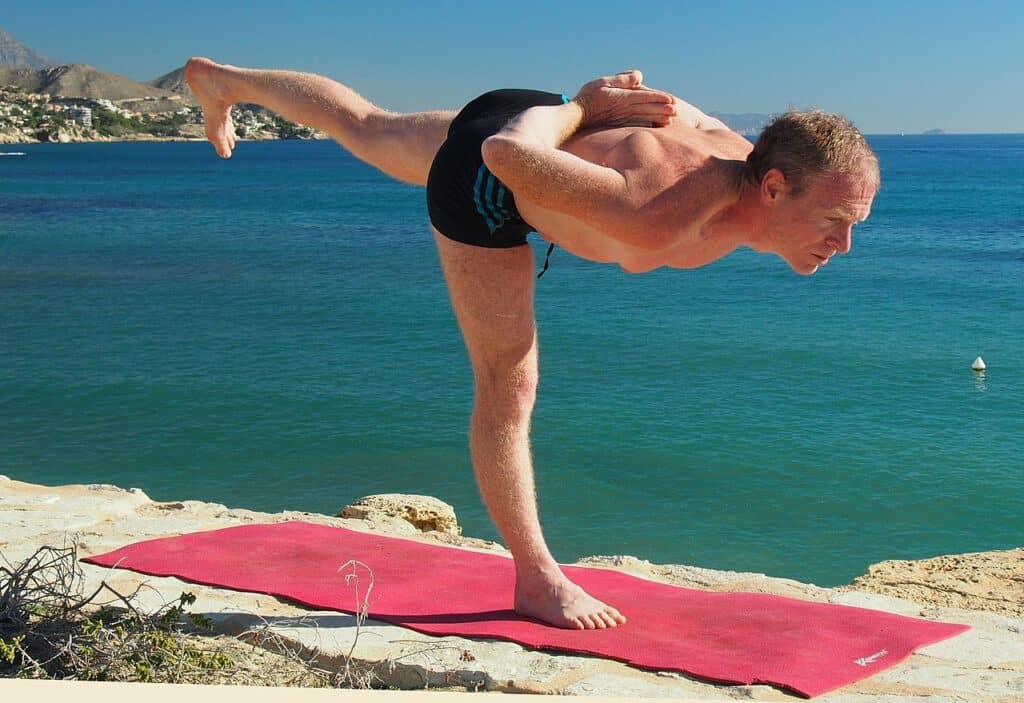
Image Credit: wikimedia
Viparita Virabhadrasana, also known as the Reverse Warrior Pose, is a standing yoga posture that involves stretching the entire body while building strength in the legs. This pose can help improve flexibility and balance while also stimulating digestion and energizing the body.
How do it?
- Start in Warrior II with your right foot forward.
- Inhale, extend your right arm overhead, palm facing down.
- Slide your left hand down the back leg, reaching towards the ankle.
- Keep the right knee bent, maintaining a strong foundation through the legs.
- Gaze towards the extended hand or upward.
Benefits of doing Viparita Virabhadrasana
- Stretches and strengthens the side body.
- Improves flexibility in the spine.
- Engages and tones leg muscles.
- Enhances lung capacity and deepens breathing.
80. Virabhadrasana I
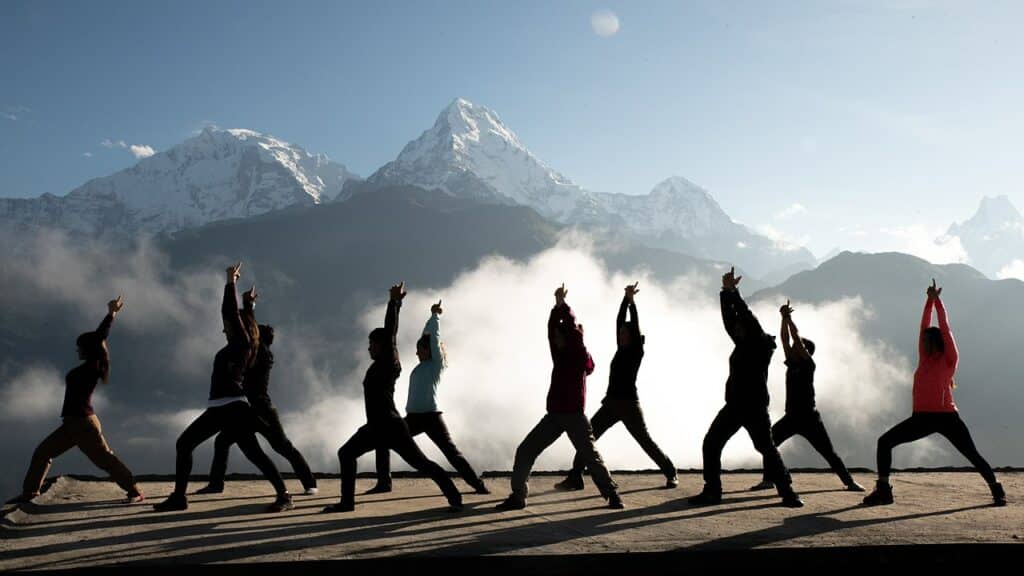
Image Credit: wikimedia
Virabhadrasana I, also known as Warrior I Pose, is a standing pose that requires balance and stability. This pose can help increase strength in the legs, arms, and core while improving posture and focus. It is also believed to promote courage and inner strength.
How do it?
- Begin in Tadasana (Mountain Pose).
- Step your left foot back, keeping it at a 45-degree angle.
- Bend your right knee over the ankle.
- Extend your arms overhead, palms facing each other.
- Square hips to the front and gaze forward.
Benefits of doing Virabhadrasana I
- Strengthens legs, arms, and core.
- Improves balance and stability.
- Stretches the chest and lungs.
- Enhances focus and concentration.
81. Virabhadrasana II
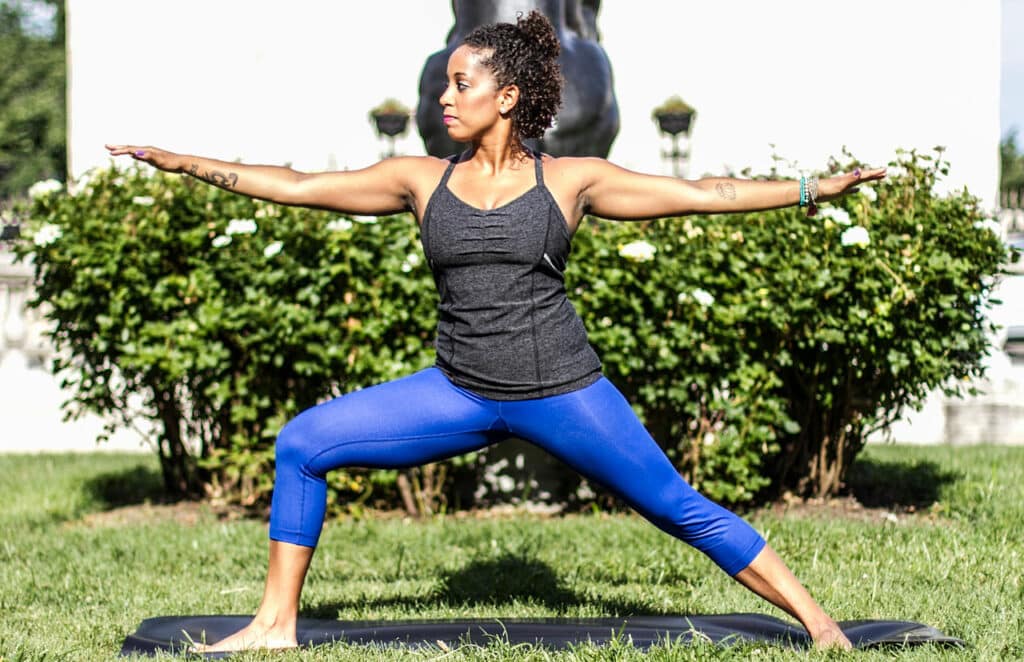
Image Credit: wikimedia
Virabhadrasana II, also known as Warrior II Pose, is a powerful standing pose that is believed to help build strength and stamina. It can also improve balance and focus while stretching the legs, hips, and chest. This pose is also considered to have a grounding effect on the mind and body.
How do it?
- From Warrior I, open hips and shoulders to the side.
- Extend arms parallel to the floor, palms facing down.
- Keep the front knee bent, aligning it over the ankle.
- Gaze over the front fingertips, maintaining a strong stance.
Benefits of doing Virabhadrasana II
- Strengthens legs and tones muscles.
- Opens hips and chest.
- Enhances endurance and focus.
- Improves circulation and respiratory function.
82. Virabhadrasana III
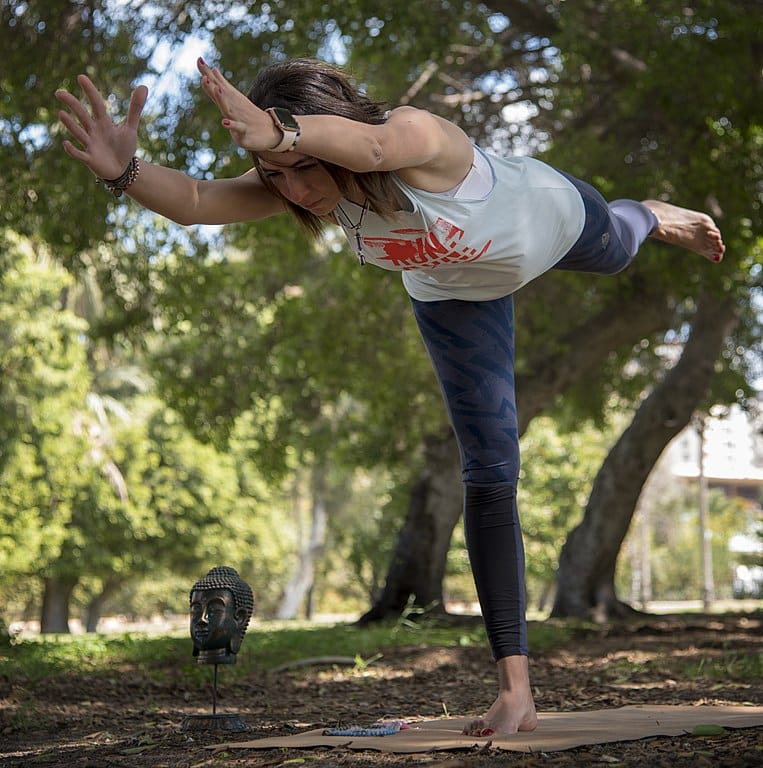
Image Credit: wikimedia
Virabhadrasana III, also known as Warrior III Pose, is an intermediate yoga pose that requires balance and stability. This pose helps to strengthen the legs, improve posture, and increase body awareness. The standing balance in this pose also requires focus and concentration, making it a great way to calm the mind and relieve stress.
How do it?
- Begin in Warrior I.
- Shift weight onto the front foot.
- Hinge at the hips, extending the back leg straight behind.
- Lower the torso, creating a straight line from head to heel.
- Extend arms forward or alongside the body.
Benefits of doing Virabhadrasana III
- Strengthens the entire back side of the body.
- Improves balance and posture.
- Tones core muscles.
- Enhances focus and mental clarity.
83. Vrikshasana
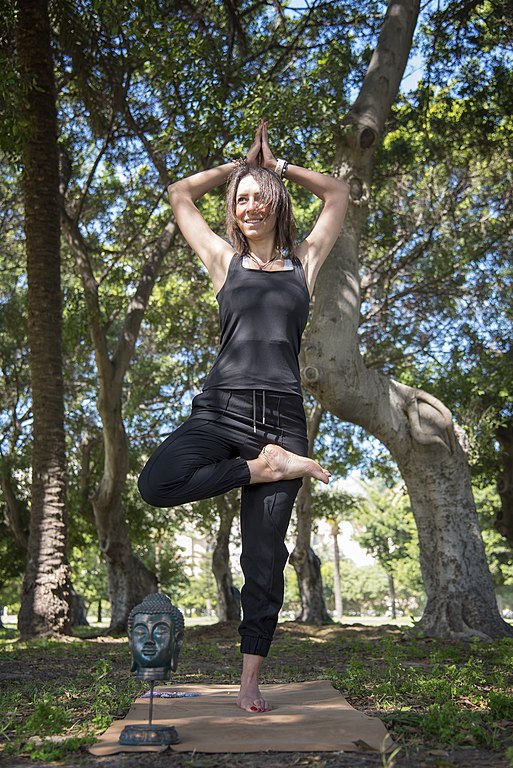
Image Credit: wikimedia
Vrikshasana, also known as the Tree Pose, is a standing balance pose that requires focus and concentration. This pose can help improve balance and stability while also strengthening the legs and core muscles. In yoga philosophy, this pose is believed to bring harmony between the mind, body, and spirit.
How do it?
- Begin in Tadasana.
- Shift weight to one leg and lift the other foot.
- Place the sole of the lifted foot on the inner thigh or calf (avoid the knee).
- Bring hands to prayer position or extend arms overhead.
- Find a focal point to aid balance.
Benefits of doing Vrikshasana
- Improves balance and stability.
- Strengthens legs, ankles, and feet.
- Enhances focus and concentration.
- Opens hips and stretches inner thighs.
84. Yoganidrasana or Pasini Mudra
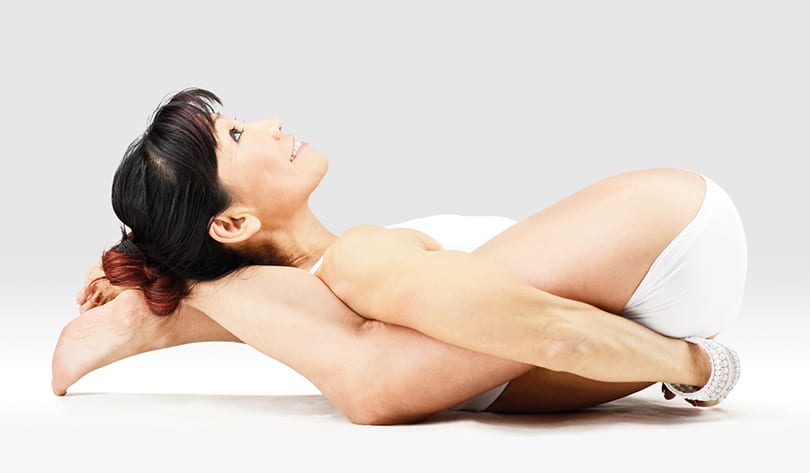
Image Credit: wikimedia
Yoganidrasana, also known as the Yoga Sleep Pose or “The Tension-Releasing Pose,” is a seated forward bend that involves wrapping one leg around your neck while resting your forehead on your knee. This advanced yoga pose requires flexibility in the hips and hamstrings, making it an effective stretch for the entire body.
How do it?
- Lie on your back with legs extended.
- Bend one knee and draw it towards the chest.
- Clasp hands around the shin or calf.
- Straighten the opposite leg along the floor.
- Repeat on the other side.
Benefits of doing Yoganidrasana or Pasini Mudra
- Stretches and releases tension in the lower back and hamstrings.
- Improves flexibility in the hips and thighs.
- Calms the nervous system, promoting relaxation.
- Aids in relieving mild back pain and discomfort.
The Bottom Line
To sum it up, yoga poses or asanas offer a wide range of benefits for the body, mind, and spirit. Through regular practice, one can experience improved flexibility, strength, balance, focus, and overall well-being. Each pose has its own unique characteristics and benefits, making it essential to try different asanas to find what works best for your body and goals!

